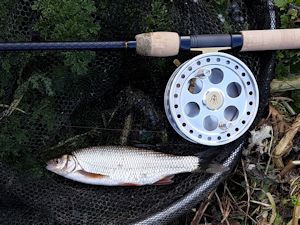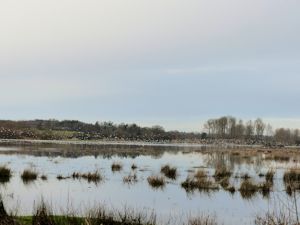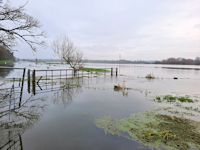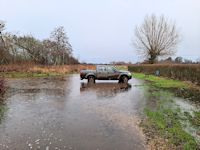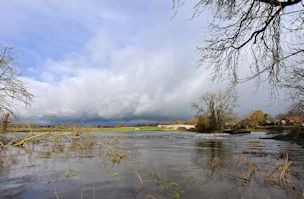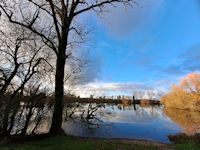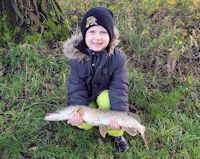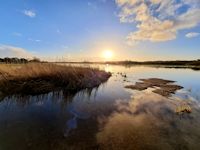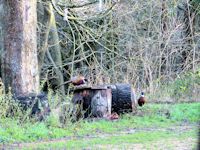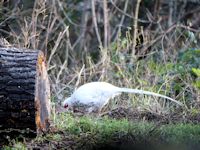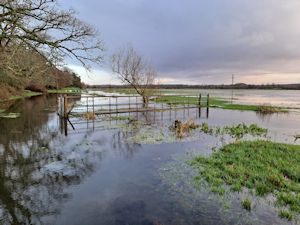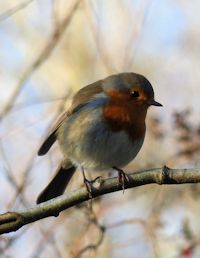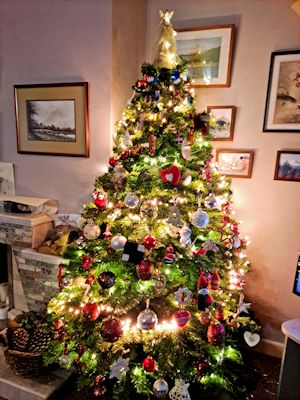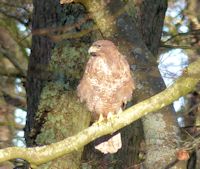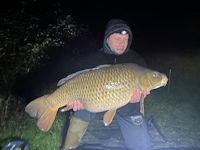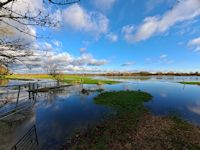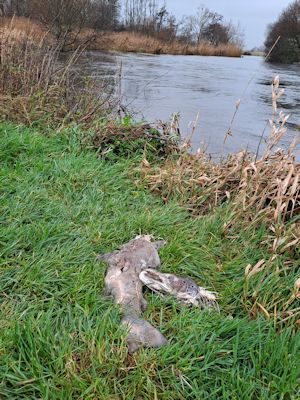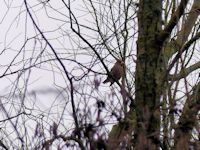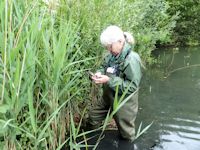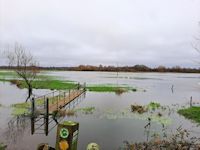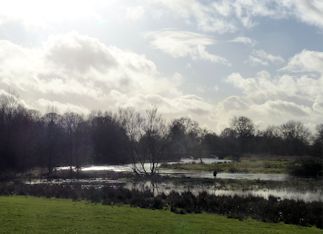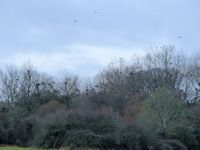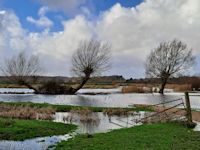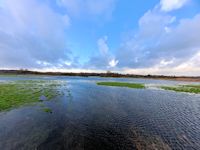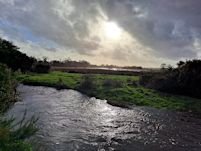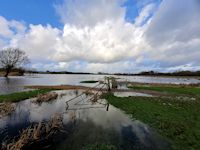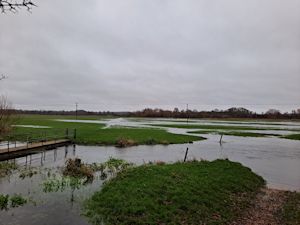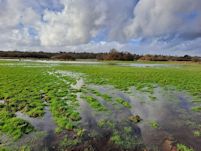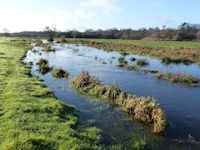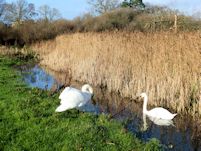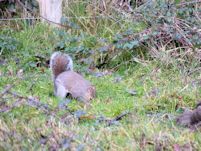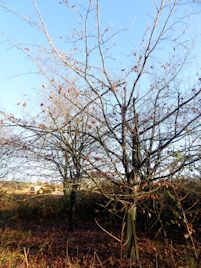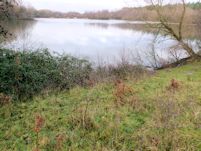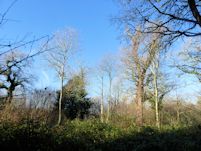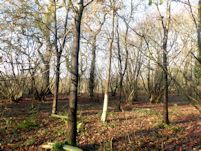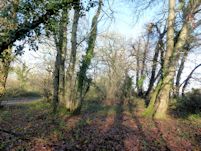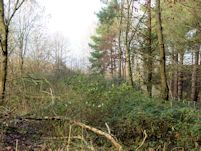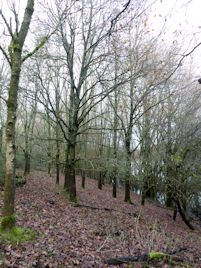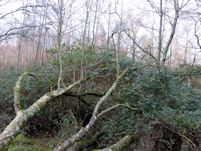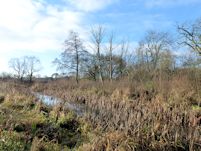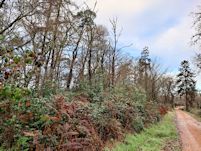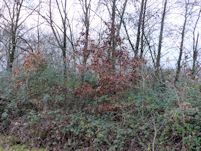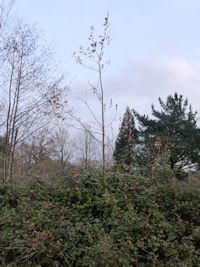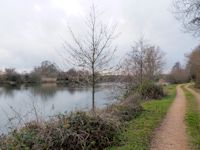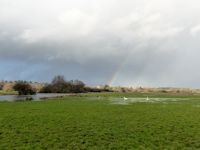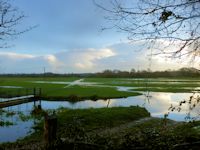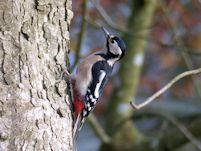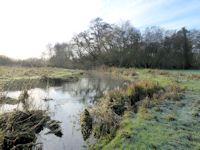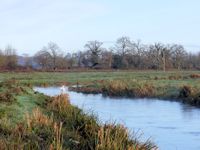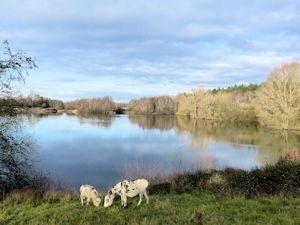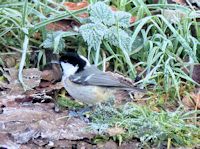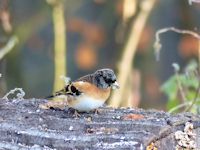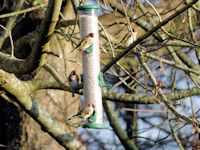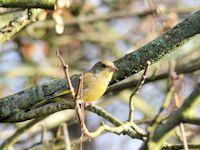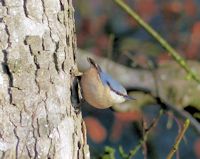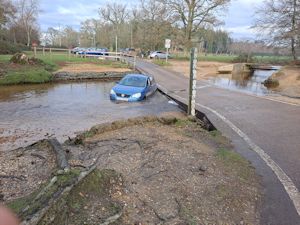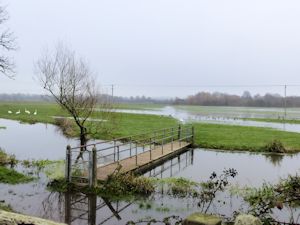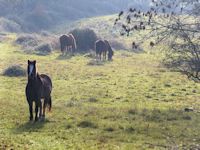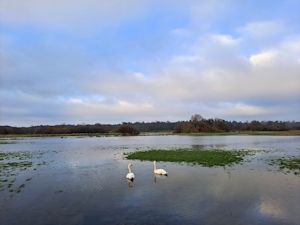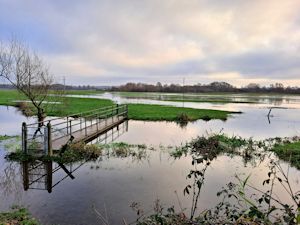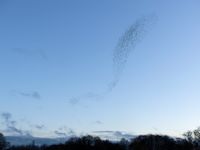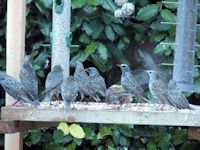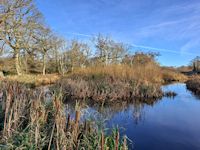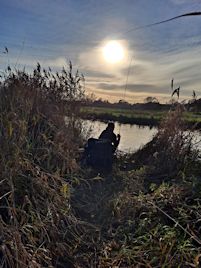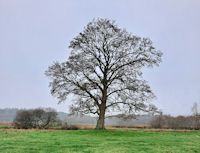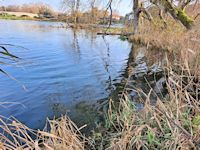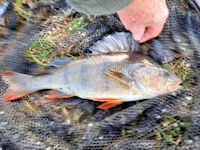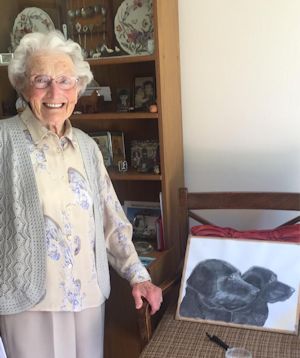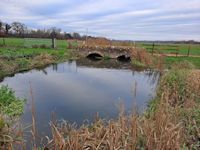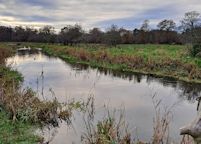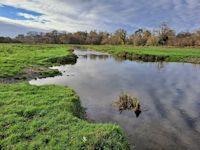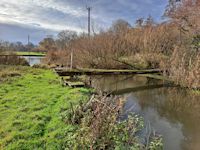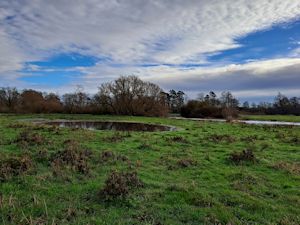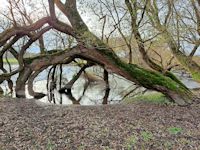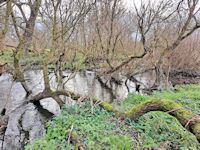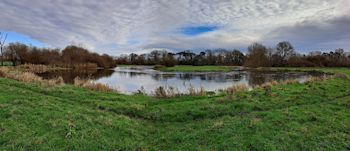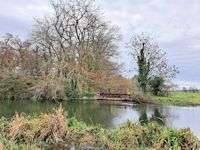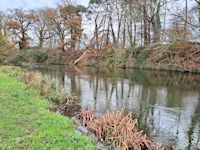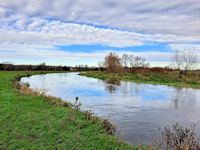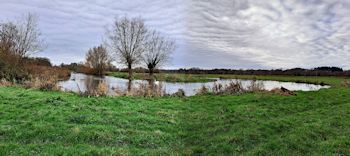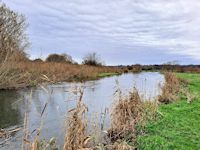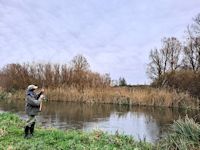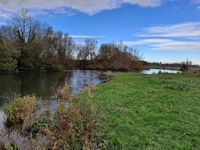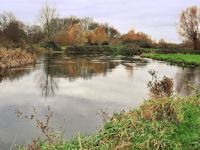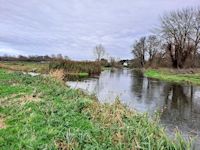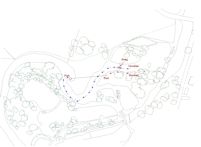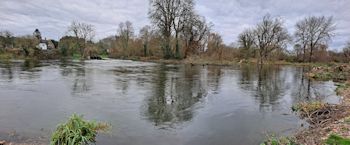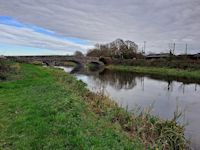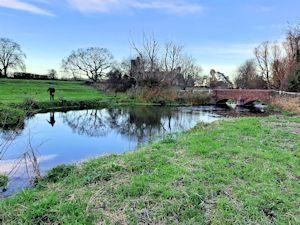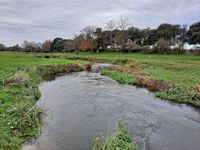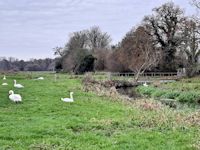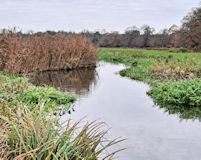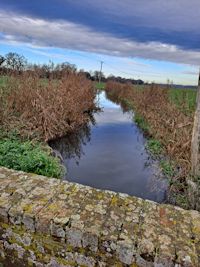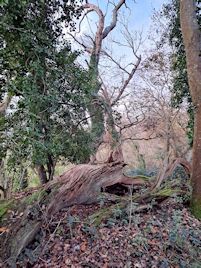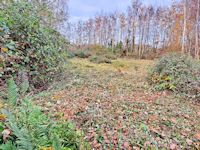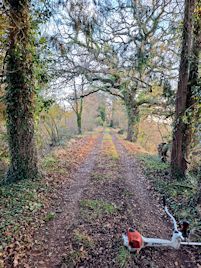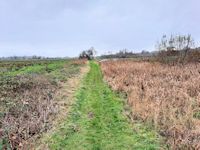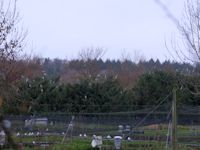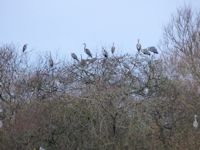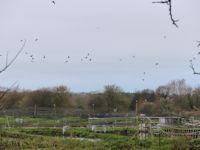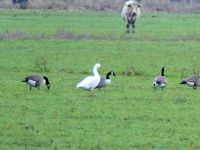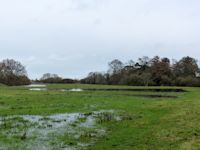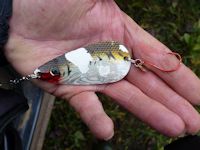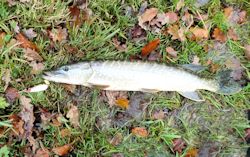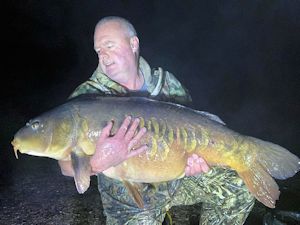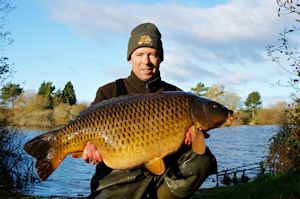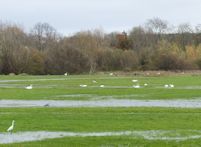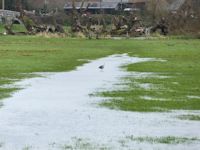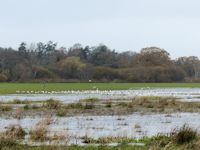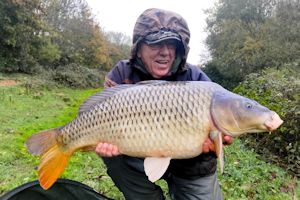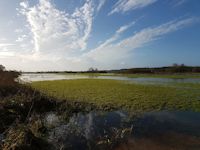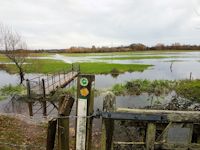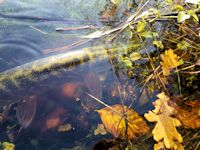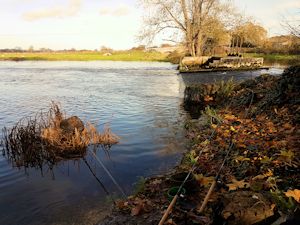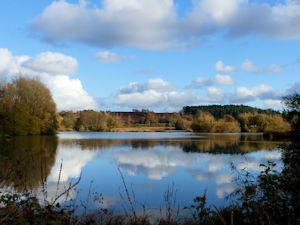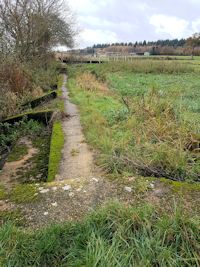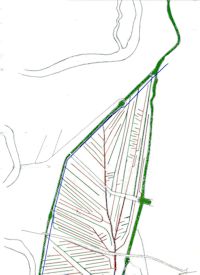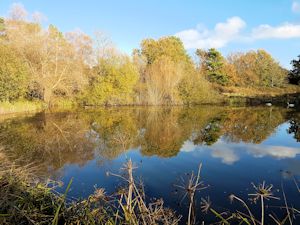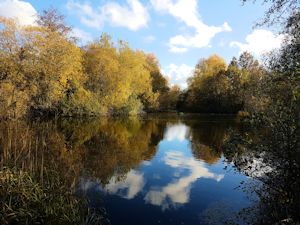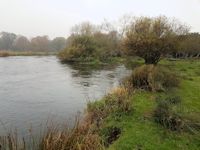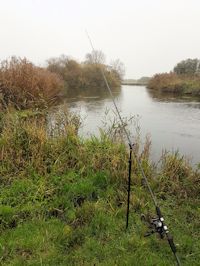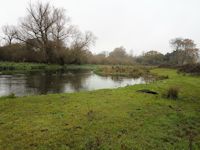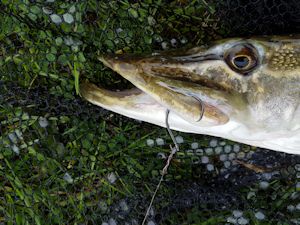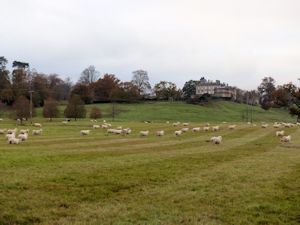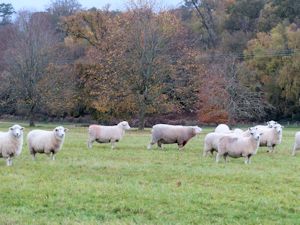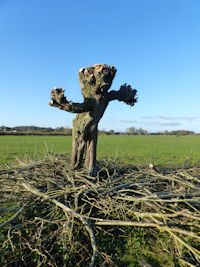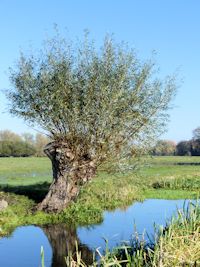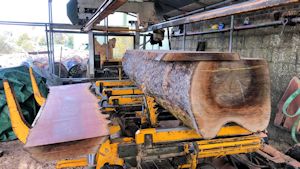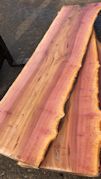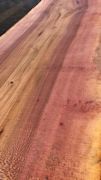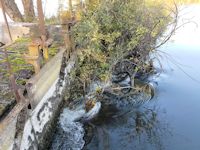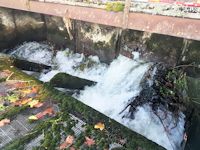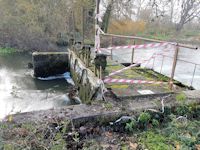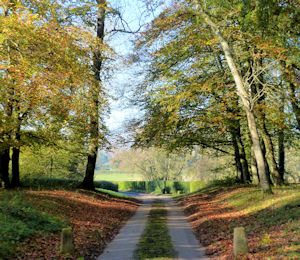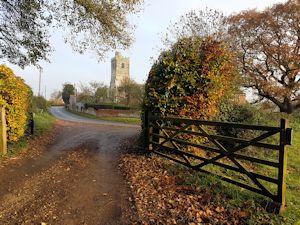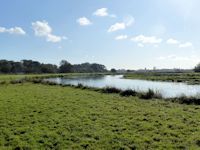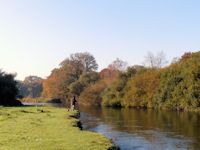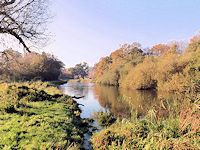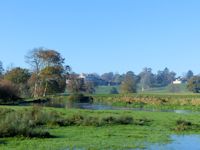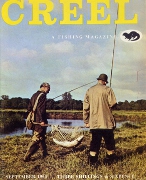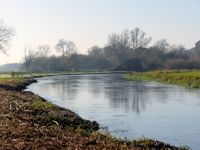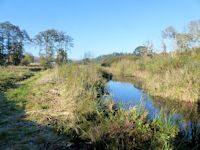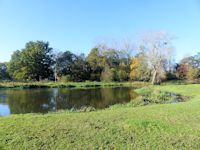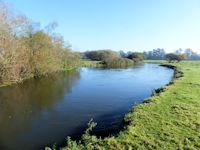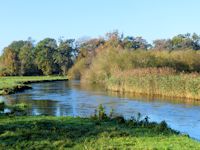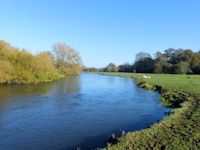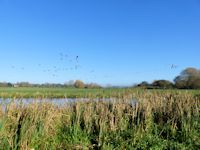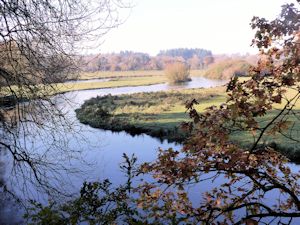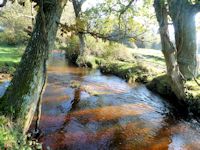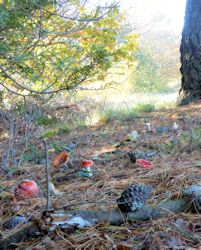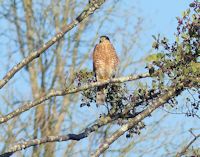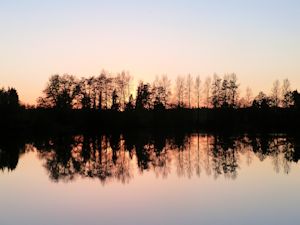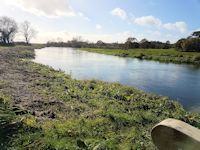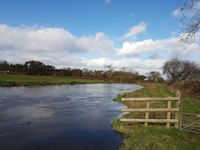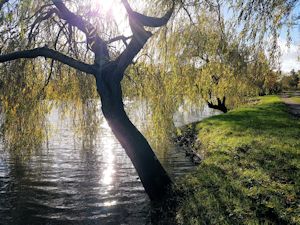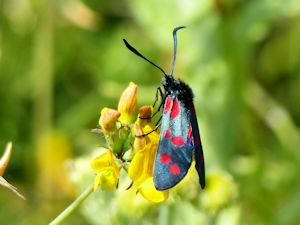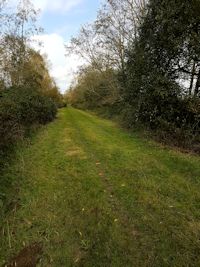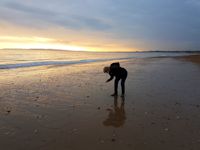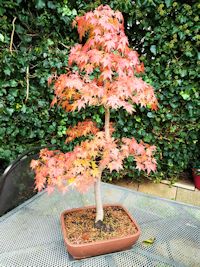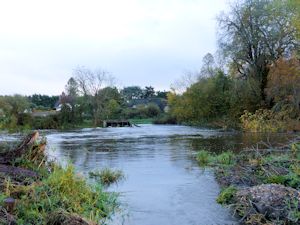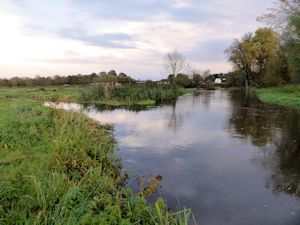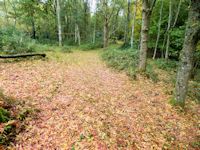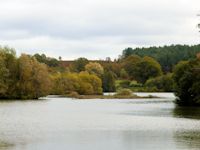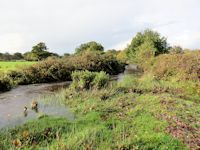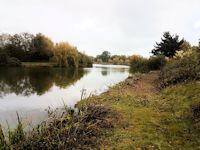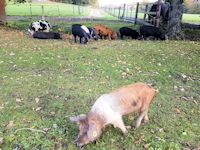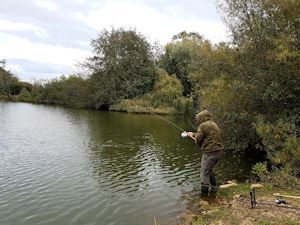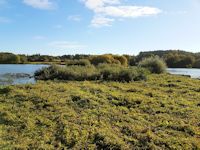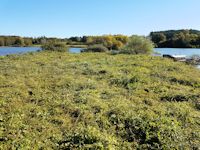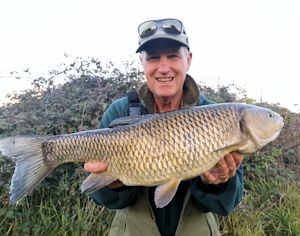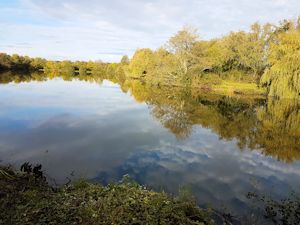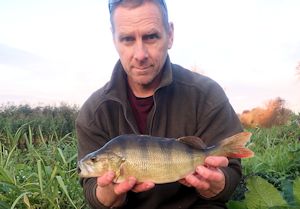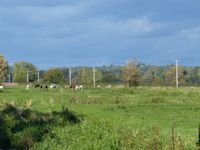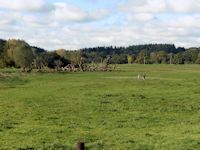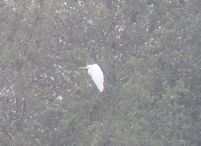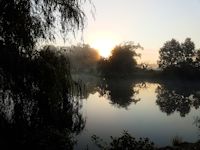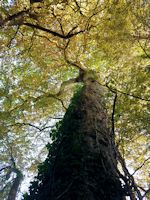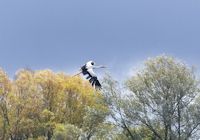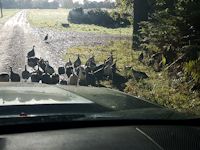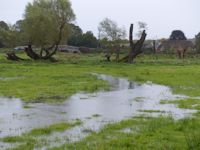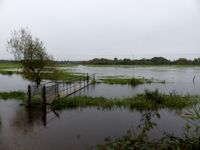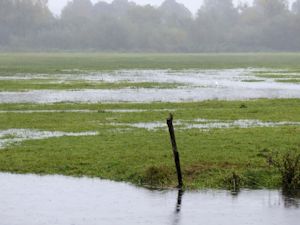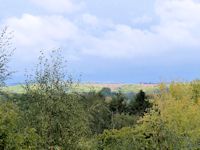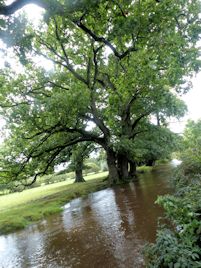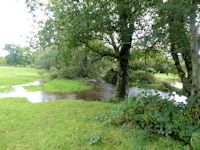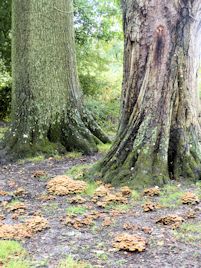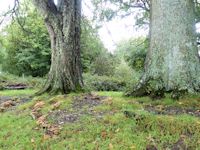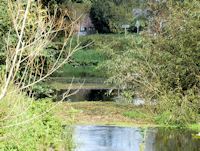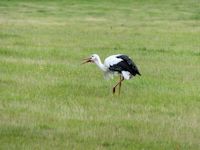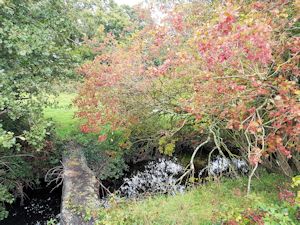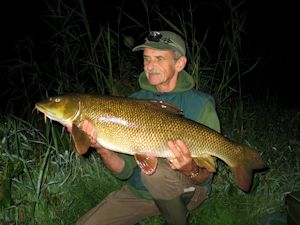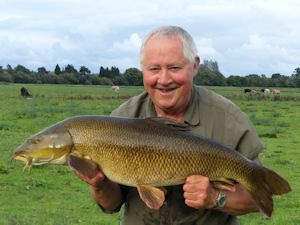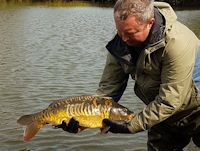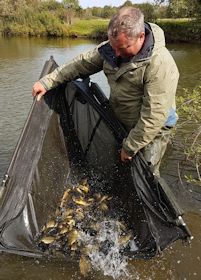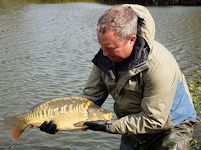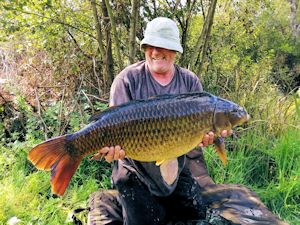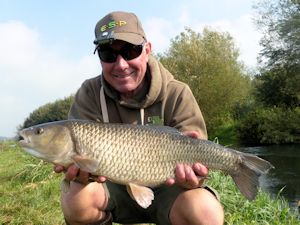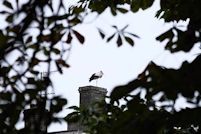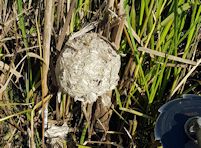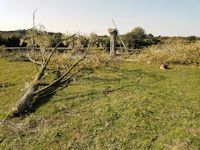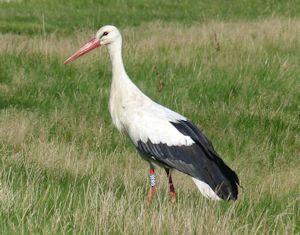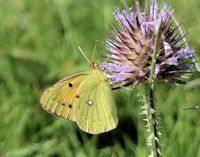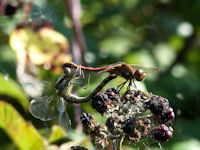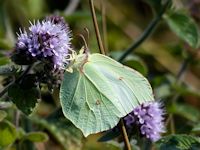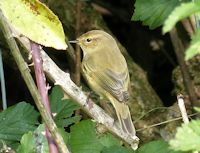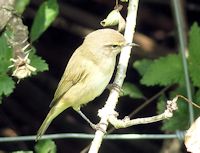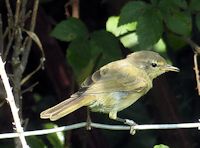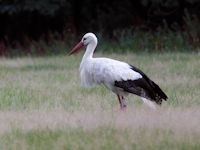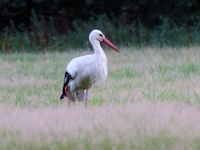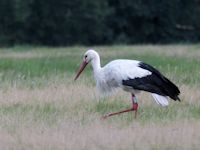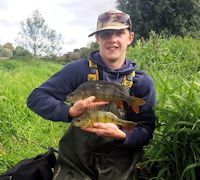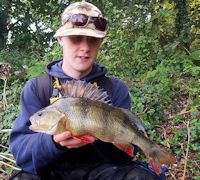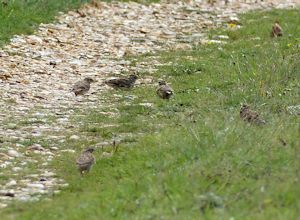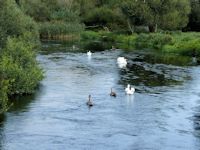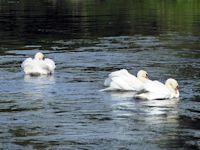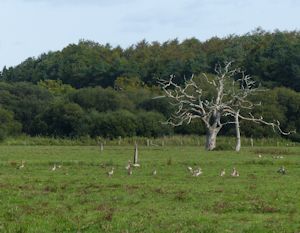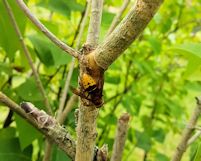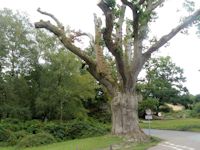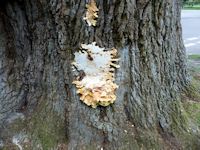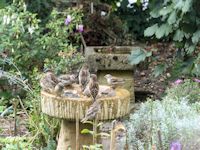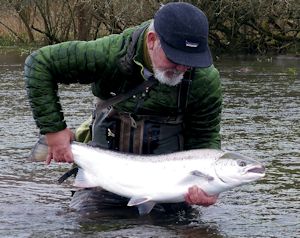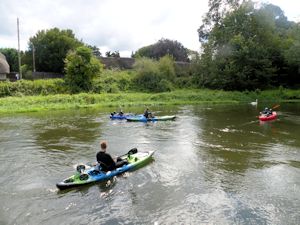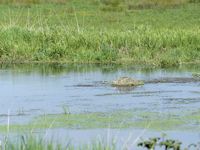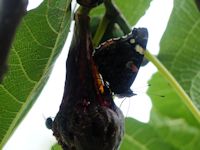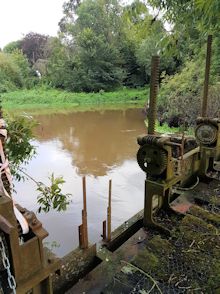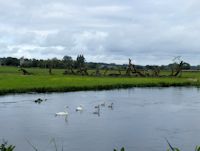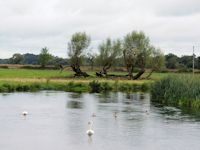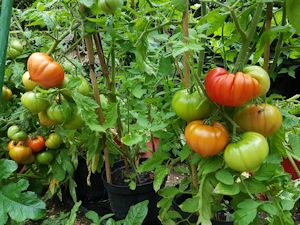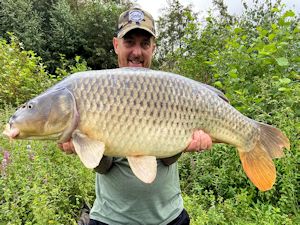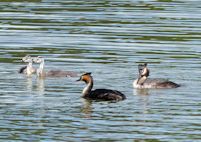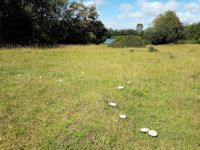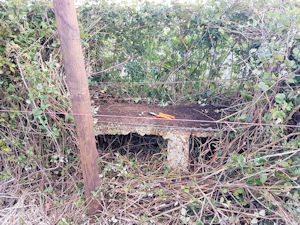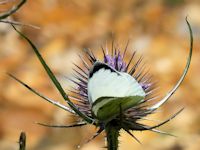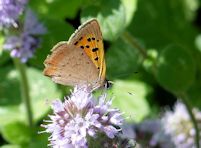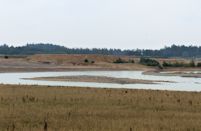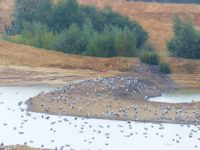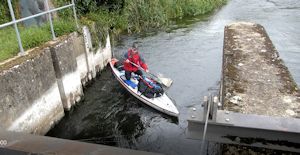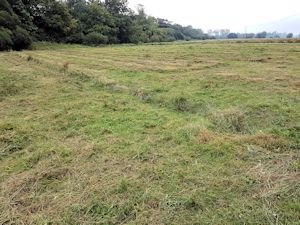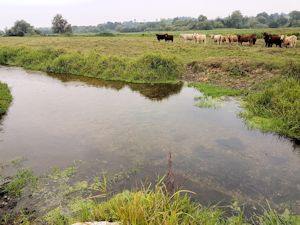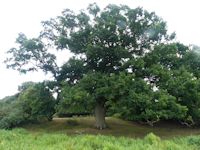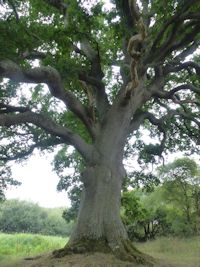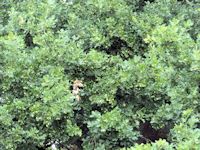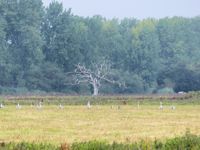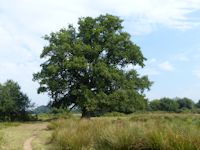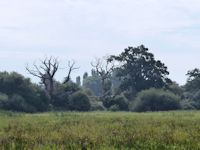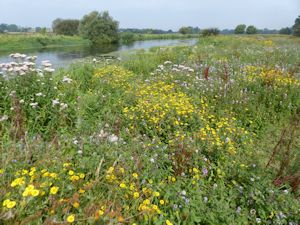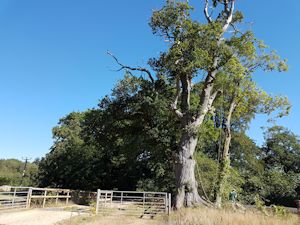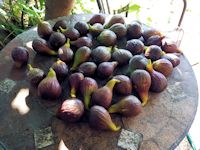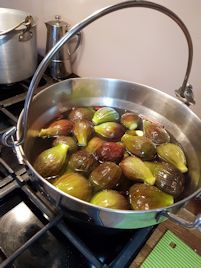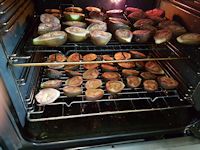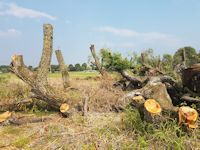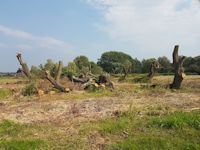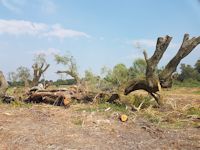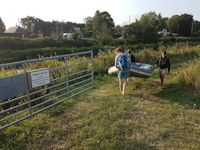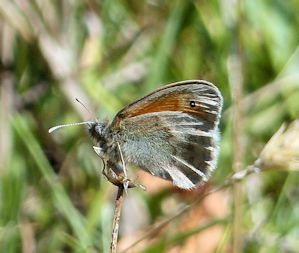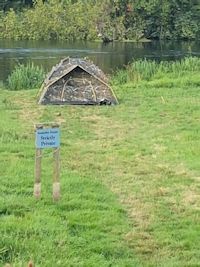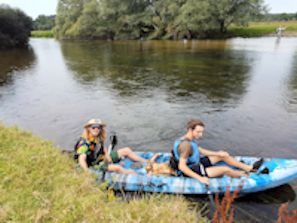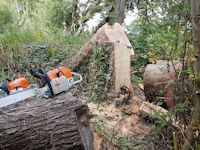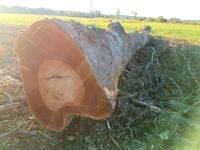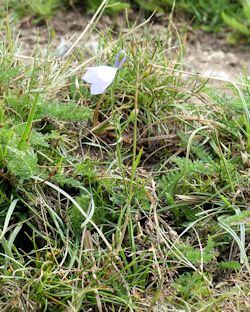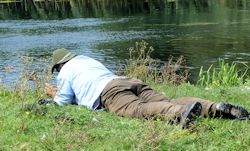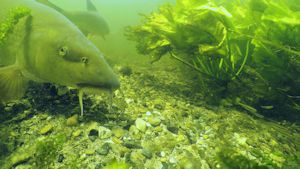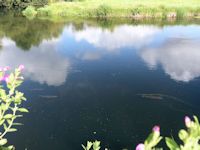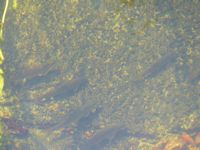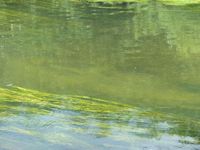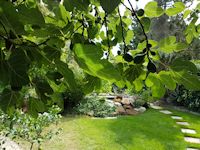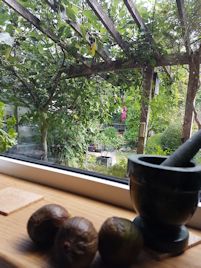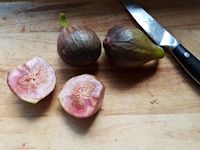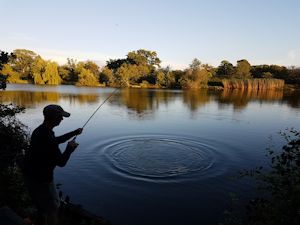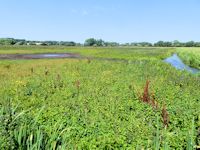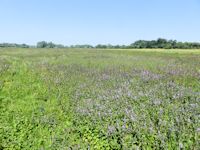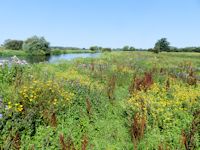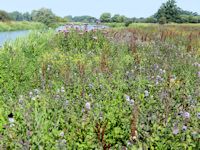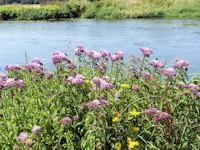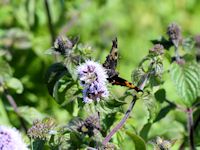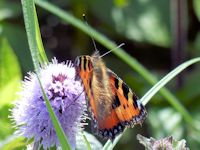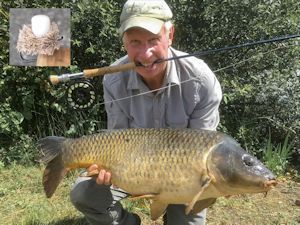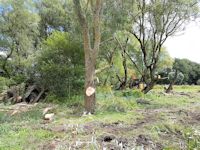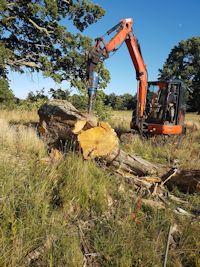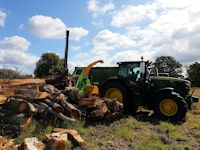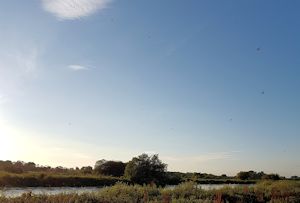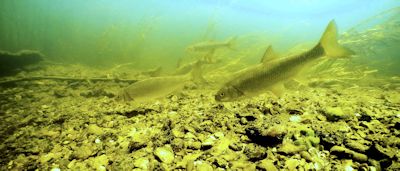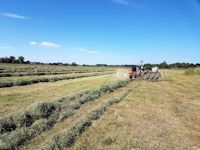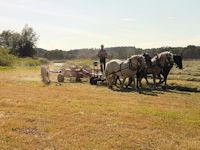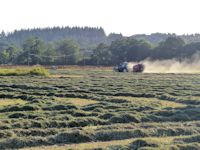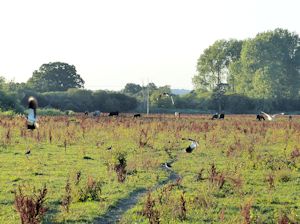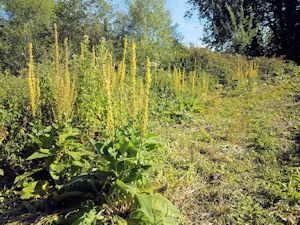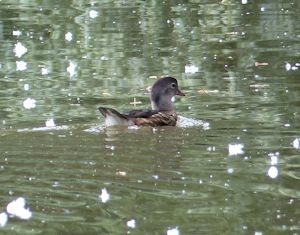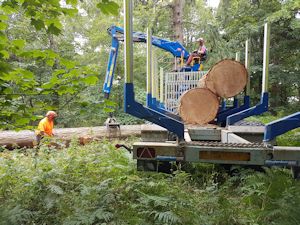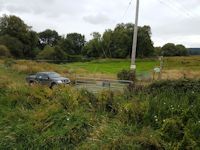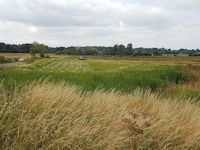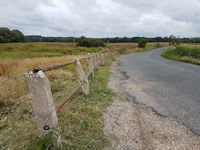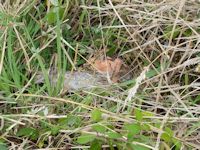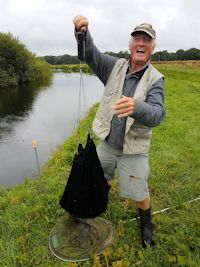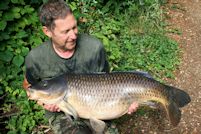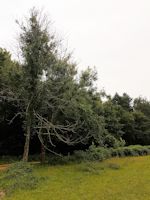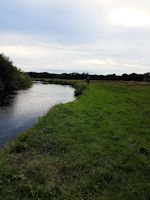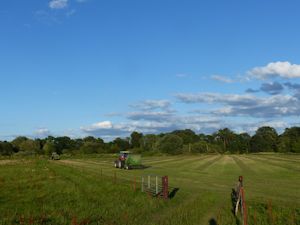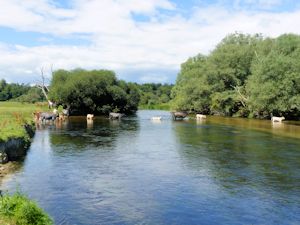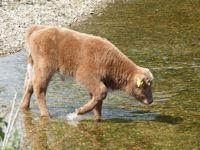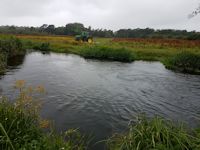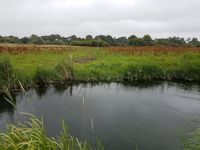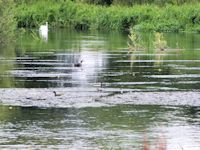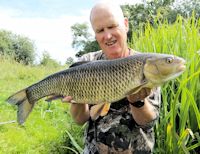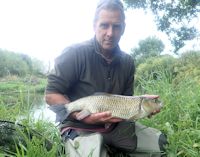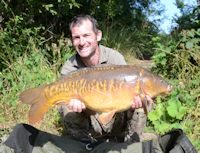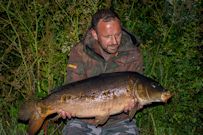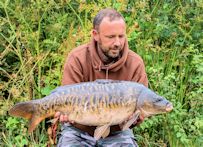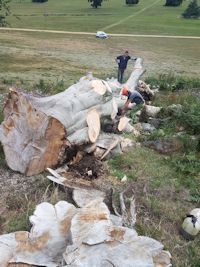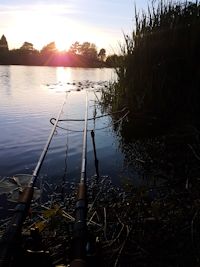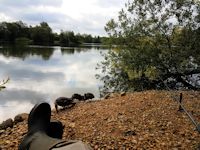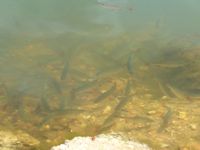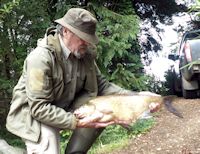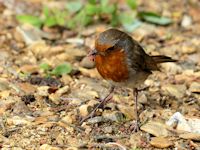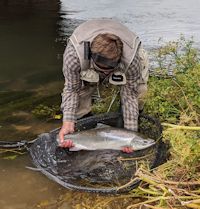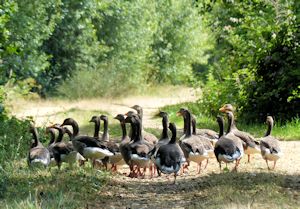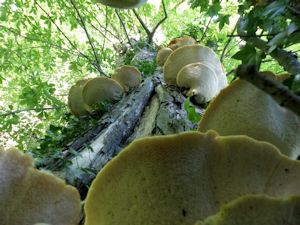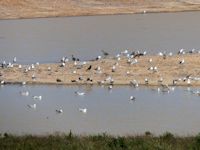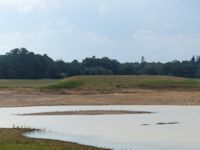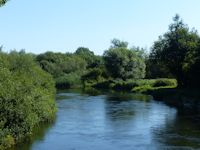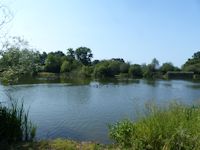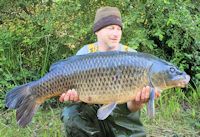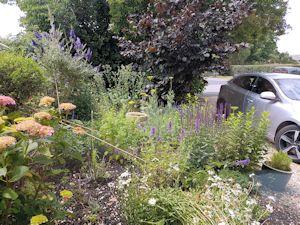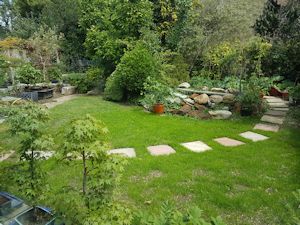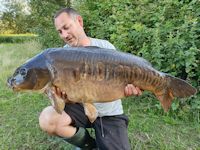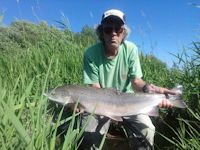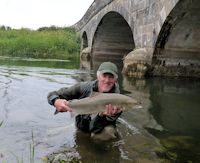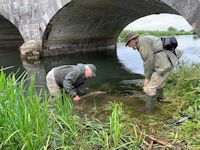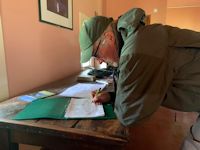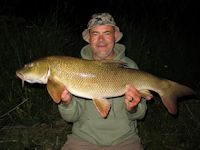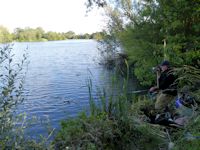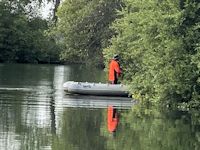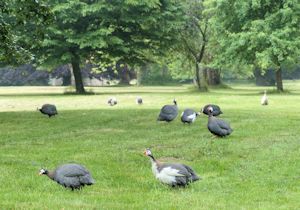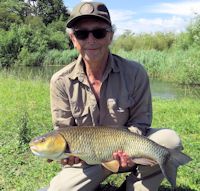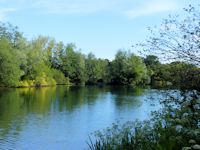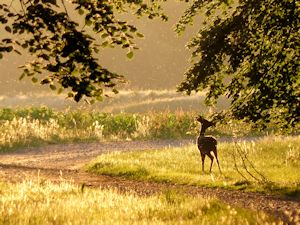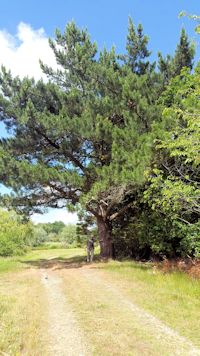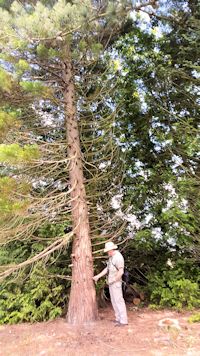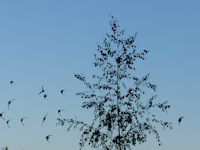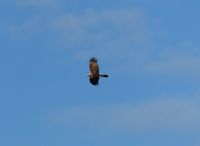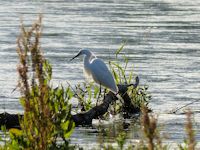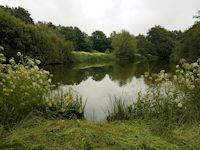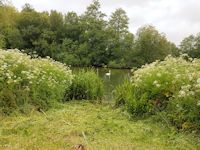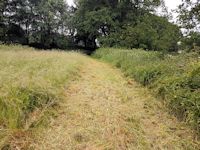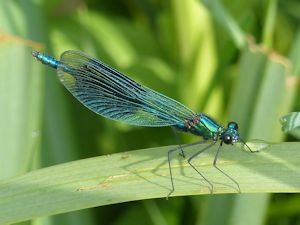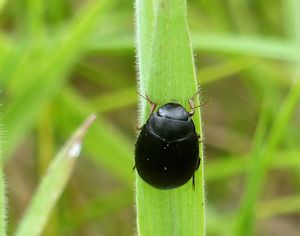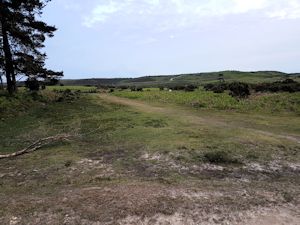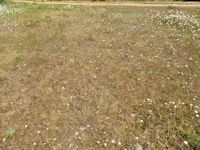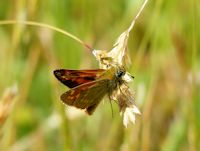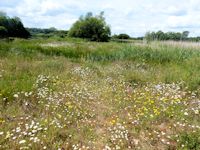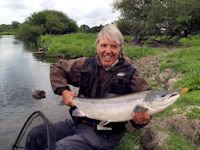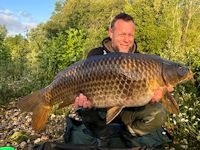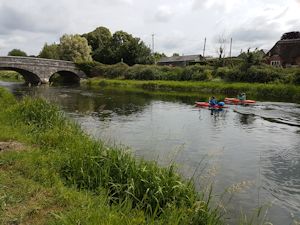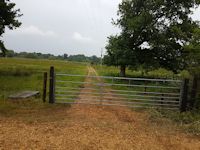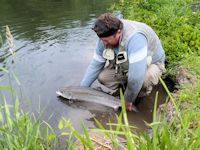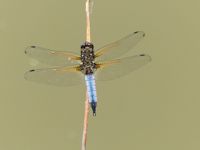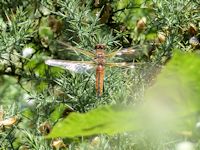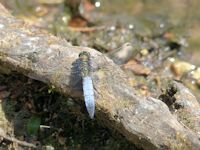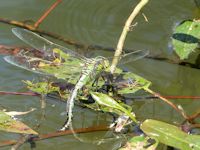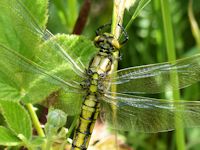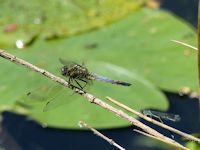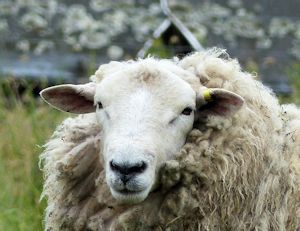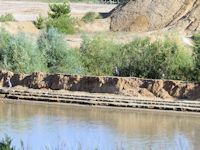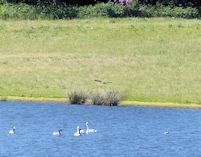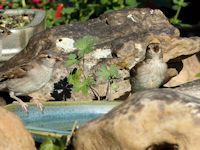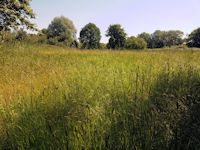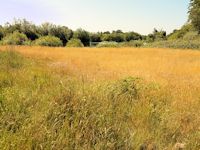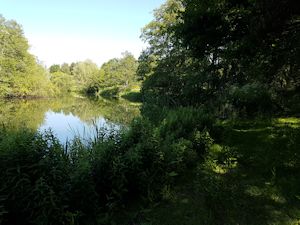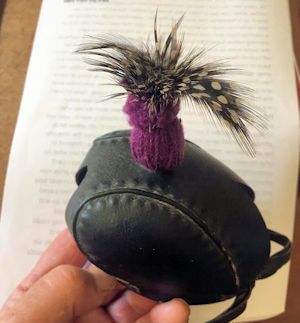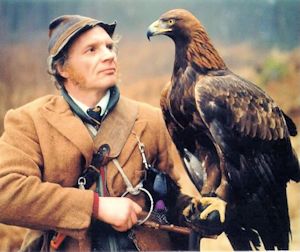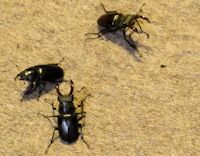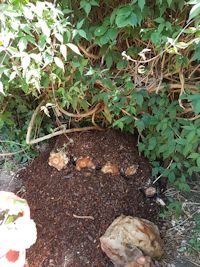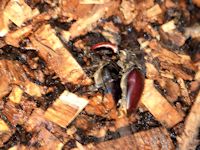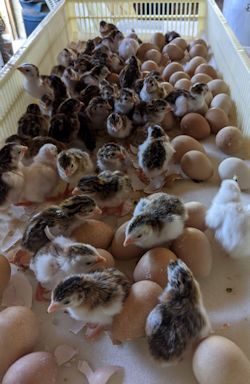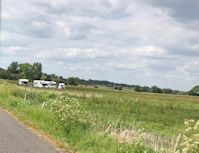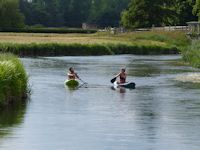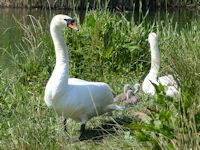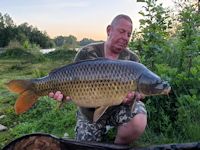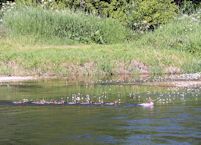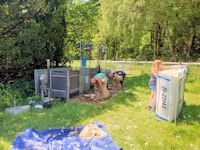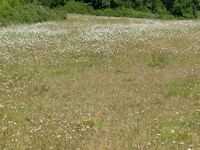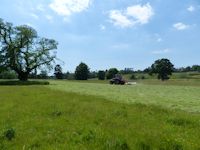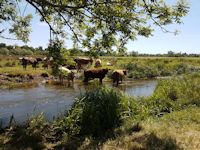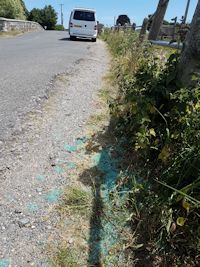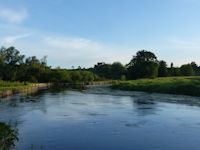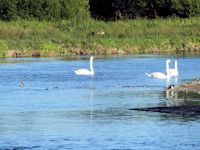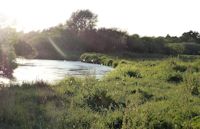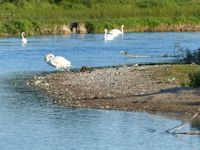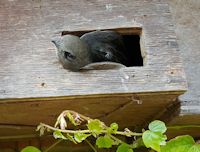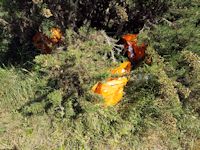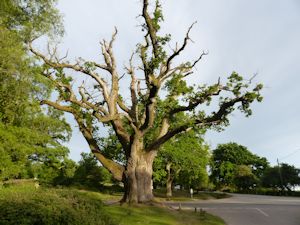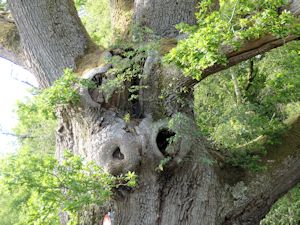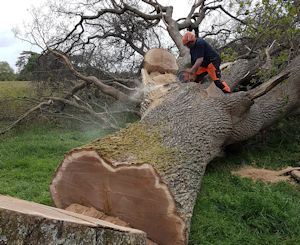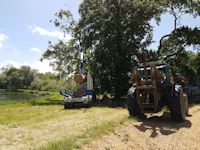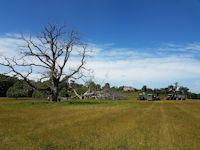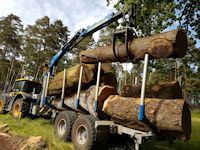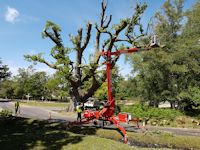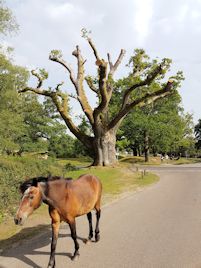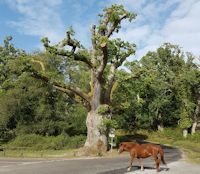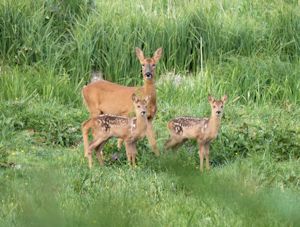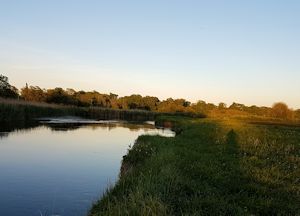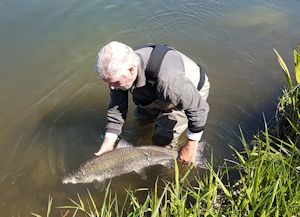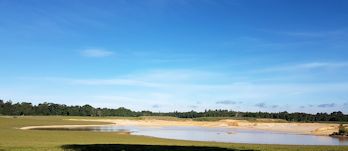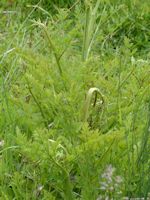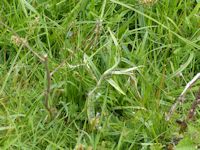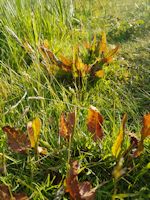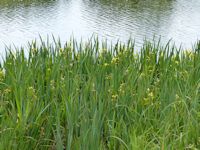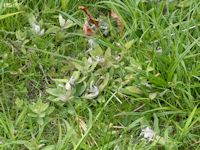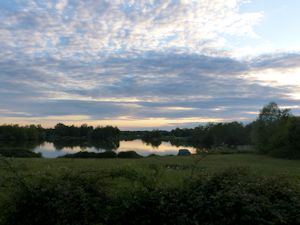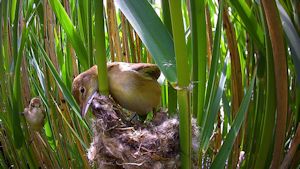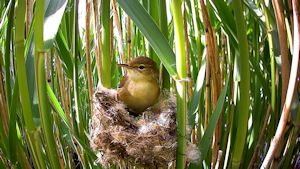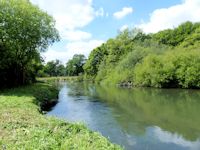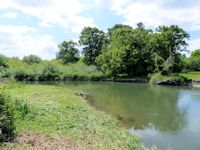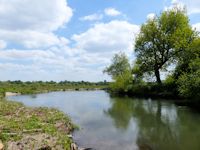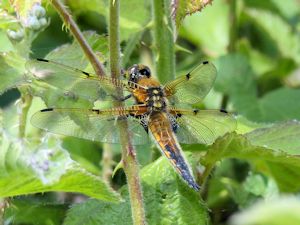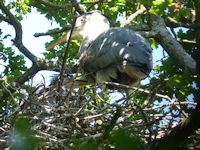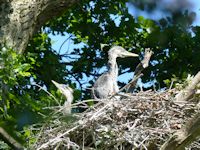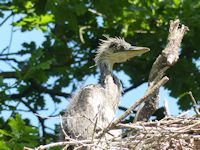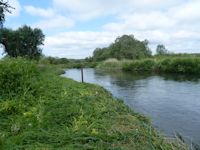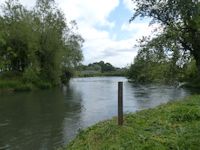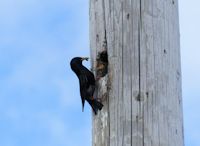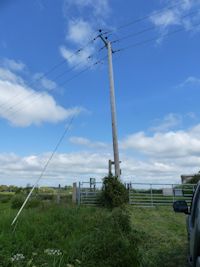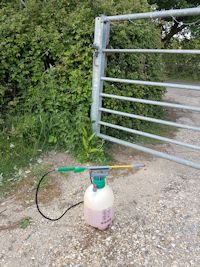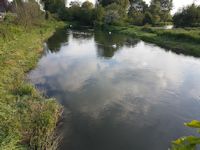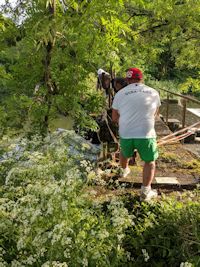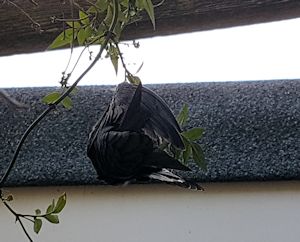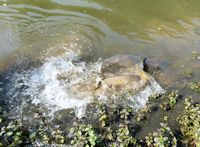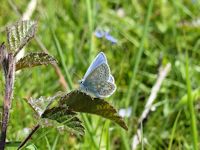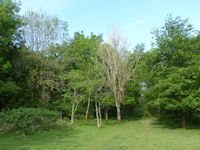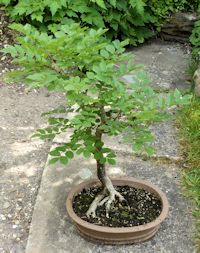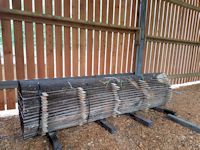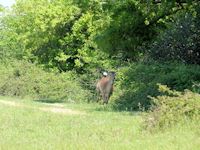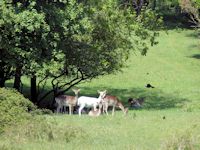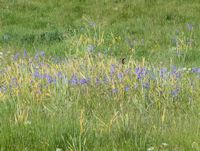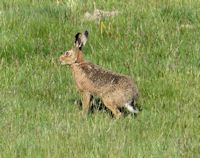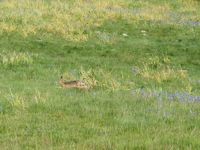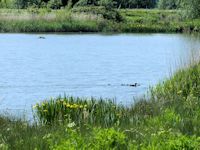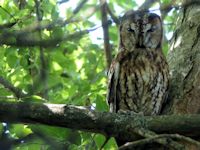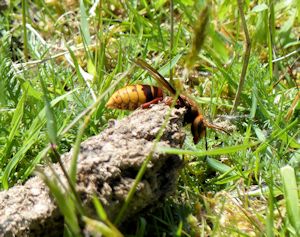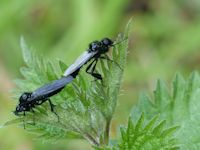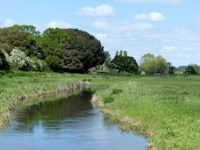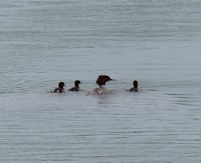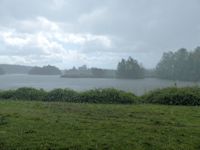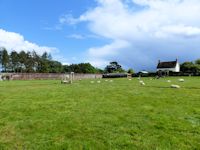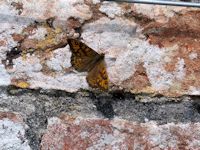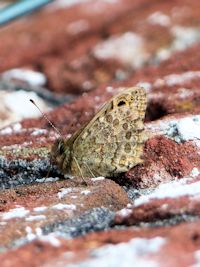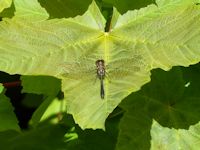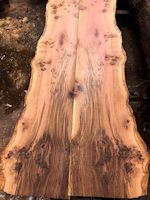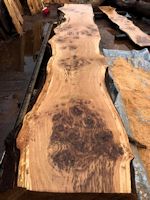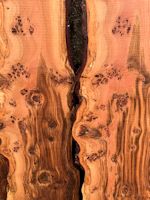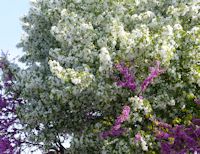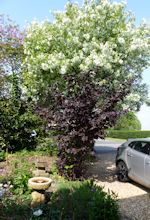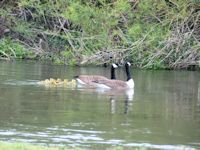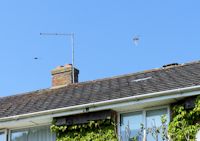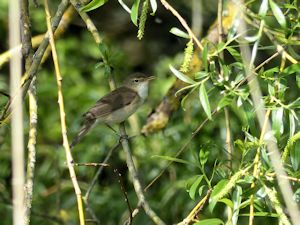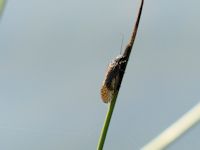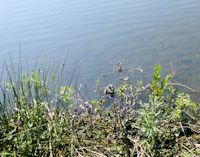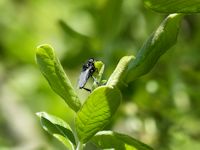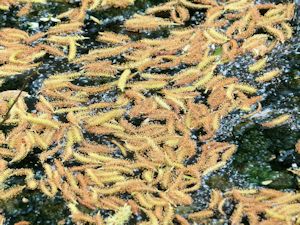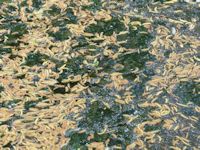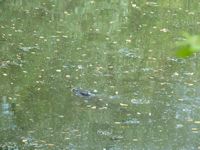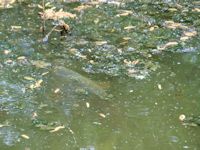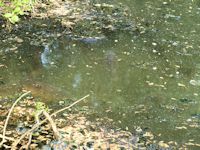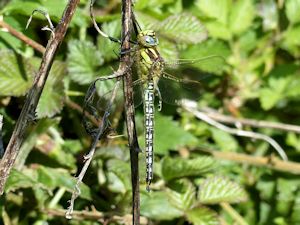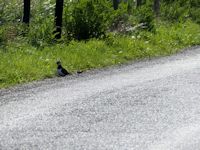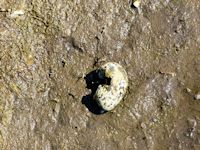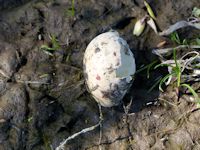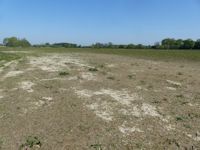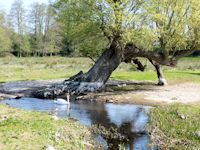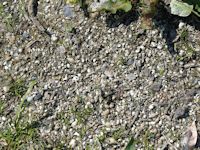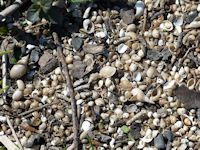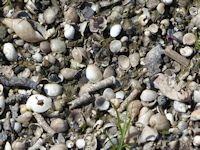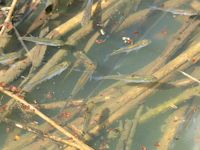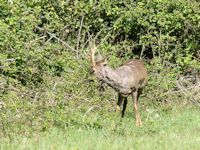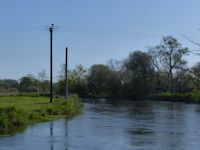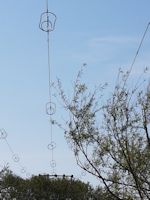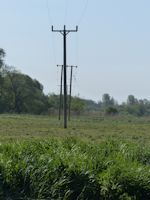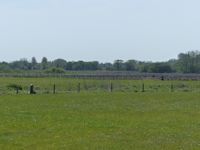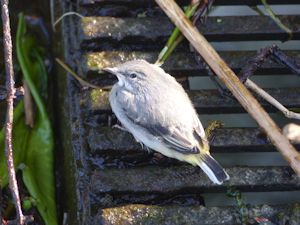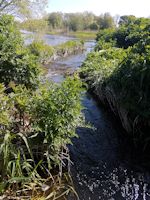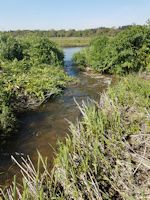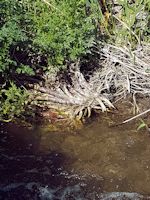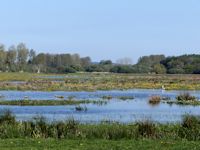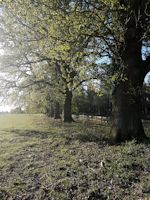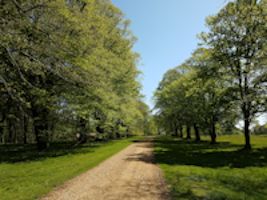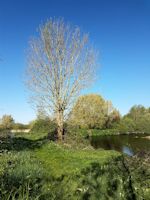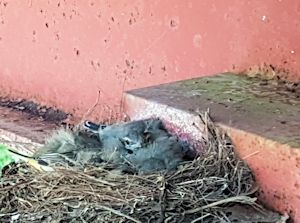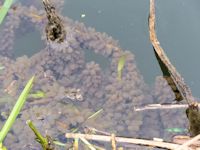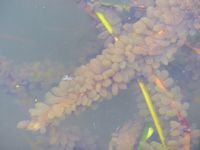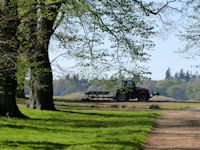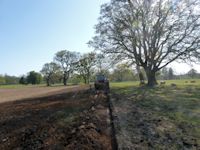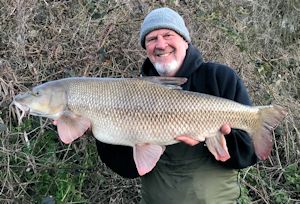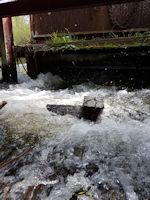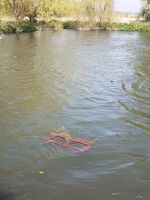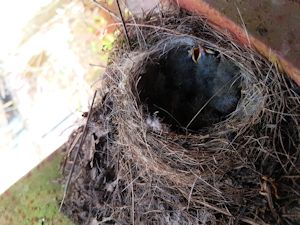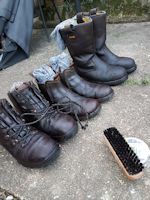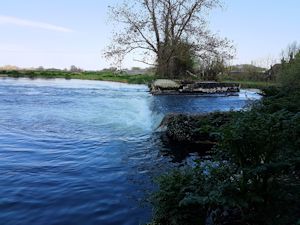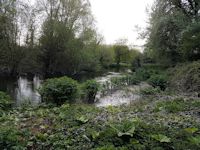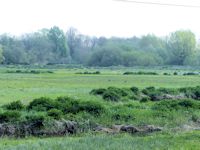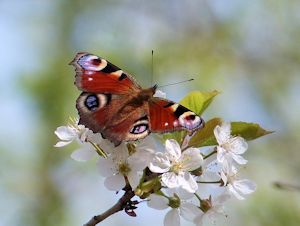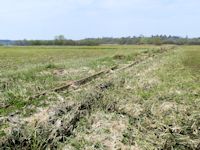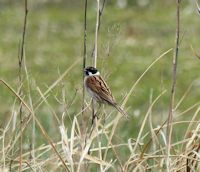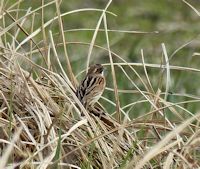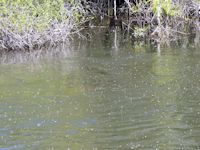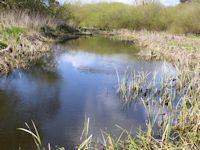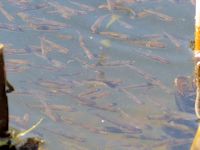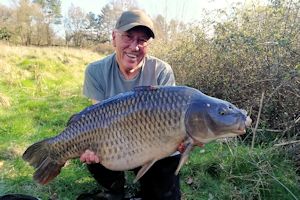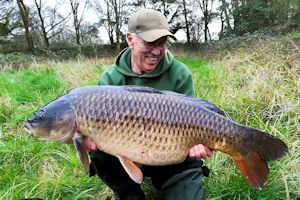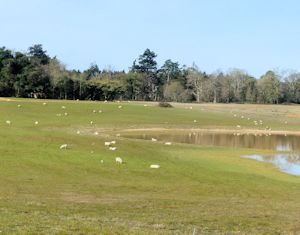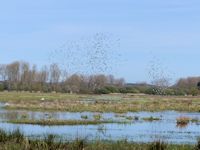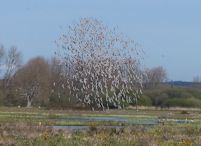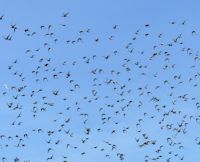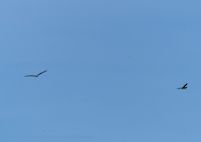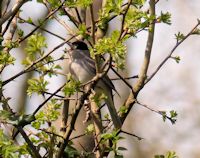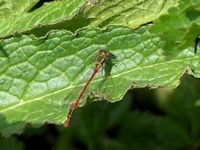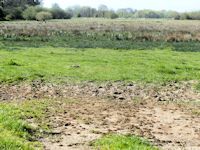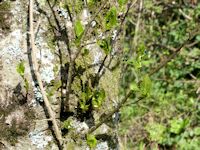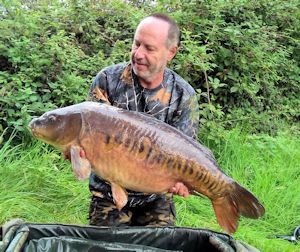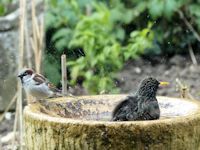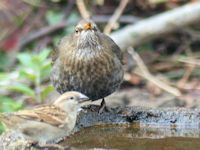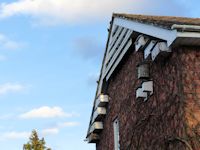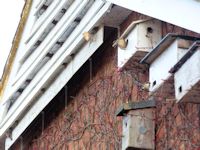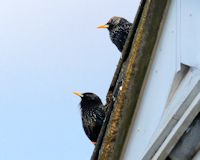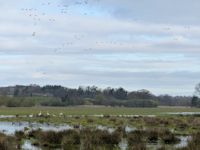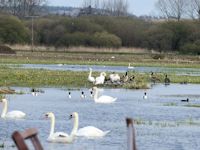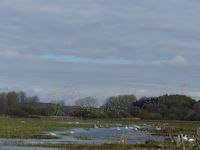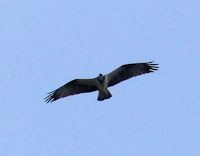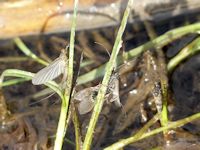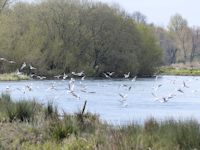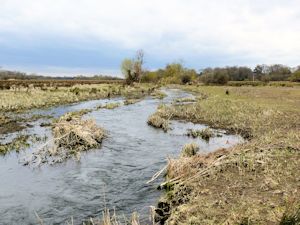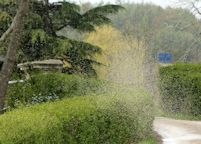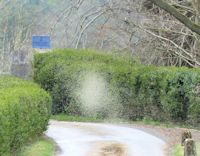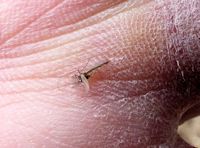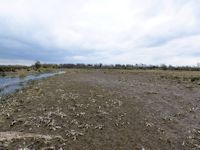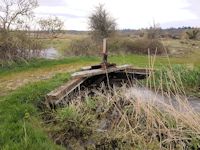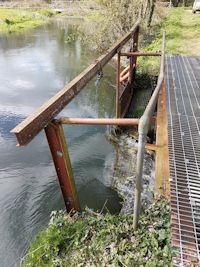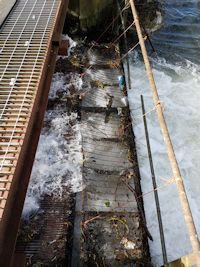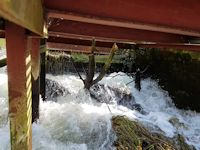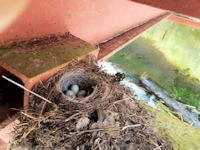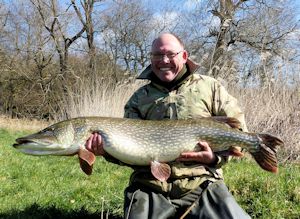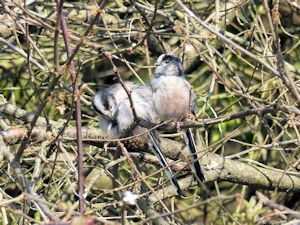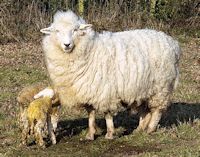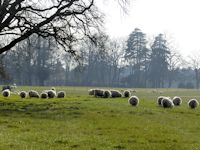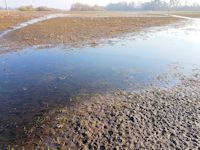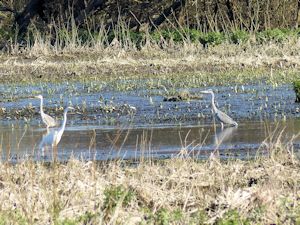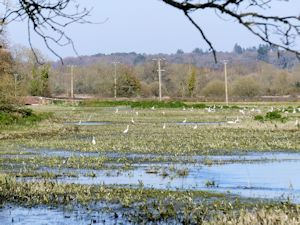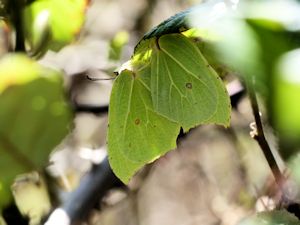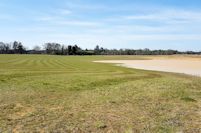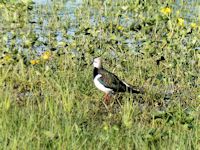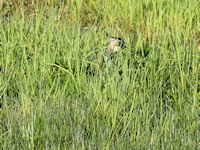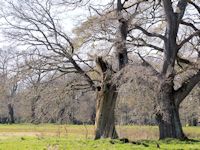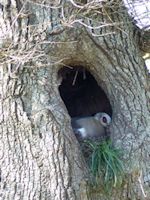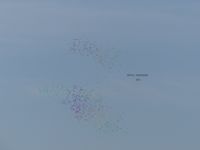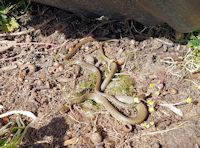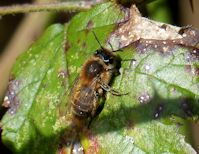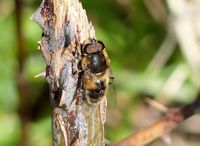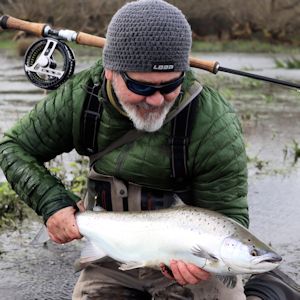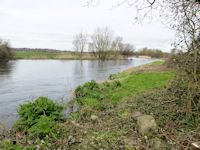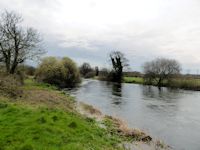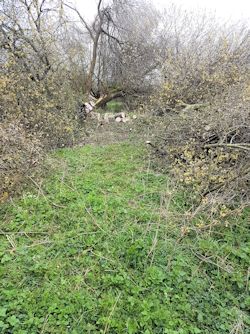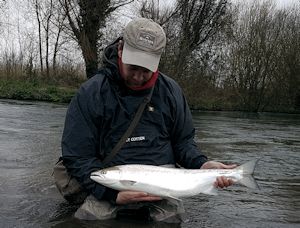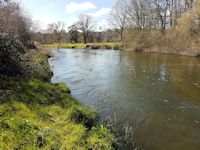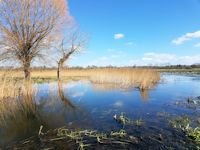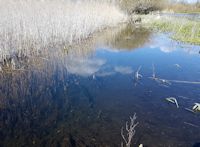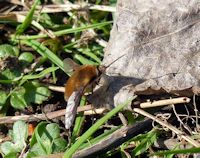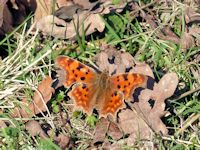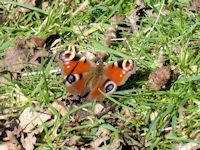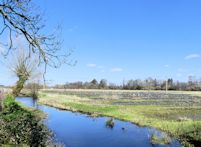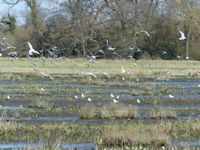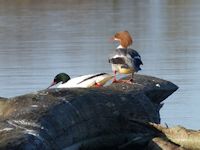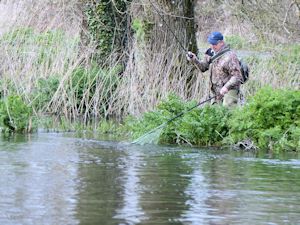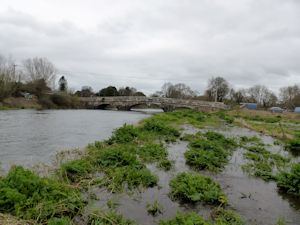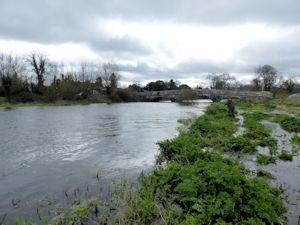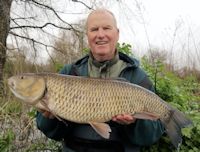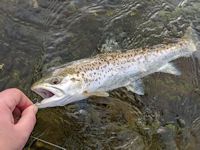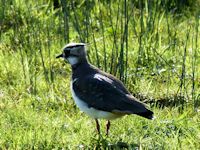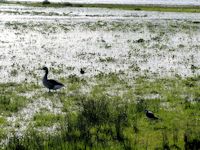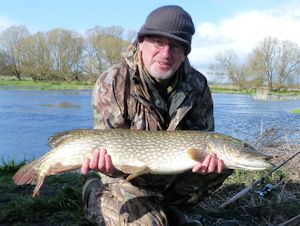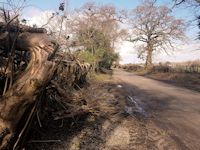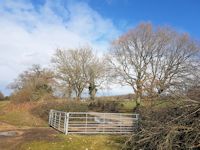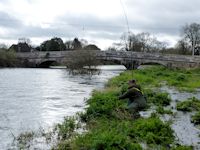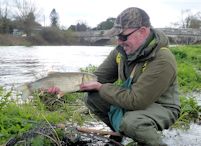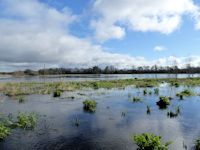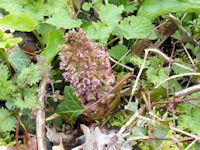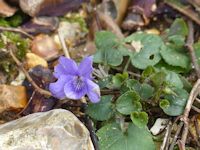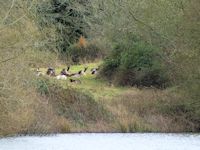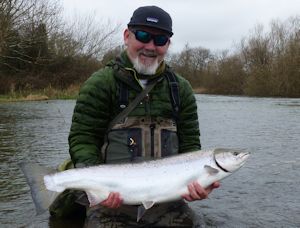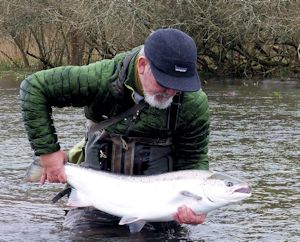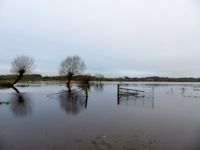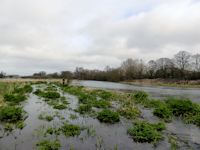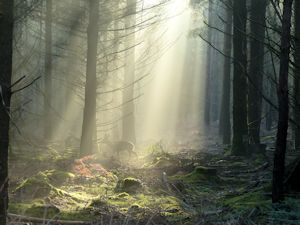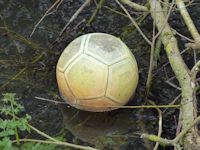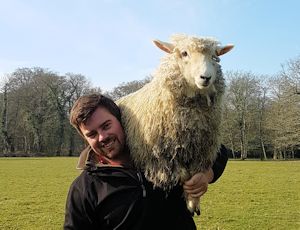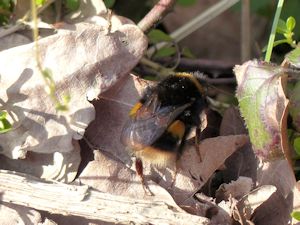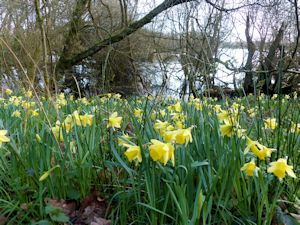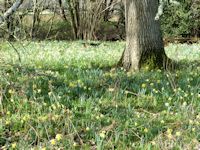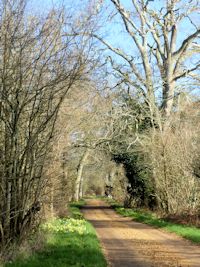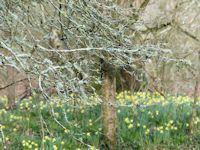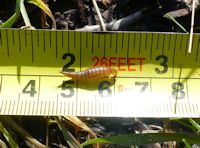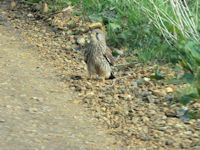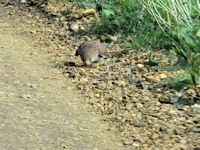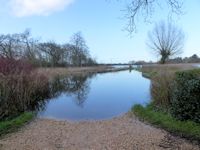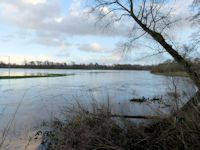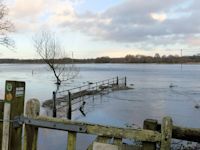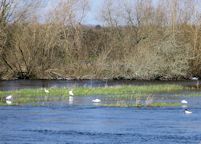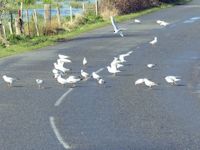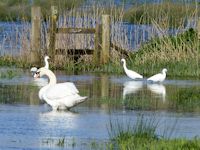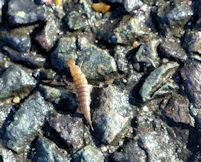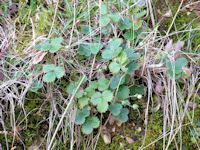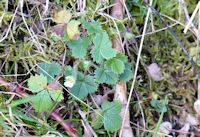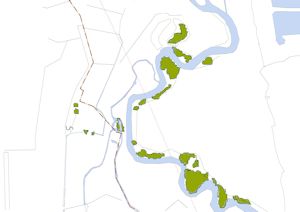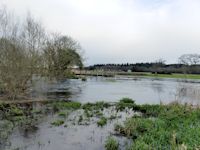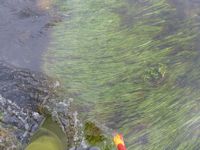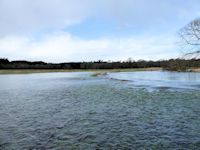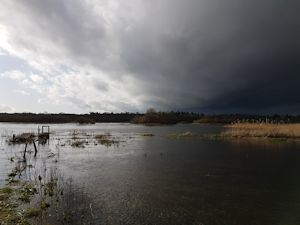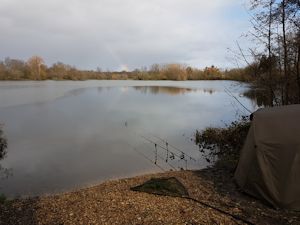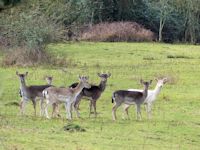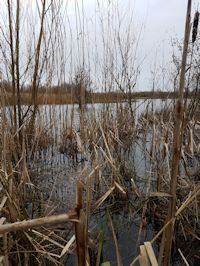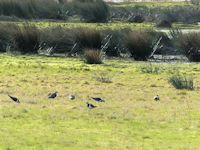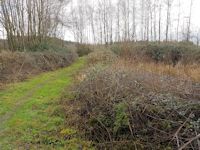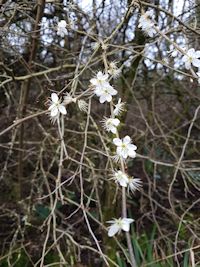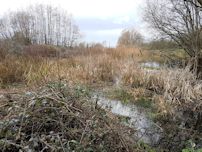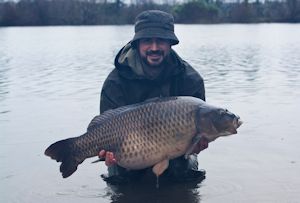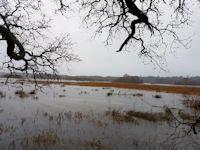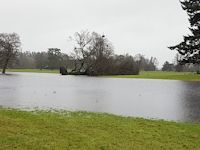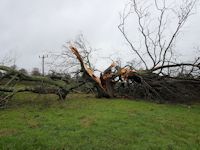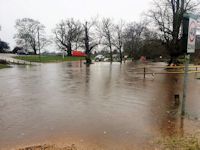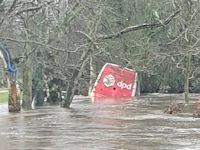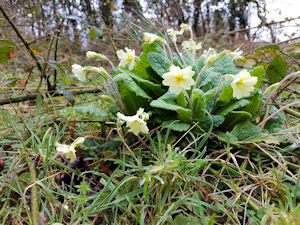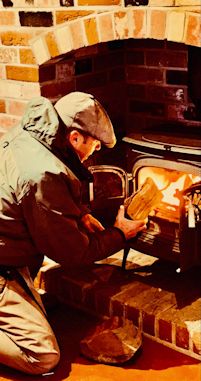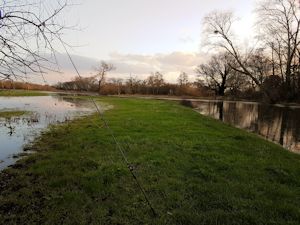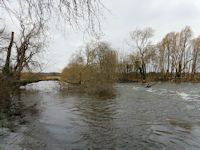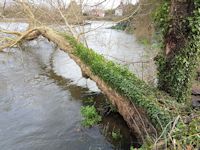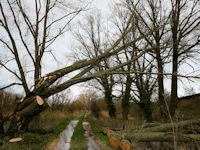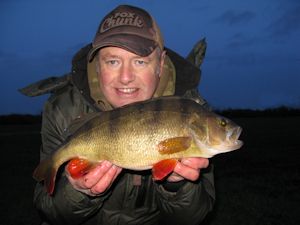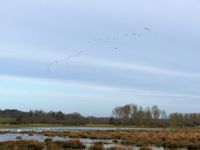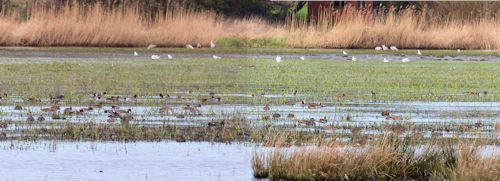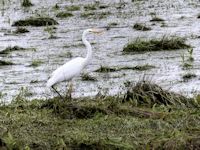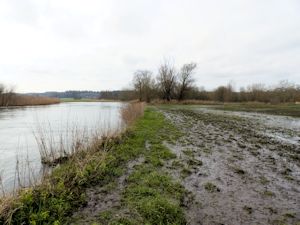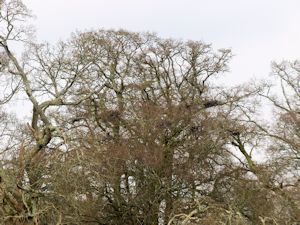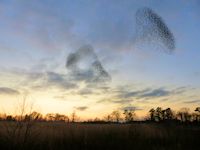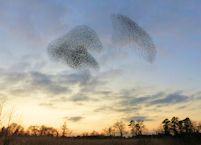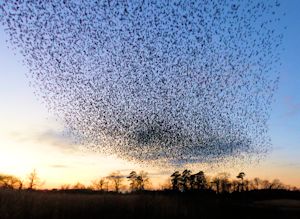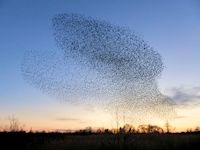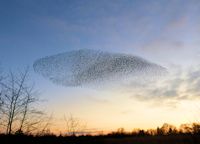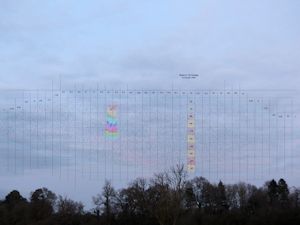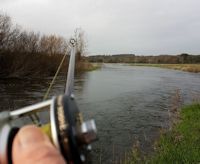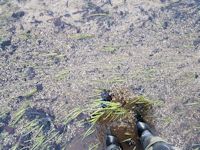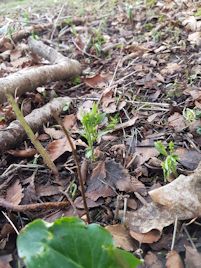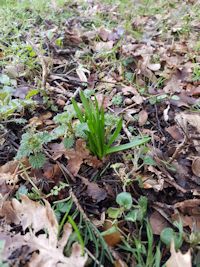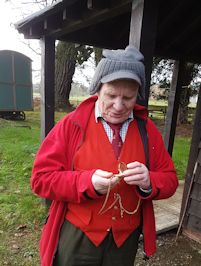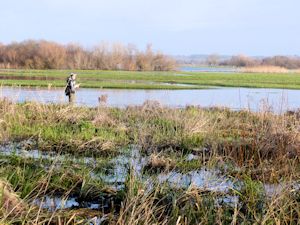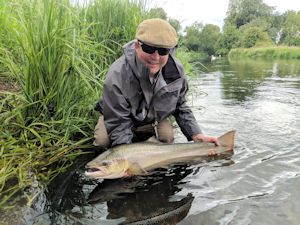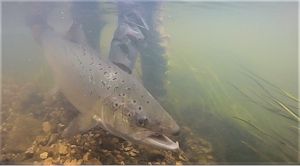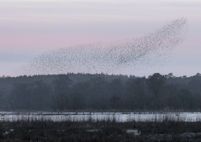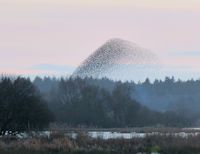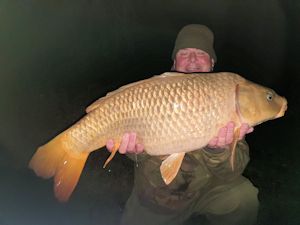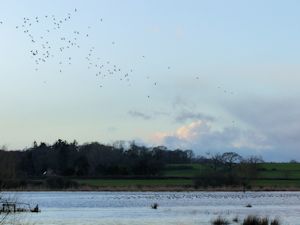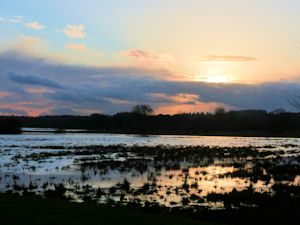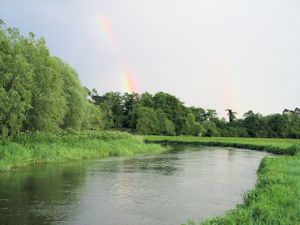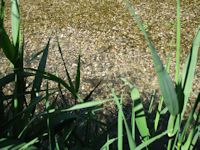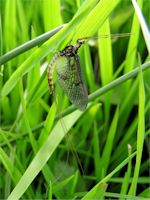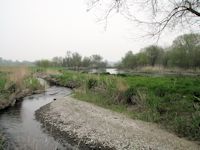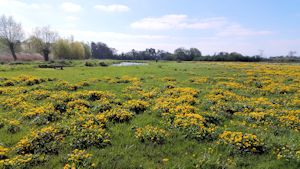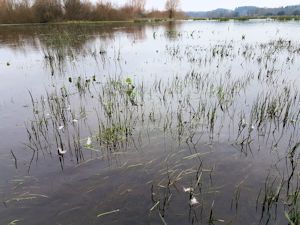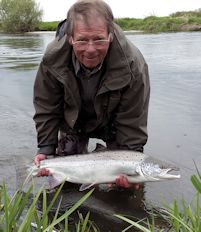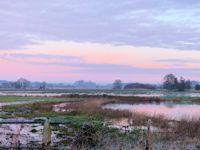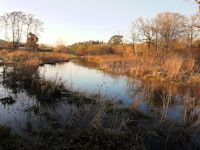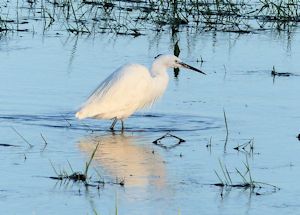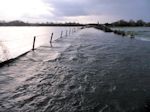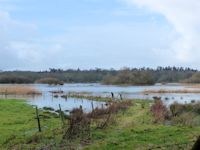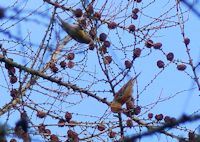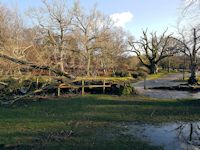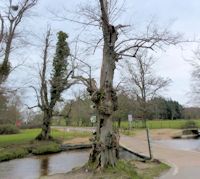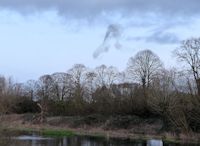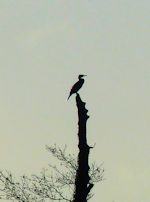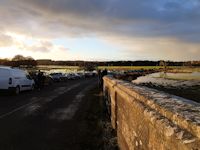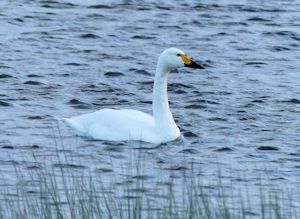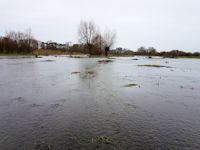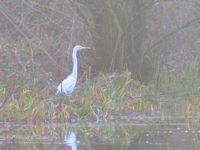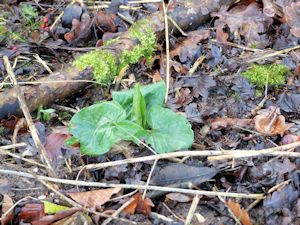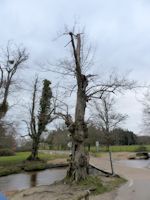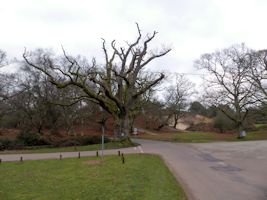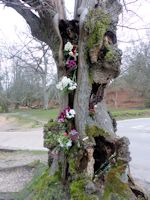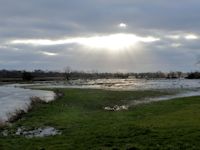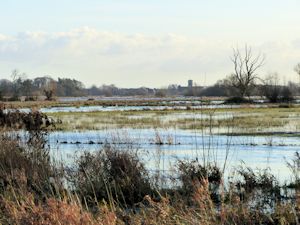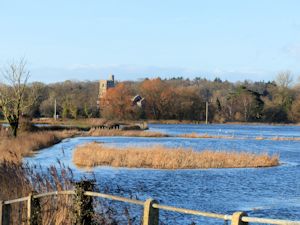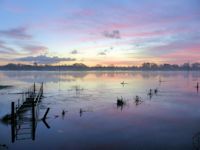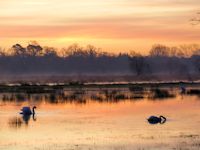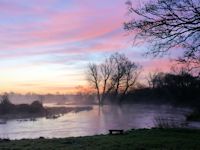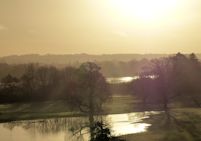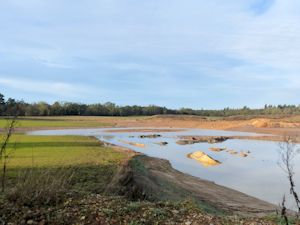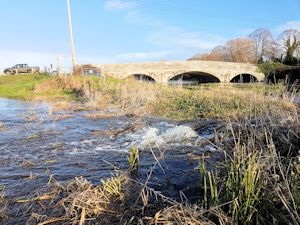31st December
Look on the bright side this will be the last shot of a flooded valley I will show you this year!
I will do my best to shed some light on the situation related to the fishery in light of New Forest now being upgraded to tier 4. Under the current guidelines we are able to continue fishing that is not contested, due in large part to the solitary nature and therapeutic value of our pastime. This has to be viewed in relation to the advice coming from government that states to avoid unnecessary journeys and stay at home. Equally as important, do not to cross tier boundaries. As we are now in tier 4 members living in lower tiers should not travel to the fishery. Similarly travelling the length and breadth of the land to fish is hard to justify as "necessary" and we would ask members not to do so. I can't put a distance on your travels but please be sensible and fish locally where ever possible.
Remains confusing and for many disappointing but with the vacine on the horizon this will hopefully not be an overly prolonged period before we can resume normal play once more. There is a plus to this in that the weather is freezing, the waters are in flood and the fish aren't feeding, as good a time as any to stay safely at home.
29th December
I seem to have got that wrong yesterday, lets hope today is the peak of the flood! I'm not sure how much of the flow is currently ground water or surface run-off. If its ground water we could be in trouble for some time to come. Today's views of the Avon Valley Path and Ellingham car park and it was still raining. High, coloured and cold, not the most welcoming river at the moment.
We currently have a new water body of about five hundred and fifty acres on the Estate, as the river spreads out into the flood plain. There is potentially a further foot of water to add to the current height if we are to reach heights similar to last year. The Harbridge Road is yet to go under and it remains possible to walk most of the meadows around Ellingham in wellingtons, if somewhat carefully. What wildfowl there are in the valley pour out into the meadows at dusk to join the resident swans and geese all grazing the readily accessible floating grass. The waders are finding the depth a little too much and are seeking shallower more protected sections of the valley to feed and sit out the days. If the continent has a cold snap we now have the perfect conditions to attract any influx of wildfowl that it may push our way.
28th December
We can only hope this is the peak of the flood and the forecast colder weather sees the river back in its bank within a week or two.
27th December
The first shot shows Duck Two with the willow that was leaning precariously over the lefthand side of the swim now, as a result of storm Bella, fallen and cutting off most of the swim. The remaining willow standing on the bank has lost half its root mass and its counter-balance making it likely to fall at any time. Also in an effort to avoid fish getting snagged, I will be closing Duck until such time as I have removed the tree, which unfortunately will require the use of the Estate machines. The middle shot is a gem showing Mason's first pike. Fishing with grandad Tim, Mason cast, hooked and played the fish entirely on his own, grandad just doing the honours with the net. I always enjoy seeing the next generation of anglers embarking on their journey. Final shot looking downstream from the footbridge at Blashford. Lots of water to keep the river running for a week or two!
One of the problems when it comes to feeding on the ground in the hope of encouraging Hawfinch. I'm not sure if this white cockbird is three or four years old, he appears at regular intervals around the woods. Being so stand out obvious you would imagine he would fall foul of one of the several Goshawks we have about the place. He doesn't even attempt to keep a particularly low profile spending days out in the middle of the nearby paddocks with the ewes.
Good luck if you venture out there today, waders will be a must.
25th December
In the noticeable still of Christmas morning this Robin was singing his heart out beside the gate at Ellingham as I headed home after my early round. A Teddy made from one of Anne's old uniforms that she received from one of her sisters as a Christmas pressy this morning. Certainly a beautiful way to greet her on her arrival home this morning after her night shift. Enough to melt the hardest heart into feeling festive.
Merry Christmas and wishing you all a happy and particularly healthy year in 2021.
24th December
A taste of Christmas Eve with a Buzzard out enjoying the mid morning sunshine, one of over a dozen I spotted whilst on my morning rounds. The middle shot is Nick with one of his early Christmas presents he landed this week in the shape of a thirty plus common. He also did a quick "over-nighter" and managed a twenty on Christmas Eve this morning. Lovely stuff Nick, thanks for the photo's and the report, a great Christmas brace.
The third shot is the Avon Valley Path record, showing it still unusable entering its sixth week, looking to replicate last winter's six months out of action at this rate. With the long term climate change forecast of more mild wet winters ahead this will become the norm. I turned around two walkers this morning trying to short cut along the Estate roads and past the security gates. It will only add a mile or so and they will have to follow the alternative we suggested to get to Ibsley Bridge. I have heard that the regulators in the shape of Natural England are closing ranks with Hampshire County Council and not interested in improving the lot of the designated wildlife of the Avon Valley. The excuse is that the diversion is closer to the road and the main cluster of nesting waders. Jesus, I would have expected better from professional ecologists, perhaps a ground visit might have been helpful rather than a desk bound dismisal. We were actually using the waders beside the road as film stars last Spring as they are habituated to the constant movement of cars and walkers keeping their feet dry. If you look at the entry of March 23rd, the waders in that shot are taken from the road where at least three nests were within twenty meters. I believe there is also quite an amount of film footage of those particular Lapwing as they were so obliging. Not to worry, its only a few old waders, I can't imagine we will clutter up the rest of the meadow by reinstating the fencing either side of the footpath for their benefit, a practice to which our near neighbours have recently resorted..........and we pay these people public money!
23rd December
An odd sort of request to syndicate members in that we are looking for dead salmon, or more accurately the heads of dead salmon. With the fish currently cutting on the redds kelts will soon be dropping back downstream. Don't get hauling dodgy looking specimens out of the river unless you are sure they are dead, very dead. There is a research project looking to analyse the remains to help in identifying potentially robust populations. Should you come across one drop me a text or give me a call and I, or an EA officer, will appear and pick it up. Don't go carting the thing about the river bank or you may fall foul of the EA for removing salmon. I have been promised a waiver of the byelaw to collect them, or possibly this is a cunning plan to catch me red handed!
The fish in the photo, a 2SW cock fish, was probably hauled out by an otter as the shoulder and innards were missing. Had a fox been involved the carcass would have been carted off. There is a little subsequent bird damage with eyes and soft tissue missing probably Crows or Moorhen. What is perhaps more interesting is that if you look closely at the remains of the body you can see it was plastered in saprolegnia, to the extent it was probably on its last legs or at least well below par. Just why this fish had fallen foul to such a high incidence of saprolegnia is perhaps the more important issue. An interesting PhD thesis might look at the sources of pathogens within the river; STW's, trout farms, farm livestock, road drains lots of candidates to have a look at.
22nd December
Always a frustrating bird to try and photograph as they sit in the top of the trees and ignore you. There are usually several about the lakes throughout the winter months that keep well out of the way. I'll try and find out what they like to eat and get some for the workshop bird feeders as it stands on the edge of a large wood that they often visit.
21st December
Something to brighten the shortest day. The link below will take you to Brenda's detailed 2020, Mockbeggar Warbler Report that she writes to record her years work. I always look forward to receiving her write up and Brenda very kindly lets me share it on the diary as I know several readers enjoy following her exploits. Many thanks Brenda and congratulations on yet another superb years work.
Mockbeggar warblers 2020
On more mundane matters, an indicator of the current water height a record shot of the Avon Valley Path.
20th December
Steve trotting Botney in the hope of a chub, or possibly even a roach or two!
We had a bird survey this morning that started with the heronry on the north of my section and finished with the one in the south. Despite the volume and height of water there were surprisingly few wildfowl other than the local geese and swans and of course the herons of which there is no apparent shortage with a count over one hundred and fifty. The pollards are just to remind me I still have several to do when the water next goes down and the meadows dry sufficiently to get the truck across.
19th December
A flavour of the valley. I assure you the first shot is across to Blashford Island, I just wasn't going to walk out their to get a closer view. The middle shot is the Southern Marsh with the Hucklesbrook in full flood in the foreground. The third looking north across the North Marsh and when I was there just after lunch the river was still rising.
18th December
............and its still rising!.
17th December
Blashford looking very splashy, so watch the ditches if you venture that way. The Penmeade Carrier spilling into its floodplain, if the water keeps rising it will soon join across the meadows to the main channel. Swans enjoying this morning's sunshine in the still water beside the Coomber Oxbow.
The water has risen slightly although the colour has dropped out a little. The river looks absolutely perfect, if somewhat challenging with the height of the water. This last week has seen barbel over fourteen and with the water temperature in high single figures and rising it looks as if we will continue to see them feeding for some time yet. The barbel and chub continue to amaze and I now believe we have a real possibility of seeing a twenty pound fish landed this season. We currently have five confirmed seventeen plus barbel, already to nineteen pounds and if the water temperature remains benign and they continue to feed, a twenty is definitely on the cards at the end of the season.
Alongside this simply amazing recent increase in weight of our barbel we have to also consider the chub population that now boasts at least three fish with summer weight in the high sevens. I don't know exactly how many sevens we have in total, the three I have mentioned were all landed back in the summer and early autumn and properly weighed between 7.11 and 7.14. There has been a great deal of debate about the reasons these fish are getting larger with several different reasons suggested. The amount of trout pellets and boilies being put in by anglers, only big fish left in the river with no competing lower year classes, newly introduced species taking advantage of a previously unexploited food source. I'm not saying there is not an element of many of these proposed reasons but as you will have seen from my above comments regarding the barbel I believe it to be purely a climatic factor. The pellets and boilies may be a factor where fish are seeing large quantities on a daily basis, such as the Ibsley fish that is on a shared water and sees anglers on the bank every day, and night. This certainly doesn't apply to several of the fish lower down in the Estate that probably only see a couple of anglers a week and they are not usually disposed to fishing over large beds of bait. The year class theory may also have bearing in one or two areas yet the chub population of the Estate and probably the entire Avon is massive. Most year classes are present throughout the system in vast numbers, just try trotting maggot in some of the areas favoured by the juveniles, you'll soon tire of winching in chublets. Introduced fish that find an unexploited niche in the food chain can do very well indeed. Some of the moved, usually illegally, barbel from the past rocketed up in weight, gained a ripe old age and disappeared as the spawning and juvenile habitat wasn't there to support a sustainable population. This certainly doesn't apply to the Avon fish, the last introduction I know of was in 1922 when Thames fish were introduced to the Severals. Not including the buggering about by the EA in recent years as they stick fish from their hatchery all over the place.
Leaving climatic change, my preferred factor. Over the last two or three decades we have experienced warmer and warmer winters resulting in the warmest years on record. I am old enough and grey enough, to remember winters where the ground froze for weeks on end and the river ran an icy blue green colour. Many of the ponds and lakes froze over for days and days leaving only the rivers to fish. Our winter quarry featured for the most part, roach, grayling, chub, perch and pike and there were times when the water dropped down to such low temperatures even they wouldn't feed. This was also a time prior to modern thermal boots and suits, standing for hours on end with the loss of feeling in fingers and toes was the norm. Barbel were in the rivers but just not considered as a cold weather species worth targeting. The same pattern of increased size and longer period of fishing is reflected in the stillwaters with the carp, tench and bream up until the late 70's early eighties hardly anyone fished for them after October. Nowadays water temperatures trundle along in the high single figures and even into low double figures for weeks on end. We see more frequent rain events stirring up food and confidence giving colour. At these temperatures and flows fish are feeding and growing, barbel are now fished for throughout the season as are carp with the resulting capture of these massive fish.
Perhaps in support of the climatic change theory are the records of Captain Parker of The Bull at Downton fame. In his published book "This Fishing" there is an appendix that shows the water temperature for December 1940 and January and February 41, without checking I believe the highest temperature they recorded during that period was about 45 degrees Fahrenheit, about 7 Celsius, it mostly struggled along in the high 30's low 40's that's down to about 3 Celsius. If it got above five or six degrees their catch rates improved dramatically. In those days roach were his main target with the capture of a five pound chub giving cause for much comment and congratulations.
Nowadays we fish a different river, for a different balance of species, with different tackle and bait, different clothing and a very, very different approach, yet the overriding influencing factor remains climate change.
16th December
Woodland regen.
My head is beginning to hurt through reading the blatantly bleeding obvious, once more rehashed by a new environmental trust promoting rewilding. The only thing that appears to be regenerating at an amazing rate are NGO's telling us what we already know. As soon as the smell of government cash drifts across the horizon a plethora of consultants and experts spring into life, telling us how to spend it. The river restoration field is awash with such organisations and groups, certainly no risk of a drought for lack of them. The management of catchments needs to be left to the contractors and organisations directed and supported by the landowners and land managers under the direction of the funding authorities. Not as so disastrously illustrated by the recent work on the Lugg where regulators and NGO's are so underfunded and out of touch with goings on on the ground it takes weeks to realise a catastrophe is being enacted. That will unfortunately set panic running within development control for years to come. If ELM's lives up to its hype there may just be light on the horizon. No need to be guided other than by the regulators under the agreed management plans and agreements that landowners sign up to. Regen within the forestry world has been a legitimate and recognised means to establish woodland for decades, unfortunately it is not without its problems. On any clear felled or thinned site allowing sunlight to reach the woodland floor will generate growth. In an established or ancient woodland the seed bank laying dormant in the leaf litter doesn't require any further encouragement to germinate and race to fill the newly created clearing. The breaking of the surface with a prairie buster will help but in most instances not necessary. Trees such as sycamore and birch will germinate as thickly as a field of wheat and within weeks of bursting through the ground is a solid green carpet. The problem here arises from just what you are trying to achieve. If you are seeking economic return from timber sales at some future date, what comes up has some bearing. Strangely in this day of biomass chip there is currently a market for virtually anything. Just how long that market continues is an area giving rise to much debate in the forestry world, in the view of many it is totally unsustainable. If you allow unthinned sycamore or birch to grow unmanaged in thirty years time you may well have an unmanageable squirrel damaged thicket. Great if your sole objective is to let wildlife have a free hand but the majority of UK woodland is managed in one form or another for a financial return. Don't get all holier-than-thou about managed for gain as woodland such as hazel coppice, with oak and chestnut over-story are some of the most environmentally special habitats in the land. One other area that regen will produce a natural woodland is on the meadows that surround our woods. When I say surround this may be up to several hundred meters. From our established hardwoods every autumn there appears a continuous parade of squirrels and Jays that spend the hours of daylight burying acorns, hazel nuts, half eaten fir cones and sweet chestnuts. Along with these natural silviculturalists, with every gale a drift of sycamore and ash keys with clouds of birch and alder seed doing what nature intended, falling far from the tree.
A grey squirrel wondering where he left his nuts. They can be seen all over the woodland floor and meadows searching for their previously buried winter food stores. The wrecked beech trees where their bark has been peeled off by squirrels as they seek the nutrient rich cambium layer in the Spring months. The self set Turkey Oak saplings that need to be cleared at this stage to avoid them becoming a more serious problem later.
An active copse with second year hazel stools below new over-story planted thirty years ago. Oak over-story of a similar age before the section is coppiced. Of the five trees that can be seen in the foreground only one or perhaps two will be left to form the new canopy. The shot on the right shows neglected, grown out chestnut stools that will be cut back to provide vigorous new stools. The old chestnut will be split for fencing strainers and stakes, the brash left to protect the new growth from deer.
The unmanaged, regimented planting that followed many of the 106 planning requirements has around the old gravel pits are now proving of minimal value for either wildlife or future timber. Where we are able to set aside woodland purely for conservation purposes small sections are layered or thinned to allow light to reach the ground and trigger a natural regeneration. The top wood is allowed to remain to once more deter deer from grazing the new growth and the resulting brambles are proving a great success with our nesting birds. The wood in question is suffering from almost total loss through ash dieback so it is in most cases the ash that are thinned or layered. The third shot shows a layered ash throwing up new growth, whether the new growth will succumb to die back we will have to wait and see.
The next problem that rears its ugly head is that of grazing. Keeping domestic livestock out is relatively easy, two or three strands of well tensioned barbed wire usually does the trick. If as we do, you live in Southern England next to the New Forest, deer are more difficult to deter. You have several options, erecting deer fencing, culling, tree tubes or releasing apex predators in the shape of wolves and brown bear. You probably know I favour the later as it kills two birds with one stone in that trespassers are less inclined to cross paths with them. Unfortunately a rogue one is bound to develop a taste for ramblers and then all hell will break loose so I guess we have to scratch that idea. What ever method you chose they all are fairly expensive and require ongoing management. These days we have roe, fallow, red, sika and muntjac, to keep the lot out requires at least a two meter high stockfence, if rabbits and hares are to be excluded buried wire netting has to cover the lower three feet. This will also keep out all other large mammals such as badgers and foxes so not a very natural scene is developing. Just as you think you have got over the first five to ten years and the young trees are establishing nicely along comes our grey squirrels that strip bark from all, beech, sycamore and Turkey oak either killing or distorting the impacted trees. Not such a problem with the turkey oak as its pretty useless as a timber tree and hosts a gaul wasp that has serious implications for our native oaks. Under the management of these natural woodlands the Turkey oak needs to be removed as early as possible if the risk of damaging our indigenous oak is not to be realised.
One other problem we face when we let nature have a free hand is just what she will chose to select. If ash are favoured will they fall foul to dieback? The elms of our banks and hedges that spring from suckers every year continue to cost us a fortune every few years as the Dutch Elm disease finds them and they risk collapse onto the adjoining roads. Will oak wilt take our native oaks, butt rot find our larch and phytophthora our chestnut? Who would want to invest in getting a return from growing natural woodland in fifty years time?
Don't even mention rhododendron, with all its spraying and super ploughs!
Around the lakes where wildlife habitat and architectural specimens are required self set English oak, sweet chestnut, crab apple can be selectively cleared. The brambles are left at their base to deter the deer and the surrounding trees lowered to provide room for the selected trees to flourish.
15th December
An update for those intending a visit in that the water remains high and coloured after the recent rain. If the forecast for the remainder of the week is correct there will be little change in the days ahead. It remains mild so the barbel lads should be fine but others may struggle. The first shot above, taken during a lunchtime shower at Blashford the second my Avon Valley Path record.
Perhaps a reminder regarding parking at Ibsley Bridge is opportune in light of two cars being broken into at the weekend. Neither fishermen involved were fishing the Estate, not that it gives rise to any satisfaction, it remains an inevitability that if you park at the Bridge and are out of sight of your vehicle it will be broken into. That unfortunately is the same across the Forest. Should you see any sus individuals and can get a vehicle reg or photo let us or the police know and hopefully it can be followed up.
9th December
A Great Spotted Woodpecker just to add a spot of colour.
As of 9 o'clock this morning, still frost on the ground however the river is dropping nicely as the two shots of the bottom end of the Harbridge Stream show.
8th December
The Jenny and foal we have helping with the grazing.
As promised some of the birds currently visiting the feeders by the workshop. After such a cold night the wildlife appreciate a helping hand.
A reminder to anyone travelling across the Forest to join us, the Forest fords can be very icy first thing!
7th December
The Avon Valley Path remains well underwater.
Perhaps I should explain my apparent preoccupation with the AVP in that I have put it up on here several times in recent weeks.
It all stems from our work to increase the population of breeding waders in the valley. As many regular readers will be aware we have undertaken many years of management and various projects to enhance the habitat that breeding waders require. With several environmental trust we have entered into partnership projects to further these ends and if recent years studies by the GWCT are taken as the measure we are heading in the right direction.
Into this picture comes the Avon Valley Path and those of you that know the area will be aware of the problems that come with it. The route of this path cuts diagonally right through the very centre of the most important nesting area on the estate. It can be clearly demonstrate through years of study and observation that the disturbance generated by the path displaces all nesting from a wide corridor on either side.
Genuine users of the path are in general not too great a problem. Unfortunately genuine users only make up a small proportion of path users. Dog walkers, picnickers, bike riders and those that use its existence as an excuse to to poach and trespass make up by far the greater number. At a future date I will put up our proposal to Hampshire County, Countryside Service in which we requested they consider one or two proposals. Suffice to say at this stage I contacted HCC, as advised by their website, asking they consider the merits of our case before we submitted a PPO, a formal application for a public path diversion. We asked this consideration based on two listed requirements for a diversion, again as listed on the HCC website. Our primary consideration were the benefits for the waders under “Environmental issues”. The second, based on the problems and financial cost this path generates for the estate we also ask be considered.
We had a ground visit from officials from HCC, who were totally unaware of the problems and enormous efforts of landowners, environmental trusts and millions of pounds of public money invested within the valley to turn the decline of the waders around. Perhaps the distance we, in this south western border of the county, are from the centre of administration means we do not register on the Castle radar. Their sole and only consideration was in their personal view the derived benefit for the general public. It appears the lot of the environment was not considered relevant within the confines of Hampshire County Council and as such they stated they would not support our efforts. To add insult to injury we would have no right of appeal their view is final!
They subsequently informed us that we were not entitled to put in a PPO on environmental grounds as that could only be done by the regulatory authority. Should we wish to have pursued the issue on grounds of financial loss and inconvenience of managing the volume of trespass generated we would potentially face a of charge £4200 to process the submission and they would not support it. As I'm sure readers will understand that whilst we do our very utmost to protect and improve the environment, asking us to stump up over 4K on a PPO they would not support is a bit rich to put it mildly.
We are now at the stage of going to the regulatory authority in the form of Natural England to seek their advice and support. It would not incur a cost on their part should they support the submission. It would still incur considerable expense for the Estate in fencing and re-routing the proposed diversion we had suggested, yet we are prepared to meet that as we have direct control of that expenditure.
If Natural England do not support the case we will have to recognise the waste of our time and effort in changing the farming regime, removing all the fences and controlling water levels. I suppose we could double fence the existing footpath but that would seem counter productive when we have just taken thousand s of meters of fencing out.
This isn't the first time we have thrown in the towel when Hampshire County Council bureaucracy did for our environmental plans. Those of you familiar with Mockbeggar will know how we have managed this water for the benefit of fisheries and wildlife. Over fifty percent of bankside closed to all access and bankside management aimed primarily at invertebrates and marginal nesting birds. Several years ago now, when we first put together the management plans, we agreed with Natural England that we would create wider channels to link the three water bodies in an effort to make the lake more attractive to wildlife. There was no benefit to the estate or fishery, it was solely for the benefit of wildlife. Off we set, hoping to achieve the desired landscape, when we were brought to a halt by an HCC officer demanding we put in for an extraction licence with all its associated expense and paperwork. Well I didn't have time or the inclination to spend hours drawing plans and submitting proposal to achieve an agreed environmental benefit. Unfortunately the lakes remain three isolated water bodies and HCC didn't get their financial pound of flesh. Its no wonder the environment is off to hell in a hand cart with that level of decision making at the heart of our planners and regulators!
I could fill a book and a pretty thick one with the problems that are put in front of some of our environmental efforts. We've lost yet a further year in our attempts to maintain the ancient carrier system that crosses the estate due to regulatory officers refusing to ground visit the scheme on Covid grounds. Whilst I sympathise and support anyone being loath to come into contact with any other people during these difficult times. This ground visit would have been in complete isolation, to a site where a least a dozen precedent are immediately to hand and I promised not to allow any one within two hundred meters of the site when they were there. Where's that bloody hand cart?
Oh, I almost forgot. The reason I keep a record of the Avon Valley path is that the diversion we suggested would not involve anything like the loss of use the existing route currently suffers from flooding.
Sorry, that's it, nuff said. I'll try and find some fish or birds to bring you news of in my next entry.
6th December
I didn't think we would have stock on site this winter as the dry summer had prevented any need to shorten the sward. I hadn't allowed for the prolonged autumn growth period we have just experience where the grass has been growing up until the start of December. No cattle this year but half a dozen ponies and a few donk's to get on top of some of the longer growth.
5th December
A couple of shots taken at nine o'clock this morning to give a feel of the valley after yesterday's rain. It may be useful for those thinking of visiting or anybody trying to walk the Avon Valley Path.
4th December
There are a few Starlings about the valley with in the region of five thousand just north of Ibsley that provide an enjoyable display as they go in to roost of an evening. They can be viewed from the comfort of the car from Ibsley Bridge should anyone wish to view them, with the added attraction of the display being over the river. To date there is nothing like the numbers we have seen in previous winters that I imagine is due to the milder conditions in Eastern Europe meaning they do not have to migrate away from the frozen ground. Our personal flock at home, which numbers fifty two, I think consisting of the half dozen resident pairs and last years offspring raised from their two broods. The resident pairs often roost in the nestboxes and sing most days throughout the winter. On occasions they are joined by about one hundred others that I am not quite sure where they come from. The additions are almost always the same number and appear every few days. I think they are also a resident flock, possibly older siblings but I have no way of proving that. Its just as well I like Starlings as they clear the bird table of all acceptable offering within minutes of their arrival every morning.
A brief look at the murmuration.
1st December
A photo or two from the valley on a unseasonally mild first day of December, which is now doing its best to change, as I write this it's now just before midnight and it is freezing hard outside. The first shot of the day shows the Ellingham oxbow looking, if not feeling, wintery with the leaves now fallen the trees looked stark with bullmace standing dried and withered in the margins. With clouds of midges hatching in sheltered spots it was almost Spring like. Having said that it was similar to December the first last year, which was also very mild, unfortunately we were underwater for the remainder of the winter so lets hope we don't get a repeat of the floods that made fishing so difficult. A nice shot of a good chub coming to the net, with several rods enjoying good bags in recent days. Finally just a shot of a lone Alder that looked striking in today's light as I visited a more remote part of the Estate. The tree is actually stand right on the river bank that is hiding between the tree and the low margin of reeds on the far bank.
29th November
The perfect perch slack and the perfect perch. A pleasant way to spend a couple of hours on a cold late Autumn morning, look closely and you will spot the float. I have a new mobile that has more gadgets that you can shake a stick at, unfortunately it doesn't help the photography!
27th November
Many happy returns Mum, you're an absolute star.
26th November
I parked at Hayricks and decided to walk the block, for want of a better description, to check up on how our recent changes were progressing. Starting at the Red Bridge on the Harbridge Stream, I headed down the Harbridge Stream through the gate on our newly positioned fence line. The new alignment and removal of two more fences was in an effort to make the meadows more attractive to our waders. If the number of swans and geese that are using the newly enlarged meadow are any indication the bird world certainly looks on our changes favourably. I only hope the Lapwing and Redshank have a similar appreciation of our efforts. Back on the left bank of the Harbridge Stream I continued downstream, leaving the slower reed fringed first hundred meters the shallows begin fifty meters upstream of the cattle crossing. Historically salmon used to cut on these gravels a sight I have never witnessed during my thirty years on the Estate. We now run the Harbridge a little quicker than in recent years in the hope salmon and seatrout may once more utilise any suitable habitat. The problem with running the stream a little quicker is the risk it poses to the surrounding hay meadows and species such as roach and perch that prefer a slower environment. The higher flow rates will encourage a different weed regime that will hopefully prove less inclined to block the channel during the summer and cause flooding. We will need to do some work on the stream to afford the fish shelter from the constant higher flow, low profile tree planting or woody debris to create pools and sanctuaries. Work for a future date I'm afraid as we have plenty to keep us busy elsewhere for the next year or two. After a further one hundred and fifty meters the shallows once more give way to a deeper steadier section running for a further couple of hundred meters before passing under the old footbridge to the confluence with the main river at Gypsy Pool. Currently the foot path through the wood beside Gypsy is unusable, as we have yet to replace the bridge over the Slepe Brook that joins the main river just fifty meters downstream of the Harbridge confluence. Just where the stream joins Gypsy has produced some wonderful fish perhaps topped by a wonderful pike of 33.05 and several seven plus chub and fourteen plus barbel, certainly fish to fire up the imagination. Huge chub also enjoy the food supply the stream produces with good fish to be found throughout the length of the stream. Roach similarly used to be found in the Harbridge in large numbers and whilst the odd fish is still caught the roach fishing is a shadow of years gone by. Fingers crossed those remnant populations find future conditions to their liking, as those in the main channel appear to be doing as pleasingly their numbers seem to be increasing steadily. Many years ago when I first became involved with the estate we electro fished the stream that even produced good sized barbel under a tight bend within a hundred meters of the road. Going to show you never quite know what you may find in such streams.
Slower sections just downstream of the Red Bridge before shallowing up for the cattle crossing and down to the confluence.
Splashes for the breeding waders.
From the confluence heading east, upstream beside the main river that traverses the valley in this shallow section, the channel changing from the east to the west side of the valley. The several hundred meters of shallows are vitally important spawning areas for barbel, chub and salmon. Onward, passing one of the wader scrapes we put in a couple of years ago that has weathered in nicely and looking well. Its sole inhabitant today was a Green Sand Piper that departed with its usual double whistle of complaint. After some three hundred meters we reach the shallows where the small stream that created Harbridge Island rejoins the main river. This is the point where the cattle always cross the main river, this year proving the height of the water makes no difference with the entire herd crossing at peak flow at their leisure, without being pushed. No one even in the vicinity to insist. The cows had to swim, the calves instinctively staying protected from the flow in the downstream lea of the mothers. Like a scene from the Serengeti, without the crocs.
Natural Crack Willow self layering.
Just beside the main river crossing stand several old and gnarled willows that have fallen and regrown over many hundreds of years. These wonderful trees are the favoured shading spot for the cattle through the heat of the summer days. These trees are best left to their own devices as they are extremely difficult to manage. The very nature of the collapse and regrowth has formed their unique character in much the same way as the huge Robinia in the Park. There is always going to be a broken untidy element to them that is worth maintaining.
The willow in the second shot is also a result of Nature being left to do its own thing. This is the stream that forms the west side of Harbridge Island and as I said in my walk of a fortnight or so ago is what a valley chalk stream would look like if left to nature. Masses of braided channels choked with willow and alder.
Harbridge Corner.
A hundred meters beside the island to the inception of the island stream that peels away from the tail of Harbridge Corner. This pool has everything with a huge lily filled eddy, gravel shallows top and bottom, deep glides and holes and a similarly varied fish population. The favourite of many members, classic Avon wonderland, wonderful fish in a perfect setting. The pool where a salmon of enormous size was found dead in the shallows, weighed at forty nine pounds when put on the scales. The story behind that salmon is worthy of recording having been told to me by one of my predecessors Edward Wallis-Tarry.
Edward told of an elderly rod who whilst fishing late in the season at Woodside, the pool a couple of hundred yards upstream of Harbridge Corner, had hooked an enormous salmon. This leviathan sulked and cruised about the pool for two hours before our rod began to feel somewhat the worse for wear. Being on his own and fearing the onset of a heart attack, he felt he had no alternative but to tie his rod to a bankside tree, the stump of which remains beside the pool to this day. The fish behaved and stayed in its lie seemingly none the worse for its previous couple of hours exertions. Our rod having recovered his breath and recognising his predicament, felt his only option was to slowly walk the mile plus back to the phone box by the Old Beams and call Edward for assistance. The advantage of mobile phones clearly illustrated here! Duly galvanised into action Edward joined the rod at Ibsley Bridge and they both made their way back down to Woodside. Amazingly, when you consider that a further hour had now passed, the adversary was still sulking mid river. Battle recommenced, they had agreed that the rod would continue to play the fish and if he should begin to feel unwell again Edward would take over. Steady side pressure got the creature moving again and the slow progression around the pool in front of the hatches on the far bank continued. A further twenty minutes and as readers will have dreaded, the awful inevitability of these tales came to pass and the hook hold failed, the fish vanished back into the depths, never having been sighted during the entire duration of their attachment.
The postscript to this sad tale was written a couple of days later when on the gravel at the tail of Harbridge Corner lay a huge dead fish. Edward, with the assistance of two rods, dragged the beast ashore and on weighing and examination the position of an obviously deep hook hold was apparent. They took some snaps, one of which was the dog-eared, much viewed photograph Edward produced from his wallet as he relayed the tale to me whilst we leant on the parapet of Ibsley Bridge. The ugliest and most massive cock salmon I have ever seen. If landed a certain fishery record and if taken when fresh, earlier in the season, possibly an Avon record, as it were it was left to the foxes and crows, a very sad end for such a fish.
The hatches, in front of which much of the above tale took place. The middle of the pool under the high bank where shoals of chub and barbel play a regular part in fishery life. Finally looking upstream from the tail of Harbridge Corner with Harbridge Lodge in the distance.
The actual Harbridge Bend where the river does an abrupt about turn.
Around the bend? to Lower Cabbage the scene of some super catches of chub, barbel, bream, perch and pike in recent years. This area has also seen fairly consistent catches of roach over the period of the syndicate, mostly small with few over a pound, although Darrel's 2.09 was landed not so far from here. Dave playing a good chub to add to half a dozen roach caught earlier.
The tail of Tizzard's with Andy trotting down by the gate, in front of Harbridge Church tower. The tail of Ibsley pool looking spot on at a perfect height for salmon.
Looking upstream from the head of Ibsley Pool to Hoodies and the weirpool.
I have a further salmon tale that began in Hoodies and involved the long gone old phone box that used to be over at the Old Beams car park. It all started on a Saturday morning just after 8 o'clock with the mobile ringing where upon answering, a rod informed me he was in the Old Beams public phone box and into a salmon. The two bits of information didn't make a great deal of sense and my puzzled response was clarified when it was explained the fish had been hooked in Hoodies and had run down stream, through a snag and was now laying in Tizzards 150 meters below, with the line still through the snag in Hoodies. Our man not having a mobile had, as in my earlier tale, tied his rod to the willow that stands on the bank at Hoodies and walked back across the road to the phonebox to give me a call.
Wow, I hopped in the car and was soon on the bank at Hoodies, with the rod, trying to decide on a plan of action. I must admit it looked pretty hopeless as the fish was so far downstream of us and with the line snagged mid river not a chance of walking it back upstream. The fish was laying close to the far bank in Tizzards almost where the river bends around on itself to be opposite us across the field. A couple of options in that if I were able to drive around to the bridge and come down the right bank I might just be able to snag up the line between snag and fish cut it off whilst the rod came around to me with the now free rod and line. Simply tie it back on and continue the fight from the opposite bank. Sounds simple but it all depended on me being able to find the line that was laying along the bed of the river and the fish not moving during all the messing about. Alternatively and the option that we followed was to try once more to free the snagged line. Well, we pulled and tugged and levered and twisted and suddenly, ping, the line shot free and whipped up into the air, clear of the water right down to the fish. Upon feeling the change of pressure the fish did just what we didn't want it to do and darted around the corner to the tail of Tizzards. The line pinging and bouncing up on to the opposite bank down at the corner before clearing and going directly across the field opposite to the now resting fish at the tail of the pool.
Now we were well and truly b........d. We could cut off and whilst I held the line take the rod around over the bridge and tie it on again on the opposite bank. The chances of the fish behaving whilst we did that didn't look very likely as the lie obviously wasn't very comfortable in the slack water and the fish was restless, repositioning itself every few minutes. The alternative, I could take the rod and wade the tail of Ibsley Pool, as can be seen in the photo above, whilst the rod/fisherman walked around over the bridge to take the rod from me on the right bank. I had a wading staff and it looked possible so that was it, dump the valuables on the bank and off I set. The first three quarters was fine, the last quarter a bit iffy as that was where the flow was concentrated. Despite a few scary bits I was across long before the rod got around to join me, giving me time to wind down to the fish and hand the rod over and be in position to do the honours with the net. A fish of seventeen or eighteen pounds that became one of the first fish to go into the Wessex Salmon hatchery broodfish retention scheme we were running a the time. A great finish but I hasten to add, not one I would care to repeat today so don't phone me in the unlikely event of a repeat hook-up.
A diagram to clarify the chaos. The rod in red from hooked to final position on the left bank. the route of the fish in blue and the line crossing the field opposite in red.
The classic weirpool looking a great deal more fishable after our recent clearing work. This pool has always produced good catches but not as reliably as one might think. This weirpool and the second one by the pink cottage do not give up their secrets easily. Somewhere in the early years of this diary is yet a further salmon escapade with the redoubtable Fred Whitlock, Pete Reading and myself as we deal with Fred's salmon that had decided to head downstream from the Bridge Pool through the hatch gates.
The famous Ibsley Bridge Pool. This pool could have an entire book written about the adventures associated with it. Huge salmon, barbel, roach and pike with the added interest of tragedies, mysteries, divers, swimmers, various livestock encounters and even fateful car crashes. It has a further healthy scattering of salmonid tales to rival any so far related but perhaps best saved for another rainy day.
On leaving the Bridge Pool I followed the road back across the valley to the Harbridge Stream where I was to continue my walk down the stream to where I had started several hours earlier. From the road you get a true perspective of the changes we have made in opening up the meadows to the south. The uninterrupted view of over one thousand meters and more importantly the lack of fences and vegetation limiting the predator ambush sites for the benefit of the waders. It all looked better than I could ever have wished to achieve when we embarked on the project earlier in the year. Next Spring will be the litmus test when the waders return and nest sites are chosen. We were hoping to divert the footpath that crosses through the very middle of this wonderful habitat but that project has run aground in the tiresome bureaucracy and dogma of Hampshire County Council and their ignorance of the valley environment. We live in hope that the diversion may one day be successful but unfortunately that is out of our hands for the time being.
Mike returning what was a very large dace, to go with several chub between four and six pounds. To avoid parking in the passing bay by the bridge and putting a style in the new fence that would be just too great a temptation for the poaching fraternity I would ask members to either park on the Ilex Drive just beyond the gate or walk up from the car park on Fools Corner. Always a pleasant way to spend an hour or two, investigating the pools and undercut corners of this lovely stream. Maggot, flake or lobs you just never know what might be hiding in the untapped waters.
The top section of the Harbridge, between the road bridge and the footbridge, is a series of bends pools and riffles, with the deeper water and glides starting just upstream of the Red Bridge.
.......which brings us back to the beginning at the Red Bridge. Total distance, between two and a half to three miles, duration between two hours and a lifetime!
24th November
I must try and spend a little time exploring some of the more remote sections of woodland we have dotted about the Estate. Many pockets of this woodland are in areas that make access difficult, or even impossible, the result they have been left to their own natural devices. I'm not sure of the exact extent of much of this habitat, I would imagine fifty or sixty acres hasn't seen the hand of man for many, many decades. The home to a vast catalogue of unrecorded woodland creatures, plants and fungi. Or perhaps I should just leave them in their undisturbed and unrecorded state, small islands of mystery in this over classified, data collated and indexed world we inhabit?
23rd November
A good day, in that for the most part I was lost in my own thoughts as I strimmed various bits and pieces about the fishery. The first stop was the island at Mockbeggar that I had to finish off. Still a little tree work to do on the island but the strimming is now complete. A late lunch to strim a little of the Back Bank down to the Oaks, on Meadow Lake. An interrupted lunch as a call from one of the members to inform me we had poachers at Ibsley, for which we are most grateful. Kevin arrived to lend a hand to send them on their way. Unfortunately my shakes combined with stuck, half digested lunchtime sandwich meant I cocked up the photo of their car so they got away without a visit from the police. Never mind hopefully they will reflect on their actions and stay away, I won't hold my breath. Finally the left side of the track down to Pile pool, which is all starting to come together and look ready for the winter floods should they arrive.
22nd November
WeBS day and an early start was required to be on the ground before first light. Dispite high numbers of Heron and Cormorant the valley was in fact quite empty of the normal winter visitors we might expect to be with us. Plenty of geese and swans but the duck were almost totally absent. Geese and Swans along with the Cormorants and heron are resident or relatively local birds. We have experienced several mild winters in recent years that have failed to require the normal Eastern European and Scandinavian birds to migrate to over winter in the valley. Is this a sign of things as we feel the impact of climate change? Will our local bird populations thrive or will we see a rebalance of nature as new species move in to exploit the milder wetter valley. This subject will come up again in an entry I am currently writing about the changes on the fishery in recent years, plenty of food for thought.
Busiest part of the day as the Heron and Cormorant arrive at the local trout farm at first light. These birds dispurse through out the valley as soon as they are disturbed by workers or walkers.
Even Alan's cow doesn't know quite what to make of that one! The splashes out in the meadows might expect to be covered in wigeon morning and evening before retreating to the lakes to sit out the day
After counting in the valley was wrapped up I had to count one of the lakes that involved a walk up the Ellingham Carrier. Never one to miss an opportunity I took a spinning rod and a couple of spoons that I had changed the hooks from trebles to circles in the hope of testing my new found belief in circle hooks. The carrier has always been a reliable place to find a few pike and today was no exception. Three takes on the spoon and two good hook-ups. Both fish landed were once more lightly hooked in the scissors. The spoon is looking a little battered from various pikey encounters, you may also have noticed the extra split ring on the hook, just to increase the articulation that seems to be crucial with circles. Getting there almost made up for the lack of birds when I did the count.
I just had to put these two shots up of fish caught last week. Seeing both these fish gave me a great deal of pleasure for completely different reasons. The first is Mick Cutler with the "Lin" or "Three quarter Linear" her full title, at 42.06 a weight I didn't think she was going to reach this year. She is one of our older ladies and had been well down in weight at the start of the season and I feared she was going back. She then proceeded to come out virtually on a weekly basis, which again I associate with older fish going back. Well I'm delighted to say she fooled me as she has recovered her weight and is looking in great condition as can be seen in that great pic of Mick cuddling her and just look at the size of that paddle! Congratulations Mick and many thanks for the photo.
The fabulous common was captured by Steve Swift and it is the first time I have seen this fish go over forty pounds and she is looking absolutely immaculate. Great catch Steve, not a fish we see that often on the bank, a super result. Once more congratulations to Steve on his remarkable catch and for the photo. I also owe Steve a very big thank you indeed for his full season report and photographs of his Mockbeggar year. Lovely stuff Steve, that is exactly what Somerley is all about, it is a real pleasure and a privilage to be allowed to share your season.
17th November
A quick note to the stillwater syndicate members in that for the duration of the lock-down we have dispensed with guest tickets. Apart from the added risk of transmission the lakes have been very busy in recent days and I need to ensure members have precedence. With several members furloughed, making extra use of the lakes, this also comes at a time when we have closed Mockbeggar placing increased pressure on Meadow. Hopefully the lockdown will be over before too long and furlough will be an unpleasant distant memory.
I will put a note on the diary in the event of any change or we will send around an email. Currently, whilst popular, the added pressure on the river is for the greater part from members. Should this change we may extend the ban to include the river, again we will let members know should we introduce a similar guest ticket ban on the river.
An update on the high water after the weekend's rain shows it to be gradually dropping back. The bird world is enjoying the shallow pools and there was even a rambler out on the valley footpath.
Interesting implications
16th November
I'm still cleaning up around the fishery, whenever I can find the time to fit it in of course. With the river out in the meadows I have concentrated what time I have on the lakes. Mockbeggar is now long closed yet the work of cleaning up has to continue, requiring lots of strimming and time to think. Whilst out there today it occurred to me that I had not put up a great deal of news about how the lake fished this season. I'm afraid I can't put together a complete review at the moment so please enjoy a shot of Chris with a classic Mockbeggar common, one of several, scale perfect, astonishingly well proportioned, truly wild fish, a lovely way to round off the season. Thanks for the report and the pix Chris, much appreciated.
15th November
"A great flood is coming", I can't for the life of me remember who said that! I just hope he's got it wrong this time around.
Nature's Autumn palette.
12th November
The perfect Autumn swim, unfortunately the leaves where not restricted to the bank and the overnight rain had flushed thousands into the river making fishing all but impossible. The Autumn view across Mockbeggar is one I will never tire of, making daily security visits a real pleasure.
11th November
A great deal of noise is currently being generated around the water companies and their failure to respect our rivers. Particular emphasis being directed toward chalk streams that suffer the double whammy of aquifer abstraction and discharge.
I know I keep banging on about sustainable environmental funding but I make no apology for doing so. I believe without guaranteed, ring-fenced funding we will continue in our current downward spiral.
Abstraction and discharge conservation levy removes the sycophantic grovelling for funding as fund raisers have the indignity of going cap in hand to the major polluter to deal with the issue impacting our rivers. You need to invest in a long handled spoon if you intend to sup with the devil. A ring fenced conservation levy is the only logical answer if we are to take the protection of our environment seriously, there just has to be a change of emphasis.
Add to the abstraction and discharge levies there has to be an agricultural chemical conservation levy. This also has to be ring fenced and allocated by an independent panel of experts that are elected by those that own, manage and work and are impacted by events in the natural world. A committee along the lines of the NERC board, with a little more accountability and transparency. Change in farming throughout the catchment and across the entire length and breadth of the land is in need of a desperate overhaul. ELMs is definitely an encouraging step but not sufficiently radical to protect our downland, vales and valleys. Lets see an end to ploughed downland depleting the fragile soil, requiring artificial fertilizers and pesticides to produce and all eventually ending up in the river. An end to ploughing in the floodplain with the associated loss of soil into the rivers. Lets stop vilifying the cattle and sheep producers, there are grasslands such as the downs and floodplain that are best suited to their production. Stocking rates that have been hiked in an effort to maximise returns will require closer examination. The destruction of much of our natural world can be laid at the feet of the agricultural sector certainly time to see a complete change of direction. If landowners and farmers wish to continue in their destructive ways all subsidies to that farm or landowner to cease. Not just the areas adversely impacting the environment.
The government has abandoned any genuine attempt to honour its responsibilities toward the environment. More than happy to pass the buck to the wildlife trusts and the voluntary sector, supposedly working in partnership with the remnants of the regulators. The problem with the wildlife and voluntary sector is, as I have said, funding is not guaranteed or sustainable. The reality of the Covid 19 shut down has seen the fund raising capabilities of the charities involved severely curtailed.
Some of the environmental and carbon off setting schemes leave a considerable amount to be desired. Especially when the offsets and compensatory packages are decided by the local authorities, with for the most part no say or right of appeal. Not the best way for any environmental charity involved to enhance it reputation.
I'm sure many readers will have read Hudson's “A Shepherds Life” where he describes the link between the remotest parts of the Plain, through the villages spread along the five tributaries of the Hampshire Avon, that all arrive at Salisbury. At least close to Salisbury, that he so eloquently describes as the beating heart of the community. Somewhere in the intervening years the countryside and the towns have lost that vital connection and with it the understanding and tolerance of each element of our society. The disappearance of the cattle markets from the centre of the cities and towns severed the link between town and country. With our disconnected lifestyle we fail to understand or appreciate the ties we have to the wider community that surrounds us. The polystyrene and cling film wrapped chicken breasts or pork chops we all too frequently take as the norm illustrate this all too clearly. No connection with rearing, feeding, selling, slaughtering and butchering is of concern, or in many instances even enters the mind.
The flush loo and the safe potable water that we all take as a given, come at a cost. If our loo isn't working or the taps fail to flow it is quite rightly a major problem. Just who is picking up the bill or the cost of all that endless supply of water? It is not I assure you the water companies, or us as society in general.
Water companies are in it to make money for their shareholders that is their sole raison d'etre. It is not the government in any shape or form. When the water companies were hived off from the Water Authorities the government saw that as the end of their responsibilities. They produced Ofwat to look after the consumers interests and the then NRA to safeguard the rivers. The NRA subsequently to become the EA were doing a reasonable job especially when the WFD came into being as their road map. They were doing sufficiently well for the government to consider them a pain, jamming the cogs of their privatising mantra. I agree that the EA were not perfect but they were the best we had and any necessary changes could be brought about without the total destruction of the agency we see today. As the end users we should bear that cost. I'm no Luddite, recognising you cannot halt progress and stop time. At the end of the day the end user we should have control or at least input in just how the clean water and waste disposal are provided. Whether we like it or not we should also ensure the environment doesn't bear the cost of our flowing pipework.
These days as we travel abroad, or at least as we used to travel abroad pre-Covid, to areas of the world that have not undergone our “Westernisation” or abandonment of the importance of the rural economy we see these links remain intact. Markets thrive and communities remain intrinsically linked. Is this simply a romantic view and those in these apparently ideal communities long to be rid of the hard slog and chapped hands, to find a job filling forms, tapping a keyboard or delivering parcels. Working seven days a week from dawn to dusk, all too often for small returns or an unsympathetic employer, holds little attraction for many. Even if it is for their own benefit it still holds little attraction on a freezing cold wet morning. Hence of course the exodus, across the globe, from the countryside into the cities to find their coffee shop, nine to five existence. The subsequent later generation movement back to the countryside as a dormer or retirement location doesn't reflect or overly benefit the rural community. Often adding to the dissatisfaction of the rural young as they have the inequality of life thrust in their face.
With the ever growing population and the demand for more housing placing even greater strain on the utilities the future looks far from straight forward. This is where we come back to my opening statement about the recent recognition of the plight of our rivers brought about by the demands of society. Perhaps we should take a new look at our own valley to see if we can devise any means to reduce the risk we pose to this undoubtedly precious environment.
Is it time we took a completely new look at the valley environment, instead of trying to preserve it in a predetermined moment in history, bring it into the 21 century. There is no one in this land more protective of the Avon Valley than myself, yet I see perhaps more clearly than most the problems our current objectives create. To try and freeze time for the waders, whilst admirable is not sustainable without subsidies. The archaeological value of the water meadows, whilst recognised, is almost impossible to protect due to the massive cost of the labour involved.
The old weir and spillway at the bottom of the Estate where the main river has been diverted through Ringwood.
We are trying to preserve an environment devised by a bloke with a shovel, horse and cart and a donkey hammer at his disposal, who set about changing the face of the Avon Valley in the late 17th century. Perhaps those far sighted 17th century engineers offer a potential solution that can meet the demands of both worlds. Surely if we are serious about creating and safeguarding the future of our environment and meet the ever increasing needs of society we need some radical thinking once again. Just what existed in the valley before our shovel toting ancestors got going is open for debate. Was it a pastoral landscape grazing where they could between the braided channels or was there already an artificially created environment? Did Lapwing, Redshank and Snipe exist as we wish to see them in our current management regime? Or was it a far marshier, with islands and meadows grazed when the water height permitted access to the domestic livestock? We don't even know what fish were in our rivers and what elements of this fishy population were harvested. We do know that rod and line fishing for salmon came into being in about 1870. Prior to that pike were the species recorded in the diaries. Netting stations for eels and salmon, probably all species, existed in earlier times but we have little idea of the conditions they operated under.
With our STWs failing to ensure the integrity of their discharge perhaps we should see that all of society's waste water that enters the valley is filtered through a vast network or matrix of natural ecological filters such as reed beds and percolating inclined planes. When I say vast, perhaps 50% of the existing water and floated meadows, plus some of the surrounding higher meadows, bunded to intercept screened flood water and provide natural drainage. Certainly tens of thousands, possibly hundreds of thousand of square meters of filter associated with each STW discharge. They may have to extend some of the pipe network to reach the filters but that's a relatively simple task. If these systems were engineered along the same design as water meadows where water in and water out can be separated by the lateral design it stands to also have enormous environmental benefit.
A survey I did twenty years ago of one of the Estate water meadows. The area covered is about twenty acres and gives a good idea of the number of laterals involved. Ignore the blue line that's me thinking out loud. The colours would be better reversed to show coloured unfiltered water entering the system and cleaned water leaving.
Not only in filtering our waste water but providing enormous reedbed habitat and still have maintained water meadows for the waders. Thousands of meters of channel for fish, mammals, birds, amphibians and insects that inhabit such habitat. It would once more be a vibrant working landscape, not simply a subsidy sink. Working for the benefit of society, as opposed to frozen in time and slowly falling into disrepair and dereliction.
Landowners and farmers would have to be compensated possibly under ELMs or by direct payment from dischargers. There would have to be a regular maintenance team to keep the carriers and drains in working order. It would cost millions to landscape and level the valley's new role along these lines but hey, the Water Companies aren't short of a bob or two!
That gives plenty of scope for discussion and consideration, perhaps if not quite as I suggest we may see some serious consideration of the future of our countryside.
A couple of shots of the Back Lagoon to lighten the mood.
10th November
My long held view .........and still we are asked to have faith in this government protecting the environment? Until we bring in sustainable funding streams the environment will always play second fiddle. Or more likely fifth or sixth fiddle with this current regime.
Natural England Lack of funding
8th November
The slack behind the island, the confluence of the sidestream or the inviting eddy.
On such a mild morning a couple of hours with the pike rods seemed like a good idea. The recent day or two of frosts have had little real effect and the floods of last week have failed to get rid of the weed. Despite the problems of weed it was good to be out and a couple of Jacks provided some excitement and splashy scraps before they reached the net. I was continuing to experiment with my circle hook fishing and one advantage was the ability to trot the stream with nose hooked deadbaits. A new experience for me in trotting a deadbait through some of the slower runs. I'm sure with a little refinement it will provide a really productive way to find pike. Fingers crossed next time produces that matriarch we all know to be there somewhere!
A size 4/0 pinched barb, circle hook, working as it should with a clean hook hold in the scissors. Only a Jack but they all help build confidence in the method.
The flock in the Park below the House, the ewes have all had their Brazilians and judging by the odd coloured backend the rams are busy doing their job.
7th November
One down, just the Gangster and the Clown to go!
Wessex Water, it just beggars belief, the hypocricy and green wash as they suck out the life from the aquifers and replace the flow with sewage. When is a government going to develop the balls to sort this mess out, or at least put a levy on abstraction and discharge ring fenced for the environment. Well done to the Rivers Trust in making this information available in the public domain. If you look at our headwaters above Salisbury there are four or five monitored sites that discharge less than, or equal to, 8760 hours a year. That's a relief I thought they may have been at it all the time!
Sewage discharges into our rivers
I gave the Old Man of Gorley a haircut last week, which judging by the expression on his face he was none to chuffed about. Since I did this the meadow has become too wet to travel over with the vehicles so I will have to stack his hair and fix it so it doesn't get washed into the hatches if the river floods as last year. The second shot shows one of the willows on the Ellingham Carrier that I gave a short back and sides last autumn.
This is the next stage in the life of that huge London Plane that fell across the weir pool at Ibsley. In previous entries on here you will have seen us cut it off and winch it back across the pool. It has now reached Kingley of "Wildwood Tables" yard where he is running it through his mill. The first shot shows the stick loaded on the bed with the first couple of slabs removed. The second, the beautiful colour of the timber and the third a closer look at the amazing figure that the wood produces, known in the cabinet makers trade as lacewood. Once slabbed there remains a long and difficult way to go as Plane is a notoriously difficult timber to season properly. Kingsley will be stacking and turning at regular intervals for the next year or two before he knows if he will eventually arrive at stable timber for his tables.
We know where that willow that was sat on the shallows above Botney ended up; Blocking the hatches at Ibsley. After four or five hours of hand sawing and heaving I have cleared three of the four gates, the fourth will need mechanical assistance I fear. The problem with that is we can't get to the hatches with a machine. We used to use the Turfer winch and take the cable back across the river to a large willow that we used as an anchor. Unfortunately on the last occasion we pulled the willow over, resulting in the loss of our anchor. Prior to that we had shut the A338 on a Sunday morning and with our 120 foot steel cable and a block and tackle, hauled large trees up onto the road. Whilst the local Bobbies were brilliant and held the traffic for the five or ten minutes it took us to deal with the trees, they got a bollocking from their hierarchy on the last occasion so we no longer have that option. I think the only route left to me now is to reinforce the track from the bridge to the hatches so I can get the machine down there by that means. That's not a ten minute job so will have to wait until I feel more inclined to sort it out.
5th November
After our recent high winds and floods I spent several hours today unblocking hatch gates and working out how to remove several trees that had succumbed to the blow. Today involved walking a couple of miles of the river to assess the damage and see where and where we couldn't get tractors and heavy machinery to help remove some of the larger trees. It didn't take long to realise that any further work on the river bank and meadows with machinery would have to wait until next Spring, the ground was in most areas completely waterlogged. Where gates were blocked and likely to cause flooding I'm afraid it is going to be a hard slog of sawing and levering out sufficient to clear the gates for the coming months. As I went about my business my thoughts naturally enough dwelt on the coming weeks of lock down and the problems faced by so many, across the entire world, in finding the most basic needs to keep body and soul together.
My role in this second period of lock down is if anything easier than the first, earlier in the year, when the meadows were drying and required for grazing. At that time blocked hatches or fallen trees could cause serious problems preventing access to the chip piles deemed essential to keep the power stations burning, livestock grazing and tractors getting onto the land to bag and remove the silage later in the summer. This time around the meadows will not be required for several months, the remaining chip piles are on higher ground and most of the livestock has already been removed. The hundred and fifty head of stock remaining are on what little dry ground remains and easily removed should the river rise rapidly and inundate the meadows.
One significant difference this time around is that angling is being permitted to continue, travel for recreation is deemed desirable for for the mental health of our society. It was the social well being element of our pastime that I considered to a greater extent than almost anything else during my travels about the river today. I soon came to realise that in my role it has become second nature for me to build in this well being or therapeutic element with almost everything I do about the fishery. At Somerley we endeavour to make any trip to either the river or the lakes a total experience, not an isolated pursuit of fish or particular fish. This I realise is slightly at odds with much of the angling world that is continually seeking to catch the biggest and the best, certainly bigger than their buddies! Fair enough, if that's what floats your boat so be it but its only a fraction of what's actually surrounding you to be enjoyed and experienced. Don't get me wrong its always nice to catch a specimen and we are fortunate in being blessed with perhaps more than our fair share at Somerley but don't let it become an obsession and blind you to the beauty and wonder of your surroundings. Perhaps in the coming weeks the most important part of fishery life is time. Time to take a step back from the horrors of Covid and its dreadful consequences that surround us on all sides. Time to take a break and just let the fishery recharge your batteries. We are remarkably fortunate in having access to paradise, make sure you fully appreciate and enjoy what you have available and spare a thought for those not in so fortunate a position.
You may have been eagerly anticipating your visit for days, weeks or even months. Packing the car the night before, rising long before light to get on the bank and pack every second you can into your visit. The real magic starts as you padlock the gates behind you at the lakes or the security gates swing shut behind you at Ellingham or Harbridge. You are then almost in sight of your goal and can actually smell the presence of the water, some even say they can smell or at least sense the fish when they are feeding!
As my walk today covered a couple of miles around Ellingham and Blashford I will run through my thoughts involved with managing that section. At some future date I'll do a similar walk around the lakes and the remaining seven or eight miles of river bank if I get the opportunity. I parked today at the lakes and walked out across the Woodside carrier and water meadow to Blashford Pool. A section of exposed bank that has classic views up and down the meadows. Down to Ringwood in the south with the misty silhouette of St Peter and St Paul's church outlined on the horizon, away to the north Ellingham Drive my intended destination, pinpointed by the occasional passage of a car. The marginal growth has yet to be cut in readiness for next seasons salmon rods. The sections of bank I trim are those that cover the known lies and taking spots, always a useful indicator for new rods confronted with eleven miles of bank. The meadow is spongy underfoot and the cattle must have been out here recently as the going is pretty uneven requiring concentration to avoid a muddy fall. Once beside the river the water is bank high and the pool looks well in its full winter condition. Salmon to over forty pounds have been taken from this pool in years gone by and every time you cast a fly the thought one just might have returned this year is at the back of your mind. This time of year the meadows do not have their wild flowers and the buzz of insects and hunting Hobbies are missing. Our ever present Mute Swans and a pair of Goosander are the only inhabitants today. At least the only visible inhabitants. Beneath that rushing surface probably lie huge barbel and chub, the target of most who visit at this time of year. Knowing just where they are likely to be tucked in their sheltered hideaway is not for the beginner, the Avon is not an easy river at the best of times but in such high water it is a daunting prospect. If you were to brave the elements a seventeen pound barbel or a seven pound chub are a real possibility yet be prepared to spend many blank hours or land lesser fish before Lady Luck may smile and show you such a fish. A fish of a lifetime, a fish of dreams.
Leaving Blashford Pool behind and heading upstream to Blashford Island. To reach the island we have to cross the muddy, weed choked ditch that we hope to clean out in the near future to provide vital Summer breeding wader and fish spawning and juvenile habitat. This is a project in conjunction with the Wessex Rivers Trust to reinstate several of the old carriers to act as predator and feeding sites for the Lapwing and Redshank chicks that have struggled to maintain their numbers in recent years. The sound of the Lapwing chastising passing Crows and the piping of Redshank the backdrop to many visits in search of the salmon that wait in this section below the shallows at the head of the island.
In complete contrast to the open bank at Blashford the tree and phragmites lined bank at Sydney Pool affords shelter from the prevailing south west wind. I always try to ensure only one bank of any section of river is fishable to avoid having the distraction of anglers on the opposite side of the river, breaking into your reveries when absorbed in your quest. The tree cover also provides vital shelter and cover for the fish population, the birds and the mammals that share our valley. Water rail, Sedge, Cettis and Reed warblers all add to the soundtrack of summer. The screech of the Rail and the Cettis harsh song about all that remains at present the warblers long since left for warmer climes on the continent and Africa. The only angler I met today was seeking a chub or two, trotting flake in the true Avon winter fashion. I think the frosts of the last couple of nights may well have spoilt his chances today but as the morning sunshine warmed the air as pleasant an area to blank and soak up the world around you as any. The margins on the pool have already been cleaned up leaving several wind blown sections of willow to be cleared once I can get down there carrying a chainsaw and fuel.
The tail of Coomber heading down to Mackenzies. A series of runs, glides and slacks providing perfect swims for all those huge fish that plague the imagination when you aren't able to get down to the river! Thirty plus pike, double figure bream and even that most magical of all Avon fish a two pound plus roach. When you do get here and await that long dreamt of lump to take your proferred bait keep an eye on the phragmites beds behind you in the ox bow fry sanctuary we created a decade or so back. As I passed by two Water Rails with dangling legs and much screeching clumsily crossed the open water and crash landed in the reeds. Hard to imagine such a awkward looking flier may have recently joined us from Scandinavia or eastern Europe. They may of course have been our local birds although I did see at least half a dozen yesterday that means they either had a good breeding season locally or our winter visitors are already here. The next few winter months may see Bittern and Marsh Harrier visit our reed beds it will depend on the weather being to their liking and Europe experiencing more traditional cold than in recent winters.
Upstream of Coomber we find the shallows where Danny landed the first Springer last season and where I have a pic of an old magazine cover with Bernard Venables, of Mr Crabtree fame a then syndicate member, with Reg Righyni with a salmon slung between them on an old stick. A much lower river than that in which Danny had his Springer I might add. On we go and bear left at the pipe and enter Park Pool with the House and stables as a backdrop across the Park. Deep holes, willow root masses, perfect glides, massive back water and gravel runs, classic Avon and at times holding several species that would make any angling lifetime complete. To just cast into that pool and let your imagination run riot is almost spoilt when a fish joins in!
Mr Crabtree and his guest for the day.
I cut the corner at Park Pool, bringing me alongside the long run that I have just extended by clearing the scrub and brambles that covered the strip of land between the track and the reveted bank. Covered in an entry on the 2nd of November. Pile is classic salmon country being a firm favourite with the rods and a regular contributor in the returns. Whilst a great salmon pool it also produces its fair share of barbel and even the odd perch in the deep hole by the gate. As you arrive at the gate just behind you the Ellingham Carrier is entering a small hatch pool that doubles up as a cattle ford. The crossing cattle keep the gravel polished, which in turn always proves popular with the juvenile dace, chub and roach that live in the stream. Look closely and you may also spot numbers of juvenile barbel and one or two salmon parr camouflaged on the gravel tail.
Ron's seat marks the end of Pile Pool and we walk to the drive alongside another of our phragmites beds, home of warblers and buntings throughout the Spring and Summer. Cross the Drive and turn left to follow the path between the conveyor and the Ellingham oxbow. Now a mature habitat attracting rail and wildfowl along with our sheltering juvenile fish. It looks as if I have a day or two cutting out the willow regrowth ahead of me to avoid it taking over the desirable fenland habitat we are keen to encourage.
Over the footbridge at the outlet of the oxbow and onto Ellingham Island where we arrive back at the main river at the tail of Broadmead Pool, fifty or sixty meters upstream of Ellingham Bridge. Another classic super pool that produces all the Avon species at regular intervals, you just never know what may be lurking beneath your feet. Paul Greenacres massive salmon of a couple of seasons ago and all the other species to specimen size have been out in recent years. Several of the ancient oaks that stand on the island are slowly being eroded into the river where their fallen frames and root mass have helped create the depth and variation of the bed. Along with my predessors predilection for dumping massive lumps of concrete in the river where ever he could in a mistaken effort to create croys akin to a rock and gravel west coast or Scottish river. Unfortunately the Avon being aluvial in its nature it simply nipped around the back and collapsed the lot into the river where it is now being slowly encorporated into the bed and covered with sediment and weed.
Through the gate at the closed end of the oxbow and around to the large pool opposite the Lodge below the tail of Dog Kennel. Another favourite with the coarse rods that has not produced this year as it has done in the past. I suppose that's a relative statement as it has produced chub to six plus, two plus perch and good barbel certainly to thirteen pounds. Having said that I can almost guarantee one of the members will email to say that they have landed specimens that dwarf those mentoned.
That massive poplar at Dog kennel still manages to hang on despite the precarious angling of lean it has now adopted. When it eventually goes, it undoubtedly will at some point in the future, it will reach well out into the field on the left bank. If the meadows are dry enough to support the tractors and digger its removal will hopefully be relatively simple. Snatch on the steel cables, cut off the root mass always assuming we can reach it and simply pull it across the river. Cut it up and transport it to the chip piles. If the meadows are wet or flooded we will have to wait until the water drops and the ground dries out. This is where we may potentially have a problem with the full flow of the main river pushing and scouring around and under the fallen giant. Eroded banks, new gravel bars and scoured holes will result, so lets keep our fingsers crossed and hope for dry weather when it eventually falls.
Under the powerlines and Gypsy Hole appears on the corner where the Slepe Brook and the Harbridge Stream both join the main river just fifty meters apart. The Slepe still has a seatrout run in it lower reaches and each year we see one or two cutting in the orange stained water that comes from the gravel strata that follows its course. Each summer one or two trout can be seen resting on the gravels at the tail of Gypsy waiting for the autumn floods to allow them entry to the system. Gypsy has always been a good pool for those seeking our pike with fish over thirty pounds being taken in the not too distant past. The presence of the Harbridge Stream with the shoals of fish migrating in and out of the main river as conditions dictate creates the perfect ambush site for the pike to lay in wait. The mile or so of the Harbridge Stream is sadly neglected these days as the distraction of our main river specimens wins the day. There are some wonderful holes, corners, pools and glides throughout its length well worth a visit with light gear and a mobile approach. Back to Gypsy and all the other usual candidates at various times, particularly favoured by the chub guys with a brace of sevens gracing the bank last season. The river that just keeps on giving!
Along the high bank above Gypsy to the "Reeds" a pool I cut out in an effort to catch the summer seatrout. A plan the river foiled when the shallows upstream I used to be able to wade became overly deep and certainly too treacherous to fish at night. You could wade down to the head of the pool but had to return the way you came against the flow when finished. Not a recommended practice. Especially as the extra depth attracted the barbel and salmon more easily fished for from the bank. Rob Smyth had a lovely fish of twenty two pounds on the fly a couple of seasons back, certainly a fish Rob will remember for a long, long time. So I imagine will Ronnie who was fishing with Rob and on hand to do the honours with the net.
Above the "Reeds" as I mentioned previously, we have several hundred meters of shallows as the river makes a valley traverse as it changes from the east to the west side.
It forms a large island with an untended channel as many of the braided streams would have looked in pre-history. Between the fallen willows, dense clumps of willowherb and reeds sparkling patches of gravel with resident trout. Always a stream worth visiting just to see where we would have been if our heavily modified river had been left to its own devices. Back to the main channel shallows where the salmon cut their redds and the fry and parr begin their lives between the stones. Barbel and chub spawn at the end of May or early June and occasionally the amazing Sea Lamprey can be seen building their redd as they drags large stones clear of their chosen site. Grayling and wild browns are to be found here, not huge fish but gems everyone of them. As with the tail of Gypsy you can usually find the odd sea trout waiting patiently for the autumn rains.
The top of the shallows run into the tail of Harbridge Corner. As can be seen in the shot below a tight meandering bend that will at some distant point in the future create another oxbow, not I hasten to add during my time. This lovely pool has it all including one of the more interesting lily filled slacks on the fishery that has thrown up several good river carp to well over twenty. That almost completed my walk, just the couple of hundred meters of further shallows running up to the hatches at Woodside. There the Woodisde Carrier leaves the river and flows the complete length of my walk to where I crossed it at the beginning just below the lakes. We have an enormous amount of work planned for the Woodside Carrier in the next couple of years that I will no doubt include on the diary. That about wraps up our walk which covered about two miles of our river bank. With eleven miles of main river availabe hopefully I will find the time to take a look at some of those other miles over the coming months.
The view of Harbridge Corner from Riverbank Covert.
4th November
After the coldest night of the autumn todate the Dockens remains high with plenty of water to allow the seatrout to run well up into the the headwaters, through Woodford Bottom and beyond Holly Hatch, to cut this year. The frost hadn't managed to get to the fly agarics under the protective canopy of the Monterey Pine, with a shot of a Sparrow Hawk warming himself in the early morning sunshine to finish.
Sunset across Meadow Lake this evening, looks like a further cold night ahead.
It would now seem that everyone has had their ten-penneth and common sense has prevailed and we are back to Woody's and Boris's original stance of travelling for recreation and well-being in isolation is fine.
To ensure there is clarification for syndicate members please take onboard the following comments.
Visits to the fisheries will be for angling only no; casual, social or pre-baiting non-fishing visits. The only reason to be on the bank is for the purposes of fishing.
Ensure you adhere to all the advice regarding social distancing and use sanitiser gels wherever possible, padlocks etc
The maximum of two guests on the fishery at any one time will remain only where guests are from the same family bubble as the member and having first cleared availability with the office.
Well done Woody, spot-on!
2nd November
Some readers will recognise the pool in the two shots above, although it has been cleaned up. The first photo is taken from Ron's seat, looking downstream towards Park Pool, the second just beyond the gate looking back up to the seat.
The old concrete wall is a little unstable at present but we will try and get some back-fill in behind the blocks to firm up the bank. Early in the season, before the weed gets up in June, this has the potential to be quite an interesting piece of water. The old shot of Dennis Herring, in the Lodge, with the thirty seven pounder came from here. Some syndicate members may have heard me recount the tale of the fish that was lost by a rod who hooked it whilst fishing from the short section of bank that was previously open by Ron's seat. Worth retelling, although four or five years ago, I remember it as if it were yesterday.
The rod in question, having spent five minutes tackling up as he sat on the bench, decided to have a cast in the twenty meters of open bank alongside. The river was running high and with no real expectation of a take, sod's law at its best, decided otherwise. I was coming through the Park when I had a call from a slightly panic stricken rod informing me he was into a fish. I was on site within three or four minutes and it was obvious, by the lazy behaviour of what ever he had on, it was a good fish. Luckily it was sulking in mid river and reluctant to leave its lie, giving time to assess the situation. What was immediately obvious was that we were not going to be able to follow this fish if it decided to head off downstream due to the brambles and scrub immediately downstream of us. With that, you may have guessed, the fish did a leisurely turn and headed off downstream. Nothing for it, take the pressure off it, just let it run and see where it would stop. If it got well below the gate I may be able to get hold of the line to cut it and retie it to continue the fight in open country. It stopped one hundred meters downstream by the gate, in the deep hole, where it sulked for five minutes and gave no chance of hooking up the line. Having thought about its situation it started back upstream to pass us mid stream and settle back into its lie. In the next half an hour this performance was repeated twice more and on its arrival the third time the fish came through the lie and came under our bank, immediately below us in eight feet of water alongside the concrete wall. Thinking this may give me an opportunity of netting it I picked up the rod's net, which was a 30" Guy and scrabbled down the concrete blocks where they had become undermined and had collapsed into the river. Perched on my slightly exposed position I suggested the rod lift his rod to see if the fish would rise in the water. Well, it did and it was blatantly obvious a 30" net was not going to get that bugger in it, it looked like a canoe as it came into view! I considered jamming the net over its head and jumping on it. The thought of wrestling with and trying to hang onto the fish, in ten feet of cold, turbulent Avon with definitely no way out for at least a hundred meters, persuaded me otherwise and the fish sank back down to once more head off down stream. Back down to the gate, by the rails in the photo, where it did its usual sulk before heading back up to rejoin us. Sadly on this occasion as it came alongside us once more the fly lost its hold and all went slack.
I'm still unsure whether I was cross that the rod had cast from such a restricted position, or thankful he had, as it gave me a close encounter with probably the largest Springer I have ever seen hooked on the Avon.
Its those weeping willows beside Kings-Vincents again, where I've promised myself a session with the pin and quill float after the tench next summer. I put it up just as a introduction to our fishing during the coming shutdown. Woody has been in touch and he seems to think its okay to continue to enjoy our therapeutic pastime. This would seem to sit well with Boris's travel to recreation. I would rather take Woody's word for it than Bozo's but both can't be wrong, can they? I live in hope! Should things change I will post again!
28th October
A section on day flying moths compiled by Jacky Adams is now incorporated in the Mockbeggar Butterfly transect report that will download from the link below.
Mockbeggar Butterfly Transect Report 2020
The report above has been compiled by the New Forest Butterfly Transect Group to whom I am extremely grateful.
The green road over at the lakes looking clipped and tidy. This winter we have topped the meadows and surrounding grassland as we will not be overwinter grazing this year to avoid a repeat of last years sward difficulties. Despite not grazing we still need to get the brambles under control hence the topping and fingers crossed we do not see the extremes of wet and drought we experienced last Spring.
Last weekend walk on the beach in search of treasure!
Bonsai colour to finish.
25th October
The river is back up and the spillway is running once more. Despite the added height the colour remains reasonable and conditions look pretty good to allow the recent perfect conditions for the barbel to continue. Once the colour drops out a little we should see the true winter Avon I so love. Hopefully the weed will have been flushed away and the water will take on the cold green of the trotting season. The extra push on the main channel will see the eddies and slacks also come into their own. The one in the second photo is a classic "Mr Crabtree" eddy that always holds the chance of a bag of perch or a sheltering pike.
Just how long the autumn colour in the ash woods will be a feature of our countryside remains to be seen. Sadly the number of trees falling victim to the die back visible this summer has increased dramatically. It does mean we will be out felling infected trees where they pose a risk in the coming months. Just as with our Covid pandemic we can only keep our fingers firmly crossed a resistence will be developed in the future. The middle shot is looking out across the recently cleared island to the forest scarp. the final shot shows the Dockens water in flood once more. This will be flushing the summer accumulation of rubbish and silt from the channel and scouring in readiness for the arrival of the sea trout in the next week or two.
22nd October
Still flat out clearing banks whilst the decent weather lasts. The section of bank in the photo was missed last year as the water level rose and prevented clearing so it was good to get that one under the belt first off. I managed a further wasps nest today combining for a fine leish in the last week or two. Whilst not sure three wasps nests can be described as a leish, whatever I call them the end result remains pretty constant with a further cluster of direct hits. With the visor down and the ear protectors on, add the noise of the strimmer engine and its not until they start stinging that the realisation I've hit another nest sinks in. The first sting takes a second or two to register but the pinging off the visor soon get the message through, giving rise to a string of expletives and necessitating an immediate dash for cover trying to get the buggers out from under my shirt as I go. I can also assure you that despite several dozen stings this summer, they still hurt and you do not get used to them!
The shots of the hogs is to remind members that the pannage season has been extended this autumn due to the weight of this years acorn crop. Whilst on your travels about the forest keep an eye open for the marauding mobs, often numbering several dozen, particularly the black ones are hard to spot in poor light.
The fishing continues to amaze with the Avon producing some staggering fish. How this will end I have no idea but I can say with certainty the Avon has never produced such fish in all its recorded history. That not only relates to barbel and chub, which are most definitely the stars of the show, perch, roach and pike are also cropping up in numbers and size throughout the system. Fingers very firmly crossed we get to enjoy a full salmon season next year to give us a measure of how our salmon are doing.
16th October
Darryl playing a low double mirror on the pin.
The last of the islands cleared. I feel I am making progress when I get to this stage, I am always keen to get the islands done as early as possible to avoid the water rising and preventing clearing. One or two low lying sections of bank stiil remain to be done, hopefully in the next week or two. If I miss a year through high water the regrowth is considerably more difficult to clear with a second years growth on it. Our islands appear to have the ability to change size. When you look from the bank, before taking the boat out, they look like an hours work cutting knee high regrowth. After two or three hours strimming and two tanks of fuel, you are only half way through and the willow and alder is up to your chin they seem to have magically grown!
15th October
Well done Salmon & Trout Conservation, bit like pushing a large boulder uphill!
Pesticides In Rivers
14th October
Well done Kenny, who looks justifiably delighted with yet another 7+ chub. After finding 7+ fish for several friends, see previous diary entries, it took what I'm sure to Kenny felt like an eternity to find that magical fish himself. After having achieved that elusive number some time ago he now seems to catch them on a regular basis! There's nothing predictable in angling, which I suppose is one of its attractions. This latest specimen was taken on the float, which is about as good as it gets when taking such a fish. Stunning fish Kenny congratulations and many thanks for the photos.
The link below is to one of my favourite websites.
Dam Removal Europe
Its interesting to see how the UK compares with some of the continental countries that are involved in the scheme. It is particularly difficult on the Avon that depends on the heavily modified system to support the protected valley meadows. The removal of the structure is only the most basic means to remove the barrier. An efficient cyprinid friendly fish pass that works at all states of flow would achieve the same ends. SW region would appear to be about the least active in the UK, perhaps the water company that keeps the tidal limit shut down might like to fund one or two such projects on the river?
13th October
I enjoyed a glorious morning clearing beside the lakes and Dom Longley enjoyed a couple of hours beside the river this evening for a brace of these beauties. All in all a pretty good day all round.
Thanks for the report and pix Dom, very much appreciated.
10th October
The first shot is of the watermeadows at Ibsley where the Stork has been feeding for the past three days. If you look closely you can see the Stork feeding just to the right of the cattle. News got out that he was close to the road and on the Sunday it was busy with twitchers looking to extend their list with a plastic Stork. Plastic being a birding reference to an introduced bird. I don't think he was spotted up at Ibsley on Sunday and from what I can make out he has left the Estate and heading for warmer climes, possibly the Stork seen high in the thermals over Rodden in Dorset Sunday lunchtime.
I believe it was Tom Williams who once said if you want to get rid of birds let the twitchers know where they are! The middle shot shows the meadows first thing Sunday with people well off the footpath and dogs running off the lead, little wonder he cleared off. Unfortunately, they weren't the worse we had over the weekend, canoes, and two lots of cyclists, one of whom I think was dressed as Spiderman in a lycra suit with lots of bits and bobs strapped to it, following the river on a mountain bike.
Not everything is leaving, a Great White Egret arrived at the lakes today, sheltering from the south west rain on the side of one of the islands, alas too distant to see if it was the regular winter visitor.
10th October
Misty, chilly mornings down at the lakes and a tinge of autumn colour arriving in the canopy of the tall London planes and Horse chestnuts beside the weirpool. The White Stork is becoming more adventurous spending the last few days, since the recent floods, out in the water meadows. He seems to appreciate our efforts in enhancing the wader friendly habitat finding lots to keep him occupied out in the splashes and hollows. Interestingly the photo of him in flight clearly shows he has several secondary feathers missing from his right wing. A little late in the year to be moulting, perhaps a powerline collision or TV aerial, based on his preference for roosting on chimney pots. Pleasingly it doesn't seem to adversely affect his flight as he managed to traverse the valley during the recent very windy conditions without apparent difficulty. Whether he feels sufficiently mended to continue his southward migration remains to be seen.
The bird world is quite busy with two of our Goshawk providing frequent sightings, a Hobby spotted yesterday chasing dragonflies at Ellingham, spotted again today trying for the passing Martins. The Buzzards are enjoying the sunshine with seven or eight soaring over the Park, with several small flocks of Crossbills moving through the larch woods and of course our visiting Stork stomping about the meadows.
Not forgetting of course our resident Gleany flocks. For reasons I can't quite explain I like Gleanies, possibly because they are good at their job in raising the alarm with a right old din whenever anything or anybody they don't recognise upsets them. Despite their guard dog talents they just have to be the most stupid bird on the planet without the slightest grain of road sense, they quite happily block the track until you wind down the window and shout at them!
4th October
The Avon Valley Path disappearing beneath the flood. Just passable in wellies at the moment but once its over the boards on the footbridge it will require thigh waders. If it reaches the lower rail on the bridge, as it did last year, you will need chest waders and a wading stick.
3rd October
The water is out in the fields a fortnight earlier than last autumn, I just hope it doesn't stay out their as long as last winter!
2nd October
The view from the top of Home Wood over to the Forest, where the dark clouds could be seen depositing their precious cargo. The effect on the Forest streams as the Dockens Water rapidly coloured up and covered the forest fords in its rush down to us in the valley. Soon over spilling into the fields, changing the face of the valley overnight turning firm meadows into sponges that threaten to catch anyone daring to drive on them.
The fruiting masses of honey fungus following the root system of one of our ancient horse chestnuts that sadly will eventually succumb to the attention.
1st October
The river remains low and clear at the moment, with the weather forecast for the next day or two this may well be about to change. Despite the current low levels it hasn't stopped the autumnal die-back of the summer weed growth. Large rafts of uprooted and broken weed are creating large floating masses that cover the entire width of the channel. As these gradually become too heavy to stay anchored to the bank they break free and drift downstream, blocking hatches and filling the water with suspended rubbish. Depending on the amount of rain we get over the next few weeks fishing can be a frustrating game as weed picks up lines and masks bait. Fingers crossed we see a more angler friendly winter this year with the rain being sufficient to clean up the gravels and flush the rubbish out of the system, it can then settle back and allow us dry access to the banks please.
I stopped for five minutes at lunchtime to see if I could discover just what our visiting Stork was finding to eat. On almost every other step he fixes his beady eye on something in the grass and stoops to pick it up and swallow in one movement. During the time I watched he probably found in the order of twenty items of food, of those five or six were earth worms and a couple looked like snails, the rest he gulped down before I could spot what they were. I originally thought the only thing that he could be eating at such a frequency must have been Crane Flies as they are everywhere at the moment. I was surprised he didn't appear to pick up any insects during the time I watched.
25th September
The autumn colour is spreading over the Guelder Rose that stands beside an old oak bridge over the Dockens Water.
24th September
In light of the staggering form the river is currently in I thought I would put these two super fish up for everyones enjoyment. First is Phil Martyn with his 17.05, with Steve Derby's 17.02. What more can I add, they are simply stunning and their quality speaks for itself. I have already congratulated both Phil and Steve on their achievements but in the case of such fish further congratulations are not out of place and thanks for the reports and photos.
Back to the more mundane in that a tackle bag containing drop shot gear has been found on the bank. Anyone missing one give me a call and I'll reunite you.
For the stillwater members a shot of this years young stock being released by Arron of Coarse Fish UK. Two of the mirrors and one of the slings containing several hundred tench and crucians.
22nd September
Mark seems to be the name in favour today with, Mark Collins landing a 30+ off the top and Mark Woodage, landing a 6.11 chub over on the river. Cracking looking common and very special off the top, well done Mark, congrats. The chub has not been Mark's only recent success with a 16.08 barbel landed last week. Surely only the Avon can provide such magic? Great result Mark, fish of a lifetime. The middle river has been fishing as well as I have ever known it for chub and barbel with chub to 7.13 and barbel to 17.05 in the past week. I've lost count of the sixteen plus barbel, somewhere in the region of nine wouldn't be far from the mark, off those at least three or four have been seventeen plus!
We still have a Stork, doing what Stork do, standing on one leg atop a chimney. Thanks to Nick for letting me know he was up there and Lord N who provided the snap of him as he went up to roost in the failing light this evening.
21st September
Cleaning up continues apace with strimming this morning and pollarding this afternoon. A close encounter that could have ended up a great deal worse than it did. I got away with just slicing the bottom off this nest that was suspended in the reed bed I was clearing, necessitating a hasty retreat. A far better outcome than last weeks when I managed a direct hit with a resultant very pissed off swarm of wasps chasing me off the island I was working on and landing five direct hits. As for the pollarding, its amazing how much bigger a pollard looks when you are up in the bowl as opposed to looking from the ground. What looked like a few broom handle thick limbs turn into a forest of fence stakes!
..............and we still have a Stork, he was on the golf course this morning, playing in the rough. I can say "he" as it has been confirmed he is a Knepp Estate released bird originally being brought over as a rehabilitated juvenile from Poland in 2018.
17th September
We still have a Stork so I thought I would put up a photo taken in better light. Beautiful bird, how good it would be if they establish in the area. I think we would benefit from the Eagles establishing first, to eat their way through the geese, hopefully the two can coexist!
The State of English rivers.
Depressing news but hardly a surprise
16th September
Whilst the autumn clean-up around the fishery got underway today it was in fact more like mid summer. I spent the best part of the day strimming the islands around the lakes. The butterflies were out in good numbers enjoying the Indian Summer and there were at least half a dozen Chiff chaff feeding on midges in one large clump of brambles. One of the birds was ringed possibly by Brenda or Kevin, unfortunately my camera wasn't up to the task of recording the number. I had more success reading the leg ring on the Stork that Phil spotted feeding in the Top Park this evening. I spent ten minutes watching it feeding on some obvious delicacy to be found in the grass were it was still engaged on its dinner when I left it to head home to mine. I imagine its a bird from the reintroduction programme that is running over at the Knepp Estate in West Sussex, at least we know where GB35 was this evening.
13th September
Young Elian showing me how its done when it comes to catching Avon perch. Well done Elian and thanks for the great photos Colin. Martin also managed half a dozen yesterday as well, whilst I blanked in finest fashion earlier in the week. One or two members tried to text me today that unfortunately went unanswered as I was twenty miles out in the channel, out of signal range. What was I doing out there? Blanking whilst shark fishing! Seems to be a pattern developing in my fishing in recent visits. Having said that we did manage several decent tope that kept the interest up during the waiting time.
12th September
Nice to see a dozen Woodlark in the short grass beside the lake today. Whilst they were a trusting little flock they wouldn't let me get close enough to get a decent photo.
It would seem we are not the only species that gets all puffed up and adopts ludicrous posturing as a bargaining ploy about an invisible line on the water. This is the boundary between the two Mute families at Coomber. The two cobs side up to each other and swim back and forth on the imaginary line for about five minutes each day, before returning to the everyday business of getting on with living and rearing the kids.
Just a few of the one hundred plus flock of Egyptian Geese that are currently up on the marsh. Interestingly the hollow in the dead oak was the nest site of the first pair in the area over a decade ago. When they moved in they ousted the resident Barn Owl, which is a pretty poor exchange.
Sewage discharge into rivers
Thanks for sending through the link Mike. I have signed it although in reality it varies very little from the law as it currently stands. Any means to apply more pressure on the government must be worth exploring. What we are missing is a regulator with the balls to lean on the government and sort out the purely profit driven water companies.
9th September
A new habit I have never witnessed before as our local hornets were sap sucking on Lilac. A frequent habit on ash trees in the spring that results in ring-barking and dead trees, a similar end result on the lilac.
At what point we call it a day and declare this oak beyond saving. Despite our recent efforts this tree is continuing to die back and will give cause for safety concerns in the not too distant future. One other sign of its condition is the recent appearance of a fine Hen of the Woods, the sulphite bracket fungus. A sure sign that the heart wood of this tree is being slowly broken down. This particular Hen provides a further example of the attitude of some in our society when it comes to respecting the environment. Despite clear advice from the NPA to view and not destroy the fungi within the New Forest SSSI half of this one has been taken. Obviously a very limited intellect that feels respect of others and the law of the land doesn't apply to them, I've seen all too many of them this summer!
Some of our flock enjoying a bath in today's sunshine.
3rd September
The shot below is Danny with the first off the river back on the 7th of March, which seems an absolute age ago. What can best be described as another difficult season is now behind us. We started during the floods, with water out in the fields, lost the best weeks of the season to the wretched virus and finished with high water temperatures and low flows, giving rise to a disappointing number of dead fish. Had we not suffered the enforced lay-off the counter figures would suggest we would now be celebrating the end of a very successful season. Alas we will never know what might have been and we must be content with the hand that was dealt us. Several rods enjoyed a good season despite the difficulties, Danny not only landed the first but also grassed a further brace, all falling to the fly, David Lambert also managed three on the fly. Top rod however goes to Stephen Hutchinson with a very creditable six fish, a good return in a normal length season, exceptional in the season past. When we have had time to consider the past season I will circulate a piece to the syndicate with thoughts on the season ahead.
Danny's classic Springer, first of the season, out in the fields!
Certainly the first time I have seen a salmon released thirty meters from the river!
29th August
You can tell its a Bank Holiday weekend!
Bank holiday visitors.
Bank Holiday Blues!
There are now numerous videos similar to the one above illustrating the consequences of Mute Swan disturbance on the Avon. I recently spotted one on national TV, filmed at Fordingbridge, with a Swan killing another adult swan that had been chased into its territory. My attempts at video, whilst quite extensive, suffers from my apparent DT's, not I hasten to add actual DT's but seem to manifest themselves in a similar fashion. The sound also requires a little improvement, despite which I have a growing collection of videos that look as if taken on horseback!
I said to the lads in today's photos I would put up a link that would show the Defra view on navigation as advised to the minister at the time. See below. They did say they had an email from the EA telling them they could canoe on the Avon. I have asked for a copy, always assuming it wasn't just a porky, that might well prove interesting if they send it through!
The two links below will appear as downloads in your download box, hopefully!
Defra opinion
Letter to then minister
Defra are responsible for all the redaction etc. not me.
As can be seen, in the eyes of the law, as advised to the minister at the time, Navigation on non-tidal rivers above the tidal limit is quite clear.
It only exists where it can be shown to have been subject to;
Immemorial usage
Which the good Rev Caffyn and others have tried and failed to establish on the Hampshire Avon.
By Act of Parliament
– of which there is not.
Or by expressed grant or dedication by the owner of the soil
Such as Fordingbridge TC who permit paddling on their couple of hundred meters in the recreation ground. Also the reason Natural England will only prosecute the riparian owners in the case of the disturbance or destruction of a SSSI/PAC/ESA/Ramsar/SWALK and uncle Tom Cobbly and all, site in the case of the River Avon and its associated flood plain. Navigation on the Avon requires a consent from NE who will only grant consent to the riparian owner, hence it is the owner that falls foul of the law in NE's view. That seems to be working well???
Perhaps a little more background to our problems might help. We have in the order of twenty two pairs of breeding Mute Swans on the Estate, each with their own territory, spaced about every three or four hundred meters. Add to these over a hundred non-breeders we are not overly short of swans, even before the winter flocks gather. All is well until established pairs interact. Aggressive cobs will not tolerate interlopers, with the worse case individuals that includes ducks, geese and almost anything else they can get hold of. Pairs and cygnets being herded downstream by boat traffic soon meet their neighbours and all hell breaks loose. Once the boats have passed the birds are all mixed up and in the wrong territories resulting in the all too familiar dead cygnet syndrome.
Apart from the obvious impact on swans there are more subtle impacts that most would be totally unaware. For years we have had eight or nine pairs of Great crested Grebe nesting on the Estate's length of river. Strangely the numbers of successful broods fluctuated considerably from year to year. We were slightly bemused why such variations should occur when food and water height seemed to remain pretty much constant. As I'm sure most will be aware they are for the most part fish eaters and the Avon abounds with small fish. Other fish eating birds flourished, Goosander, Kingfisher, Cormorant etc. As GCG nests float, or are anchored to vegetation, summer floods risked flushing them away but the frequency of floods didn't coincide with the dips in nesting success.
Exposed Great Crested Grebe nest.
The penny only dropped when many years ago a renown wildlife cameraman making a film on the Estate filmed the GCG nest being predated by a Moorhen. This opportunistic practice has been witnessed several times since pointing to the cause of our population fluctuations. GCG when nesting usually choose a nest site that is often very open and exposed. To compensate for this visibility the adults are extremely attentive to the nest. Meaning an adult will be on the nest virtually continuously, If not actually on the nest very close by in sight of her eggs. Even when on these brief nearby feeding breaks she will meticulously cover her eggs with weed and sticks to hide them from predators such as Crows and Gulls. Unfortunately the evolution of the GCG nesting strategy had not developed sufficiently to deal with disturbance by boats and Moorhen.
When scared from the nest the sensitive birds, in a similar fashion to our Swans, move downstream ahead of the boats. Not having had time to conceal her eggs that now sit in all their glory exposed to the world. The adults move ahead of the boats until side channels or wide reaches allow them to get back past the boats and head back upstream to their nests. This may take many minutes leaving the exposed eggs fully on view. This is where the problem of Moorhen predation rears its ugly head. The defence strategy of the Moorhen when disturbed by a boat is to simply hide in the marginal reedbeds. As Moorhen are far more populous on the Avon than Grebe there is almost certainly a pair within a few meters of every GCG nest. The boats pass, the Moorhen re-appear from their reedbed hide outs next to the nest and in the meantime the protective GCG are still heading downstream ahead of the boats. The rest as they say is history!
Back to our navigation problems and the other reason we are so protective of the river. Unlike many rivers where there is a right of navigation, such as the Thames, Wye etc established under one of the three aforementioned means, we do not receive government funding for repairs to banks and controls. The Hampshire Avon is classed as a heavily modified river, repair of banks, in perched channels such as the Avon's, can run into hundreds of thousands of pounds. Revetment materials may run into thousands of tons, transporting that material to site, construction machinery etc all cost money. Controls are weirs hatches etc and rust and collapse requiring renewal. The only financial income available to the Estate to pay for these works is that raised through its fishery income. Fisheries are dependent on exclusivity so I'm sure you can work out the equation for yourselves. No fishery, no income, no repairs, its that simple.
I have always said to the BCU and many other paddlers, if they are prepared to pay for the maintenance of the river to the same extent as the angling community please come and see us. We would be more than happy to discuss options. To give an indication of the scale of the investment you will be looking to meet the anglers rental and amenity contribution that runs to well over a million pounds annually just on the Avon. Over and above the quarter of a million plus pounds Avon anglers contribute in Environment Agency rod licence money each year, which we have no say or benefit from its expenditure.
So lads if you bothered to look up this link as I suggested and have bothered to read all this through to the end, that's why I appear as a miserable old git.
I always claim I was a light hearted jovial fellow, full of the joys of Spring, with a constant welcoming smile, until I ran into those that would abuse the Avon Valley! I don't only refer to canoes in that, there are far worse contenders for the crown of least caring. Stand up those that would discharge raw sewage, farm effluent and suck the life blood from the aquifers. Along with those that would sit by and watch such abuse take place, you know who you are!
…......and I haven't checked that lot for typo's etc so please don't write to tell me you've spotted any!
Just to round off the day one of the other advantages of a fig tree. The rain has spoilt the figs, losing flavour and texture. I have as much jam, preserved in syrup and fig chutney as can be humanly eaten yet the tree keeps producing. The wasps and birds are having a field day and today at least four beautiful freshly emerged Red Admirals arrived to join the feast.
28th August
After yesterday afternoon's torrential downpours the river came rocketing up and the forest streams spewed colour into the system. Several salmon could be seen leaping in the pools as the excitement of the Autumn rains began stirring deep in their fishy psyche.
The rise in water has stopped any hope of further work on the meadows for a few days at least. Pleasingly we had finished the pollarding and tidying up with this years looking stark and bare last years are already looking better.
Anne's outdoor beefsteaks are looking well, just a few more days of sunshine should see them fully ripen.
26th August
Nice one Woody, they are just cracking looking fish. Thanks for the photo.
A couple of shots from around the lakes showing the late grebe brood and the plentiful supply of mushrooms currently to be found in the meadows.
Whilst fencing alongside the Ibsley Bridge to Harbridge road a 40m length of the old raised walkway was found to be remaining intact. This is the walkway that allowed the residents of both villages to cross the valley at times of high flood water, such as we experienced last winter. Its a great pity the walkway was allowed to fall into disrepair.
Finally a couple of shots of today's deminishing butterfly numbers with a Large White on a teasel and a Small Copper on water mint. The water mint is the only significant nectar flow available at the present time concentrating what few butterflies that remain onto the lakeside clumps.
21st August
Floods to drought and back to floods. Whilst we were expecting and hoping for the autumn rains to arrive at some point, we weren't expecting it to drive us off the meadows almost overnight. Thankfully the first cut silage is safely off and the grass is now growing in overdrive in readiness for second cut or rich grazing. Unfortunately we had the chipper out on the meadow with its three associated tractors and heavy trailers requiring a quick exit to higher ground. We now have to wait to see if we get a dry spell to get us back on to finish the tidying up and fencing. We had completed the pollarding and the greater part of the coppicing, which is far more than I could have expected so a success whatever happens in the weeks ahead.
It seems we are now the des res for the local gull populations with thousands of Lesser Black Backs now taking over the islands on one of the new lakes. As someone who is no fan of inland seagulls, other than following a springtime plough, this lot are just rubbing salt in the wound! The sooner these White Tailed Eagles get here the better.
One of two Paddle-boarders about to duck under the radial gates on the Ringwood hatches. Despite no control in the fast flume both made it safely through and agreed to leave the river once the situation had been explained to them. Interested to see the EA Deputy Director of Navigation is out promoting paddle-boarding and kayaking in the hope of filling the coffers of the regulators quoting the rod licence as an example of value for money. It would seem to be in stark contrast to the deafening silence we hear from the EA about similar activities on the non-navigable Hampshire Avon. Let me assure all paddle-boarders, kayak and canoer users, you will get absolutely sod all for any money they manage to prise out of you. It would be nice to see the EA undertaking some educational programmes to bring the GBP up to speed on the reasons behind the non-navigational status of the heavily modified and conservation designated Avon. I suppose I shouldn't be surprised at anything I hear about the EA these days. Bevan, the Head of the EA, is stamping about town making speeches promoting the lowering of standards of assessment on our rivers now they are no longer bound by the WFD. At the time of the vote to leave the EU I asked what route of independent appeal we will have once that of the European Commission is no longer available to us. I still await an answer. Add the thousands of tons of untreated human sewage they licence to be pumped into our rivers every year, whilst the they wash their hands of any meaningful regulation. Always assuming they are not washing their hands in the polluted river! They should hang their heads in shame. One other aspect of the WFD that might prove interesting is the removal of the obligation to establish the conservation levels of each salmon river. Will this mean we will no longer see hundreds of thousands of pounds of public money flushed down the river through the fish counters that are designed to tell us what we already know.
14th August
Kevin has been out topping the sedge and soft rush about the water meadows, much to the amusement of the young stock that came to investigate.
Water meadow oaks never deprived of water like their gravel plateau neighbours.
Despite the unlimted supply of water there is a threat to the water meadow oaks from prolonged emersion of their roots that has killed two or three in recent years. The two spiny oaks on the edge of the meadow, just onto the plateau, are just the tip of the iceberg. There are several dozen such trees dotted about the Estate, even after our recent efforts to clear the felled and dying in the Park. I'm not exactly sure how many of these massive oaks we have about the Estate, certainly several hundred, possibly into the thousands. Unfortunately many are of a similar age and the stress of the last three warm decades is taking an increasing toll. I should add the flock of Heron in the first photo that might look a little odd, are simply sun bathing. There were between forty and fifty of them feeding in the marsh earlier in the day, which probably made it a bad day for the frog population!
Worth another photo, the nectar rich margins on the water meadows. There were over two hundred and fifty, Green Veined Whites, plus lots of other bits and bobs making the most of the rich feeding.
10th August
The Tree Menders dead wooding one of the senior citizens of the oak world. Where these massive oaks pose a potential threat to road users we have to reduce the height and remove any wood that might fall.
Today's crop of figs and the attempts at preserving them by bottling in syrup and drying out in the oven.
Just a little tidying up and we will have completed the pollarding of the crack willows. Somewhat of a shock to the system at the moments but next year will see more regrowth and have new crowns. These Crack Willows are unique trees probably planted at the time of the water meadow development in the early 1700's. The large horizontal trunks that can be seen in the photos are the original trunks that have fallen and naturally layered to produce a ring of second generation trees. When we clean up the pollards in the next week or so we will ensure the ancient originals are protected as they are such a rare and valuable habitat. The thinking behind this pollard work and the nearby coppicing, is to lower the canopy to give nesting waders greater confidence on the nearby meadows. Lapwing prefer the open landscape where they can see approaching predators enabling them to drive off the threat with the familiar calling and dive bombing that is often the soundtrack to a Spring day in the Meadows.
Realising the error of their ways.
9th August
Starting the day with a more pleasant task in that I have just sent off my butterfly transect record for the week to Bob and Jean, our tireless coordinators. The butterfly above is not a particularly good photo of a Small Heath, which is not a particularly rare butterfly in the great scheme of things. It is however a scarce visitor to my transect, yet there were at least six on site, four of which were actually on the recording route. They were as fresh as daisies and looking like a very recent emergence. Its been a difficult year for the butterflies around the lakes due to the hot weather baking the ground into a solid mass preventing any nectar flow. The appearance of half a dozen of these delicate creatures is possibly the butterfly highlight of my year.
8th August
I bet regular readers can guess how my sunny weekend has progressed so far? Correct, got it in one, canoes, campers, poachers, swimmers, trespassers and picnickers. We are not alone in this total disregard and disrespect of the countryside and the English common law that is supposed to protect it. From Salisbury to the sea and across the length and breadth of the land, the public feel they have a right to totally ignore the rights of others and the law of the land. Just where this is heading I have no idea, hence my reference to 4 non blondes, what's going on, the other day. Perhaps a more acceptable simile than rats in a box!
Who is to blame? The transgressors? Who in many instances are just totally ignorant of the law, or those that encourage the use of the countryside as an urban playground. My vote is firmly for the those in the local authorities, national park authorities and the tourist industry guilty of the second offence. It is these august bodies that promote the use of the countryside as a theme park, conveniently washing their hands of the resultant chaos and destruction of the environment. It is essential that those encouraged to visit the countryside are educated in the ways of us simple country folk. To encourage the continued uncontrolled use and misuse of the countryside is no longer acceptable. Completely incompetent regulatory authorities conveniently ignoring the realities of the monster they have created is also no longer acceptable.
Where do we go from here? If we are to continue down this route and expect the rural community to absorb the cost its asking a great deal. In the eyes of the law the onus of responsibility is on the individual and ignorance of those laws and responsibilities is not a valid defence. Perhaps there in lays the key, there has to be a change of emphasis within our education system that equips society for everyday realities it will have to deal with. Social responsibilities and personal responsibility should become part of the everyday curriculum from day one. It will fall to this younger, educated generation to spread the word to the older generation that are currently showing a total disregard for the rights of others. As a test of my thinking a simple straw poll asking what rights are attached to a public footpath might prove interesting.
How many would be able to answer, it allows the right to pass and repass over the registered route of the path without deviation or undue delay.
It is the responsibility of the individual to ensure they are aware of the registered route, either through reference to the definitive map or more usefully the OS mapping. It is not the responsibility of the landowner to place signs at ten meter intervals to defend against the “I didn't see any signs mister” all too common response. "Undue delay" is to afford time to rest and catch ones breath not, picnicking, poaching, swimming, bike riding, shagging, boating, dog walking, crapping or the many other activities we deal with on a daily basis.
It sounds all so simple, unfortunately that is unlikely to be the case. Whilst it is a positive idea worthy of consideration to equip the younger generation with a respect for their environment and other people, vested interest and political posturing will probably win out.
…....and I still have tomorrow to look forward to!
Classic, early morning call.
Pleasant enough young guys, simply didn't have a clue. In the last 24 hours I've had; poachers, swimmers, plenty of picnickers, dogs off the lead, canoes and two car loads of idiots, all in a line, peeing over the approach rails on the bridge! All in a days work, accepting of course, I don't work at weekends!
6th August
This is the huge London Plane that fell across the weirpool leaving us with a headache to clear. The first job was to cut it off the root plate and remove the top. The second was to winch it across the river and get it up on the opposite bank. Unfortunately I failed to get a shot of the winching as I was preoccupied at the time! It's fate remains to be determined but chip or dunnage would seem a crime for such a wonderful stick.
I may not have taken any photos to record the clearing of five tons of the London Plane stick, thankfully Kevin had the presence of mind to record our efforts.
Winching the London Plane
A harebell, an unexpected turn up on the acidic gravel escarpment alongside the marsh at Hucklesbrook today. As far as I can remember the first I have seen on the Estate. Seed I imagine arriving, via the winter floods, from the chalk downland up on the plain where they are common.
2nd August
Should any syndicate members come across this prone figure during their travels, fear not, its only Manny trying to avoid scaring his intended subject whilst filming for his latest creation. Some of his recent results can be seen in the still he kindly sent over for our enjoyment. Thanks also to Pete Reading for letting us muscle in on his swim and saving the day. Not that it upset Pete's plans as I believe he had three to low double after we left him in peace.
I took the opportunity of the few hours of sunshine this morning to look for a few more locations for Manny to capture the shots he needs for his latest project. The water clarity is excellent at the moment and chub of all shapes and sizes can be found quite easily. The shoals of larger chub seem to be spread throughout the Estate about every two or three hundred meters. The smaller fish, to a pound or so, are just about everwhere you look. Barbel are now showing a lot better than they were a week or two ago with small groups about three or four hundred meters apart. Shoals of juvenile barbel can be found on the streamier sections with the larger fish in the deeper runs. There were five barbel in the last shot, including a couple of good doubles but not much use for filming as they were mid river, well out of camera reach. Pike, perch, salmon, seatrout and roach are proving more difficult as they do not respond very well to freebies and tend to move about at random. I've found several good perch so perhaps they will be the next target species Manny should try for, time will tell.
If ever you get the opportunity to plant just one tree in your garden I can strongly recommend a Brown Turkey Fig. Our tree is about fifteen years old and coming into its prime, producing a huge crop of sweet juicy fruit. The hot summers of the last year or two have added to the sweetness and flavour and they are a revelation, bearing no resemblance to the potato like fruit so often passed off as figs in our supermarkets. Our tree has a further advantage in that it makes the perfect shady spot to enjoy Sunday morning breakfast.
To round off the weekend, Dave playing the last of four or five carp, to low twenties, he landed in his afternoon session on Kings-Vincent.
31st July
This week I spent a day rushing about like a demented badger digging latrine pits across the length and breadth of the Estate. In actual fact they weren't latrine pits but soil sample holes to ensure we have a baseline soil record for the conservation efforts on the estate. Once the sample had been collected the half dozen excavated holes at each site were filled in and the sod tapped back in position, no sign of my activity remained.
That strangely leads nicely into my next beef with the GBP or the NPA! The continual promotion of the New Forest as a recreational playground has worked wonders, we are inundated with the public in all their various colours and hues. Apart from my usual gripe about having to go to work at the pace of some inconsiderate group of MAMIL's, or more likely GOGIL's, wheezing along a single lane road oblivious to the mayhem following behind; continuing to drive many in the forest working community nuts. We now have a new problem the invading hoards have deemed to provide us with. If you encourage tens of thousands of people to spend a day in the forest there is an inevitable consequence when nature calls. The problem is the people doing the encouraging don't see an issue here. That's because its not their gates, hedges, woods and trees that are being crapped behind and becoming open latrines. I was going to put a series of photographs up at this point to illustrate the problem but my mother reads this blog. Suffice to say we have to watch where we tread, the upside here is that the deposit is usually surrounded by a mass of tissue paper. More material in support of the Non-blondes me thinks!
Thankfully a visit to the northern end of the estate at lunchtime today was a far more pleasurable experience. The difference between the valley meadows and the land on the higher gravel terraces is marked. Hardly a flower left in the terrace meadows, all burnt to a frazzle for the third year in succession. Yet the floated meadows in the valley that have been grazed have a wealth of flowers and nectar flow of wonderful proportion.
The wader scrapes have remained damp despite this summer's erratic weather, the Lapwing and Redshank having now flown, job done. Acres of water mint providing a huge nectar flow attracting large numbers of pollinators. Add in Hemp agrimony, fleabane and creeping meadow thistle and its a veritable banquet. This couldn't be more clearly illustrated by the numbers of Small tortoiseshells, I counted twenty three in a very casual count. Over the lakes on the dry gravel plateau, not a sign of one. There were good numbers of Peacocks, Red Admiral, Green veined whites etc but it was the number of tortoiseshells that was particularly noticeable and a pleasure to see.
25th July
Here's a well captured fish, taken by John Slader on the fly. A common of 25.08 on a fly tied by fellow member, fly tier extraordinaire, Chris Sandford. Super looking fish and Chris was on hand to see his fly in action, a very special capture, dare I say a joint venture. Great result, many thanks for the photo and the report John, very much appreciated.
A harvester cutting the tops off the pollards, splitter cracking the oversize timber and the chipper turning the winter windblown trees into wood chip for the biomass power stations. Add, soil screening, park drainage, black bagging, gravel extraction, timber extraction, fencing plus mowing and grading, there is quite a lot going on at the moment. Into this we bring the short window between the end of nesting and the beginning of the autumn rains when we are able to work on the water meadows to ensure they remain productive for both agriculture and wildlife. Drains and channels require manitenance involving cleaning, clearing and in one or two instances reopening of completely silted channels. We have about a dozen machines and tractors soon to become available for such work at a cost of many thousands of pounds a week. Any hold ups, meaning the risk of early rain stopping the work and causing the loss of yet another year, following the disaster of last year, is something we most definitely do not wish to see.
25th July
I failed to mention in the last entry that whilst up on the North Marsh the other evening there was a fine Mayfly hatch, for July! Whilst not the heaviest hatch in the world always a delight to see the dancing males over the riverside vegetation, especially on such a still and pleasant evening. The Lower Avon has always experienced a long drawn out hatch, often at its heaviest in June and July. The fish are quick to respond wit wild trout, dace, chub and grayling enjoying the bonus, alas the non-indigenous Black-headed gull population were also present up to their usual tricks. One disadvantage of a more extended hatch with lower daily numbers is the predation impact risks being far higher. Historically the mass hatches of the Test were able to sate the appetite of even the most determined onslaught, leaving ample to sustain the population. Hopefully our sister river continues to enjoy such hatches and doesn't have the added complication of gull colonies imposed upon them.
I have a request for syndicate members in that we are currently assisting in the production of a film about the Avon. To that end, whilst we are enjoying good water visibility, may I ask any members who can point us in the direction of possible filming locations, on the near bank where access for the filming equipment is relatively easy, drop me a text or email. It will have a far wider content than fish but they will play their part in the story. Thanks to Dr Manuel Hinge for the juvenile dace and chub still.
23rd July
A perfect summer day in the water meadows, Robert raking his hay with four in hand, alongside the river producing some wonderful fishing. Its good to see the progress our changes to the management of the meadows is making, I have never seen the meadow by the bridge looking so well. Perhaps I should add that most of the dust is rising from the silt deposited during last years flood and not the hay. In an effort to produce the clear skyline the waders prefer we are also about to coppice and pollard the willow beside the weirpool, a job that has been on the to do list for over a decade!
A great many of the changes we are making on the meadows is in an effort to improve the habitat for the breeding waders that back in the late 80's were an important factor in the SSSI notification of the meadows. The wet start to the year seems to have suited the Lapwing as we had good breeding numbers back in the Spring. It was pleasing on my wandering this evening to find over forty enjoying the rich feeding up on the marsh meadows, many this years juveniles. I put up the photo of the Mullein, which I strimmed around this morning whilst summer path clearing, as an example of the selective nature of our clearing. Mullein is an important food plant for one of Butterfly Conservation's priority moths in the shape of the Striped Lychnis. Not as yet recorded with us but we leave the mullein in hope of them arriving one day.
17th July
A Mandarin Duck in eclipse, surrounded by the windblown willow down, one of several dotted about the Estate. I'm not sure how successful they have been this year, with only one or two broods on the usual lake. I believe the grey squirrels have taken over the majority of their nest holes leaving them a little short of suitable accommodation. Having said that there are certainly more pairs spread out across the Estate. The size of the Estate makes accurately assessing their numbers extremely difficult.
16th July
We're still tidying up the windblown, dangerous and dead trees about the Estate and this ancient douglas was a sad casualty that was suffering from butt rot. As was who ever left the loo in such a state the other day over the lakes!
I have been out giving the banks a tidy up and clearing around some of the eight signs we have at Ibsley in an effort to educate the ignorant. Its been a bad week for those that deliberately ignore our efforts and with a sunny weekend ahead I fear it is likely to get significantly worse. I think 4 Non Blondes summed up the way I feel at the moment in asking "Whats going on" in "What's Up" The total abandonment of the rural community by the government is beyond comprehension, unless of course you also are being hung out to dry. Its very difficult to explain to some office bound mandarin in his or her Ivory Tower the consequences ignoring the constant and increasing tide of trespass, theft, poaching and fly-tipping we are exposed to. I can't believe its a deliberate attempt by the legislators to open up the privately owned areas of the countryside to the general population. The alternatives are they are as ignorant of the consequences as those involved in the crimes on the ground. Not that many are ignorant of their crimes, they simply don't give a toss, knowing the likelihood of getting caught or being thrown off is minimal and worth the risk. Also the third alternative when it comes to the legislators, they simply do not give a toss and have no interest in protecting the countryside with one or two simple changes to the existing legislation to give it some teeth. Overnight staying on private land needs to become a criminal offence, as does trespass on any designated conservation area. Job done, much of rural crime would disappear overnight from our area.
Sorry, got a little distracted there for a moment! Back to Mark along with a great deal of the farming community out black bagging the silage, which will occupy their time for several weeks to come. The final shot the broken and dangerous barrel posts at Ibsley Bridge, not that they are barrel posts.I will have to discover who owns them and needs to smarten the barrier up to make it safe. I imagine they are the responsibility of County being safety barriers associated with the bridge. If so I don't imagine they'll be rushing out here to do anything about them in teh near future. With County or NFDC in mind what is a pity is that they removed the old raised walk-way that ran from the bottom of the slope west of Ibsley Bridge to Harbridge. If it was still in existence the six months of floods that made the valley footpath unusable would not have been an issue.
I found the remains of a dead salmon in the long grass and brambles just short of the parking at Ibsley Bridge. Just how it managed to get itself in such an odd location can only be speculated upon. Possibly a disturbed poacher throwing it into the brambles if they had panicked by my arrival on the scene?
14th July
"Odd Fish" The first shows Charlie holding a five and a half pound chub, which is considerably darker than most of our fish which are normally silver flanked. Possibly been spending a great deal of time on the shallows where exposure to the sun may have added extra colour. The middle shot shows Charlie weighing a chub and after all the decades he has fished still getting that thrill that makes us all go fishing. I just love that shot. On the right a lovely shot of Andy with an almost chocolate coloured 36+ common. Where's that one been hiding? Possibly some deep and murky hole under the trees. Thanks for the shots Andy, I'm sure Terry was smiling down on you with that one.
I spent the morning strimming, which as many of you know I always enjoy. The pleasure of a finished task, looking back on a few hours hard graft at a clean and tidy bank, without being bothered by my phone is my idea of a good day. I always have been easily pleased! Unfortunately some of my other tasks did not fall in the pleasurable category. The first shows the continued decline of our ash trees as some of my favourite young trees succumb to the latest wretched plague to devastate our trees. In the next few years we will be planting tens of thousands of trees at Somerley but with the future of our woodlands never having looked so bleak deciding just what to put in is a real problem. We've lost the English Common Elms and if you look in the back ground of that shot you will see imported elms that we have to plant in an effort to sustain eco-systems that are dependent on them. Almost all of our native trees appear to be under stress from various fungi and pests, trying to second guess what will survive for the next two or three hundred years is a daunting exercise.
The middle shot shows a couple of poachers spinning the main river. A problem that has gone off the scale in recent times. Just where we are heading with this is an equally daunting exercise. The EA will not come out to multiple offenders or the travelling community. I'm still awaiting sight of their actual internal policy that states that criminal activity they have a statutory duty to control can be ignored. Its especially galling when we pay them twenty odd million a year to safeguard our fisheries. I think there's a fraud somewhere here, taking money under false pretences!! The other key element of course is the lack of Estate staff to deal with a removal" with the minimum of required force". The rural economy and rivers in particular are struggling by on a very reduced labour force. The history of river keeper cuts coincides with the establishment of the NRA/EA which was the body many mistakenly believed would manage and police the river in their stead. Whether this is the fault of the government through lack of funding. Inadequate legislation, written and designed by office bound people who have never had to deal with the Great British Public on the ground. Opportunistic cost cutting by riparian owners or cynical middle management in the agencies, you take your pick. Who or whoever might be responsible the failure to Maintain, Improve and Develop fisheries it is more evident now a days than at any time in the history of our rivers. The police who are so under funded all they can do is simply offer a numbers game in the hope of some internal funding round will smile on them. I've been there, trying to report anything through 101 is a complete waste of time from our perspective in dealing with the criminal activity on the ground today not a realistic option. The rural community has been abandoned to get on with it and the agencies wonder why many in the community consider them worse than useless but an actual fund absorbing liability. Where does this leave us? Joe Bloggs here turns out on his own, day and night, to approach god only knows who, up to god only knows what, on a 24/7 basis. Never let it be said I don't meet interesting people in my job!
The final shot was the icing on the cake today. In actual fact it was the shit on the floor. Just what went on here defies all logic, whether someone was taken short or the local hooligans thought it would be funny, there is simply no excuse for leaving the loo in the state it was reported to me today. I favour the local hooligan explanation because if I thought it were a member all I can say is you are definitely in the wrong syndicate! Lets hope for a better day tomorrow.
11th July
This evening baling and wrapping got underway that will leave a clean field the Lapwing will pick over tomorrow.
10th July
The valley was in a strange mood as after three months of virtual silence the tractors arrived to continue with clearing the docks and mowing the silage, bringing an unacustomed sound track to the meadows. As the sun broke through and the temperature crept higher the cattle decided the shade on the other side of the river, away from the flies, was more to their liking. The scene was almost timeless, on such sunny days cattle had probably crossed the river at this point for centuries.
Not so sure this is a good idea!
As I stood watching the cattle fording the river and the timeless nature of the scene I wondered just what the scene would have looked like in times of our prehistory? A time before man's intervention in clearing and grazing in the lush river valleys. The valley would have been the centre of man's summer livestock grazing as the pastoral lifestyle enveloped the world. The surrounding Barton, Bagshot and Bracklesham gravel beds provided poor grazing in comparison, much of the plateau being lowland heath. The pastoral lifestyle occupied the valley for hundreds of years prior to the arrival of the Dutch engineers in the late seventeenth century who created the valley as we see it today. The intensity of the grazing remains unknown. What percentage of the marshy land between the braided channels was usable or simply left as willow car, we can only guess at. What we do know is the valley now deemed so environmentally desirable is an artificial, man made environment and certainly none the poorer for it.
The current unwelcome Zeitgeist of “rewilding” is certainly not a practice I would like to see adopted in this unique valley we manage. We could fence off large tracts and introduce various bugs, birds and beasts but it is totally meaningless. Releasing butterflies, beavers, bison and tick infested deer, the tick infested bit is just my take on deer, into small enclosed islands without the apex predators that control their numbers is nothing short of playing games with nature and irresponsible. Fine if you wish to produce a zoo in which man controls the numbers and environment but useless in setting back the clock. I suppose populations could be allowed to breed uncontrolled and let starvation limit the damage, I'm not sure the GBP would be too keen on that and continue to "pay to view"!
As I watched the cattle in what is considered to be one of the richest environments in the country I let my mind wander to other scenes I enjoy being part of. The Somerset levels, the fens of East Anglia, parts of the New Forest, even our local disused gravel pits. There's a definite theme developing here! I enjoy the results of man's intervention! Is that through familiarity or is there an underlying, subconscious nostalgia for the efforts of my forebears? Of course I enjoy the mountains, moorlands and remote coastlines of the world but perhaps not so much for their wildlife but their drama and isolation. The raw unmanaged nature of such places is a result of them in many instances being simply uninhabitable. Trying to turn our benign, downlands and lowlands into such wild places is nonsensical. Land in highly populated areas simply has to be managed. The priorities that management takes is the key element. Perhaps the pendulum has swung too far in favour of intensive farming and hopefully under ELM's this can be corrected. I doubt that will be the case if the NFU are involved but the opportunity will be there to give greater protection to our lowland species.
Our landscape is a patchwork of contradictions, don't use peat in the garden yet much of the superb environment of the Somerset levels was created through its extraction. Much of the remaining surrounding land resulted from efforts to drain and control the water levels. Chuck out the locals and let nature claim it back? It would save all that fuss every time the Parrot floods the place. I'm not sure that will make you very popular in the levels! The Fens, again an attempt to control the water levels and farm the land. Let the Wash back in, remove the sea defences, blow up Denver sluice gates and fill in the Relief Channel. Or continue to manage elements of the Fens as they were designed to be used at the time of their construction, Wickham, Waveney etc. I suppose It's hypocritical of me to say there is no place for rewilding on a realistic scale. I have long supported the idea of throwing the GBP, the dormer home population and much of the commoning out of large areas of the New Forest and letting nature do its thing. As they have done in large areas of Costa Rica. There again I would release bears, lynx and wolves in there, to ginger the place up a little so perhaps that is unlikely to happen!
9th July
With the arrival of July we are now permitted, under the SSSI regulations, to cut our grass and clean up the meadows. The wet weather of recent days has prevented the grass being cut and bagged but it has allowed the docks to be topped and cleaned. The docks resulted from the record period of flooding the meadows experienced last winter. As the water receded the first plants that gains a foothold are the docks with the result that most of the hay and silage cut has been spoilt this year. After a year or two of cutting and grazing the grass will again restablish, until the next flood! If you look back in the diary to the 27th March you will see a view across the same meadow as shown in the first shot above. It has also enabled us to get on with the removal of three further fences in an effort to improve the water meadows for the breeding waders. I walked the North Marsh at Hucklesbrook this evening and was delighted to see a flock of over 30 Lapwing feeding alongside the stock. I was also pleased to see a Great Crested Grebe on teh river with two juveniles on its back. For reasons unknown the Grebe have not done very well on either the river or the lakes this year so late juveniles are very welcome. Green Sandpiper, at least three Mandarin and over fifty non breeding Mute Swans made the riverside walk a pleasant way to spend an hour.
Thanks to Kenny and Dominic for the pix of seven pound chub they had landed this week. There was also a third landed on Tuesday making quite a remarkable few days for summer chub. Fingers crossed for an angler friendly winter this season so we can at least get to the river without risk of drowning. I bumped into Mike Windows at Ellingham today as he was arriving to spend a few hours trotting. Mike told me he was enjoying some delightful fishing with masses of dace and chub with a few roach and grayling to add a little variety. Many of the dace are true "Avon herrings" providing great fun with traditional Avon trotting tactics, make the most of them.
All agree the fish Kelly is holding in the shot above is a next generation fish from Meadow Lake, which is more than can be said for the two I put up yesterday. It seems I need to pay more attention to what I put up on the diary as both these fish have been in Meadow for several years and I have even put pix of them up on here in the past! Kelly caught the fish in the shot a year ago at 17 or 18 pounds so hopefully a low twenty by now. Thankfully still have two records as Julian sent me a second capture shot of a next generation fish and when I have half a dozen I will put them up on here to form a gallery to be added to.
8th July
It would seem I am destine not to get my tench and to add insult to injury when I visited the lakes at lunchtime I found them spawning where I had been fishing early this morning. I think I'll do some eel fishing, at least they don't spawn in freshwater!
If I can't offer a shot of my success with the tench the two carp above, caught by new member Ben Halski, are two of the next generation of mirrors in Meadow. Whilst I believe one or two had been caught previously this is the first time I have seen photos of any of them on the bank in the four years they have been with us. At twenty six plus and twenty three plus and both having spawned out completely they will be several pounds heavier come the autumn. Chosen as longer, slower growing fish these two bode well for the future and there should be several more similar fish to be discovered. Should you have caught or do so in the future I would appreciate any photos you may have for my records. This also applies to King-Vincent where there are several dozen younger year classes. Thanks for the photos Ben and well done on the captures.
2nd July
Still clearing the fallen giants as this massive beech had to be winched off the hill and still the tench are managing to avoid me.
1st July
Yesterday whilst doing my rounds of the lakes I stopped to speak to a carp angler who complained that having landed seven or eight tench he had to wind his tackle in last night as he was being driven mad by them taking his bait. Now that is the sort of bother I could well do with, particularly as I have yet to land a tench this season. Just goes to prove one mans meat and all that, the prospect of a tench or two had me out of bed before five o'clock and heading for the lakes. Feeder rods carefully positioned now all I had to do was lay back and wait for these nuisance tench to show up. I was using a Robin Red groundbait base, with soft pellet and mini boilies on the hook. The first hour was a little bright and flat calm but by six thirty the breeze had got up with a reasonable cloud cover to further improve my chances. No shortage of fish both big and small but no tench, so it looks as if I will have to try again to get my first tench of the year.
Thousands of rudd in the margins that responded on mass to the odd bits of groundbait I threw them. A good size slab but unfortunately no tench. The Robin Red groundbait worked really well, it attracted Robins!
Our wonderful water industry
In this day and age you just wouldn't believe its possible, or would you!
29th June
Paul is getting back in the swing of things with a brace today, the largest at fifteen pounds was a classic deep bodied Avon fish.
28th June
Geese crossing! Its now reached the stage where we have to wait for them to cross the track. I did a rough count as they wobbled across the track and made it one hundred and twenty. If you times that by all the lakes in Ringwood and every four or five miles of river bank it amounts to an awful lot of geese. We need more Eagles!
25th June
I see trouble ahead! The sudden fruiting of these bracket fungi for the first fifteen feet of this massive Horse chestnut signals the beginning of the end. Standing over one hundred feet immediately next to the river will produce a headache or two when it comes to removing it.
Due to the arrival of the Great British Public on the beaches the gulls have abandoned the coast and moved onto our new islands and who can blame them.
I don't think anyone has fished this run as yet this season, its just crying out for some serious attention. The only sign of life I could see during the heat of the day was one of the Goosander broods that has made it almost through to maturity.
24th June
Life on the fishery continues apace as the geese invade us during their annual moult. All these birds have dropped their primary feathers are unable to fly. They spend the day destroying the reedbeds and crapping all over the banks. I was concerned that the damage to the reedbeds was due to breeding birds and juveniles it wasn't until this lot reappeared that I realised who the real culprits were. The middle shot is another of James with a 30+ common, one of a brace he had the morning after the forty. I believe he also had several other fish that I will find out about when I catch up with him on his next visit. Great session James, really well done and thanks for the pix. Finally the recent rain and current sunshine has seen the pollinators struggling back into life. From a few dozen back into the hundreds now the summer browns have emerged. Fingers crossed the weather settles into a more benign pattern in the months ahead.
Could I ask the salmon rods to check the Knappmill website to monitor the water temperature. I imagine it will top the 19 degree cut-off point tomorrow morning bringing salmon fishing to a close for the immediate future. Steven Hutchinson salmon of yesterday may be the last for some time. In the case of Steven's latest capture it was his sixth of the season, if I remeber correctly from sixteen visits, so he is definitely getting something right. Well done Stephen, great result and thanks for the reports.
John Slader has been out and about around the lakes with his videao camera and caught some lovely images of our carp and also a record of Tony's recent capture of the Red-eared Slider Terrapin. Some lovely footage that can be viewed on the link below. Thanks for the video John really good stuff.
Tony's tortoise
22nd June
........ and on the domestic front, the front garden planted for pollinators, remains steadfastly devoid of them! Hopefully the change in weather will encourage the emergence of the next generation of our common or garden varieties in the next week or two. On the wild side things are definitely looking up with the recent rain providing a nectar flow on the bramble and white clover, found all around the lakes, which the Meadow Browns and Marbled Whites are making the most of in good numbers. The shot of the back garden records the disappearance of my large pond, now filled with thirty odd tons of soil and reseeded. The small, brown patches of missed seed in the foreground are where our House Sparrow population thought it was provided as their dust bath.
James Channel behind one of our old girls, the three quarter Lin at 40.04, congratulations James, cracking fish and thanks for the photos. She is looking well for the time of year, fingers crossed she has a good summer to see her safely into next winter. The Lin was the second of the old girls out this week with one of the other showing at thirty four pounds, well down in weight but hopefully with spawning behind her and ready to enjoy a good summer.
It was a good day on the fishery with James landing his super carp, Peter Littleworth landing a brace of salmon, also losing a whacker and Tony Crisp landing a.............tortoise, well actually a terrapin, on a chickpea! A fine specimen by all accounts, it took two hands to return it. Well done James and Peter, I'm not so sure about Tony!
A shot of one of Peter's brace in the shape of a fifteen pound fish, as he sinks slowly into the river beside the collapsing bank.
19th June
One of those really good days around the fishery with all sorts of exciting fish and fishing going on. One of my great pleasures of fishery life is to be involved with the capture of some very special fish. Some of the most special fish I see are the ones that open the captors Somerley account and a classic example came today with a call from David Redfern to let me know he had landed his first Somerley salmon. When I arrived at the bridge the fish was still resting in the net, where it had so expertly been enveloped by David's wife Margaret who thankfully was on hand to do the honours. David was still over the moon with his success as he carefully rested the fish before release as Margaret took more photos to record the moment for posterity. Perhaps one of my favourite shots is that of David filling the returns book back at the lodge, it's the first time I have seen such a photograph and it completes the day just perfectly. Congratulations David and thanks for the call, a privilege to share your special day and thanks also to Margaret for a great record of the day's events.
Not only salmon are showing the opening week of the river coarse season has seen some amazing bags of chub with bags into double figures with clean fish weighing in as high as six plus. there have also been one or two fine barbel with the pick of the bunch as far as I am aware being Bob Edwatds fish of 12.13. Certainly a great fish, considering she has just under gone the rigors of spawning looking perfect, just lovely to see. Thanks for the report and the photo Bob very much appreciated. The last shot is one I took of Jeff Hardyman, who was with us as a guest for the day, playing an eel. Jeff was targeting the tench, off which he had landed a seven and a half pound specimen earlier however during the day he had lost two or three mystery fish. From his description of events I had a suspicion they may have been eels and whilst we were discussing the days events this one turned up to prove the point. I have been threatening to have a go at the eels in the lakes for several years as I know there are some exceptional specimens present, perhaps this will be the year!
18th June
Glorious weather this afternoon as the rain came down by the bucket full. A couple of days like this, repeated once a fortnight, may see us through the summer. Naturally I chose the height of the storm to get the boat out to remove some nylon that had been giving rise to problems when playing fish. We need the rain so badly that the soaking I received seemed small payment for the good it will undoubtedly do.
17th June
Some of the Guinea Fowl out on the lawns by our workshops, where they are hopefully doing what they are noted for in clearing the area of ticks. They say they will clear an area of its tick population within days, which makes them a great favourite of mine having collected several ticks in my miles of walking lake and riverbanks yesterday. After yesterday's busy start to the river coarse season, today there were more salmon anglers out than coarse rods. I did hear of one further double figure barbel but that was the only coarse report I received. I did hear from, Mr Consistent, Stephen Hutchinson, that he had landed his fifth of the season thankfully adding to the steadily growing seasons total. There have been a few fish landed this week and one or two legendary monsters toying with baits in the bright conditions. Whilst all the salmon of late have been on the spinner or shrimp I thought I would take the fly rod out this evening to enjoy the cool of the evening.
I walked up to the shallows at Ellingham where Simon was enjoying the evening rise in pursuit of brownies and the odd grayling on the shallows. After a brief chat I walked downstream to the "Reeds" where I was soon enjoying my efforts at finding a monster. Six or seven casts and the phoned chimed up to announce that another group of travellers had moved in across the road at Ellingham, I think that must be about the sixth or seventh lot in recent weeks. Not our land on his occasion but I wouldn't take bets on them not moving our way when they move in a day or two. Where ever they were their presence was enough to ruin any chance of an enjoyable evening so I called it an evening and headed home. I feel I should contact the local MP's to see if they have any land we could recommend to our travelling friends. Our political leaders obviously don't have a problem with these itinerant mobs so perhaps they would welcome a travellers site as neighbours close to home. Make sure you've remembered to buy a rod licence as I'm sure the EA will be out checking rod licences and waste carrier permits tomorrow as they always do, not.
16th June
We are now up and running on the river coarse season with Meadow and Kings-Vincents similarly open for business. Both have started well with some great catches from the river, where the chub and barbel seem to have successfully completed their spawning. Several good bags of chub with fish to well over six pounds and barbel into double figures. It wasn't as easy as such catches might make it appear, the bright conditions made fish a little spooky but where they felt confident they certainly got their heads down. The photo is Nick Papps with a fine six plus, nice one Nick and thanks for the report. The second shot is across Canada Bay to where Frank can be seen on New Point. Fish to high twenties but again it wasn't all plain sailing due to the bright conditions. Interestingly Meadow Lake is full of weed, which will make presentation difficult and locating the tench tricky but should be good for the fish in the long term.
15th June
Early evening.
14th June
Having spent most of yesterday and this morning over the lakes strimming what did Anne and I do this afternoon? We went for a walk around the lakes! Daft as it may sound even after fort years involvement with the lakes I still find the place magical. Be it the mysteries of the lakes themselves or the surrounding meadows and woodlands, set aside for the wildlife, it remains a continual source of pleasure. I have to admit that whilst walking around on my day off I can't help making mental lists of work to be attended to and there is always a great deal waiting to be done.
I put photos of the two trees above on the diary not too long ago but they remain a constant reminder to me of my allotted span. I believe I bought the seed from Chiltern Seeds and stuck them in pots at home beside the greenhouse probably in the early 80's. Now both well over fifty feet they are just setting out on their time on earth. All being well five hundred, or even a thousand years hence will see them watching our strange goings-on.
12th June
The Starling roost is building in numbers, now in the low thousands. Such numbers of mostly young Starlings is attracting the attention of the estate raptor population, today I have seen; Gos, Peregrine, Sparrow Hawk, Buzzard, Hen Harrier and Marsh Harrier. I don't know where our Kestrels were? Keeping their heads down for fear of running into one of their hungrier cousins! Possibly points to the reason I don't think we have breeding Hobby with us this year, sesearch is telling us Hobby and Goshawk do not make good neighbours. I'm not sure they are all feeding on the Starlings, certainly the Marsh Harrier and the Peregrine had them under close scrutiny as they arrived at the roost site.
A further shot or two of the Back Lagoon as we tidy and clear the paths in readiness for the off next week. If I may just the seasonal reminder to syndicate members to please only fish from the defined swims and don't get in the reed beds risking the destruction of the many nesting birds that are currently using them.
11th June
I am currently as busy as I have ever been during the many years I have been on the estate. Amid this non-stop schedule I am busy trying to get the river ready for the coarse season and Meadow and Kings-Vincents ready for the off next week. I fear there will remain a great deal of work that will continue after the seasons start so please bear with us as we try to catch up.
The male Banded Demoiselle are about the valley in clouds, emerging from the tall stands of vegetation as we disturb them in passing. The less colourful dark green female, without the wing bands, far more discreet, less inclined to leave the cover of the reeds and rushes. Always worth a photo to display the beauty of Nature and brighten the day.
The beetle is probably one of the Acabus species, the result of the masses of larvae out on the floods at the end of February, now dotted about the meadows one or two to the square meter.
I managed to get out to record a Woodcock count yesterday evening, on one of my more remote sites. I quite enjoy the mile or so walk out there, not so keen on the mosquitos that bite through my gloves or the walk back to the car in the pitch dark but always an interesting evening.
7th June
BBS, Breeding Bird Survey, first thing this morning followed at lunchtime by my butterfly transect. The rain of last week did little to improve the lot of the lakeside meadows, they remain rock hard and parched. With such dry conditions the pollenators simply do not have food and in many areas the meadows have taken on the appearance of deserts. There has been a struggling emergence of Meadow Browns and today on the transect the first Large Skipper of the year was recorded. The third photo shows the lower lying meadows out on the islands, whilst they look a little healthier they to are showing the impact of the dry conditions. This evening I had intended to get one of the Woodcock squares counted the rain put a stop to that, which is probably a good thing as all my squares involve a considerable walk and I was feeling the effects of the early start.
6th June
The wonder and diversity of Somerley, Dave with a 2SW salmon and Nick with a middle thirty common. Great fish and great fishing thanks for the photos and the reports much appreciated.
4th June
I still find it staggering the total lack of respect for the environment and the rights of other people.
Canoes
A classic example of the previously mentioned sub-humans we have to deal with on a daily basis, captured on video by Kevin. Having earlier explained the non-navigable nature of the River Avon SSSI and received an apology and promise that they would leave the water at Ibsley, they subsequently relaunched when we turned our backs, requiring we dealt with them downstream at one of the lower barriers. I hope they enjoyed their walk, or more correctly drag, back to the public highway!
3rd June
This afternoon I dropped in to see Phil and Jack as they were fitting the new gate by the Hayricks car park at Harbridge. We have to be satisfied with just sorting out the gate as the defiant Lapwing is still sitting her clutch of eggs in the meadow just over the Harbridge Stream bridge, at the end of the gravel track in the photo. Cold I ask that rods coming and going to the river via this point stick to the fence lines, including the new line of stakes as the bird is just fifty meters out from the gate in the open field. Whilst talking to Phil and Jack I was delighted to see regular syndicate member Paul Greenacre out on the banks for the first time since lockdown. Its Paul's birthday week, which he always associates with success, so he he thought he would try his luck in today's overcast conditions.
I should have known, four hours later and I'm on the bank looking at a cracking fresh cock fish. Great result Paul, congratulations, welcome back to the river bank.
1st June
Please keep an eye on the water temperature on the Knappmill website as we get close to the cut-off of 19 degrees.
I may have recently caused some confusion with some members as I referred to our previous cut-off figure of 18 degrees having forgotten I changed it to 19 this year in an attempt to improve numbers.
With the recent clear skies and bright conditions 18 or 19 makes little difference, fishing is very difficult but you never know, there just might be one with your name on it heading upstream at this very moment.
A good day for dragonflies.
As you know I dread sunny weekends, they bring every worse element of society out to plague us; the disrespectful, arrogant, hedonistic and ignorant, signs don't apply to them or they're too bloody stupid to read them. They certainly test my patience to the extreme and definately ruin my enjoyment of the valley as they trample the SSSI and leave their rubbish. The very fabric of our society is wearing thin and in parts the cracks are definitely beginning to show. Just where we are heading I dare not think, what lays ahead for my children and grandchildren sometimes makes me shudder. On the news the aftermath of the crowded beaches beggars belief. Anyone who would leave rubbish anywhere, let alone one of the most iconic sites in the land, is sub-human, they are simply beyond education yet we accept them as a norm in our society. My optimism about the future is not helped when, as one member put it today, " We have a gangster in the East, an imbecile in the west and a clown in No 10", god help us.
Tonight Darryl had called to say a couple of clowns in an inflatable dinghy were up at Ibsley that required I drive to Ellingham and slowly make my way upstream to the weir pool. As it turned out they had thought better of their activities and left without trace or sunk in which case they'll turn up sooner or later. Leaving me the opportunity for an enjoyable chat to Sean, one of the salmon rods out fishing Harbridge Bend in the cool of the evening. Gorgeous evening, good hatch and also provided the chance to check whether our strategically awkward Lapwing had hatched. Unfortunately not but she seems to be sitting well so fingers crossed they hatch soon and we are not at the start of her 26 day incubation!
I had half an hour to spare so thought I would drive down to the bottom of the Park to visit Phil's rams. Two had recently escaped, one had been recaptured after a couple of days the second just this afternoon. I had been party to this afternoons recapture along with Phil and Jack on an outlying part of the Estate. I also discovered I do not weigh enough to stop a mature Romney ram in full flight! Our head on meeting resulted in me being dragged along the gravel track, being left clutching two handfuls of wool and suffering severe gravel rash. I don't think he even noticed my attempted rugby tackle, he certainly didn't seem to break stride, disappearing down the track a full tilt in a cloud of dust, hotly pursued by Phil and Jack. Just as well my resulting damage wasn't too serious as for the life of me I can't recall any concerned inquiries re my condition as the hurtled by. Fortunately their pursuit resulted in a second attempt at a capture, where Jack was on the receiving end, proving more successful with our runaway unceremoniously dumped on his back at the second attempt. Having been captured he was put back in a more secure paddock with his wayward buddy, where I thought I would drop in to see they were settled after their recent adventures. All was well, both being fast asleep against the fence in the corner of the paddock. A good end to the day but perhaps the best was still to come.
My nemesis!
It was just after half past eight as I drove back across the Park. The sun was low over the House, casting long shadows of the Park trees across the recently cut grass. A hare with a very small leveret was just emerging from one of the circles of long grass at the base of each stately tree. As I passed Park Pool the calm evening had seen a fine hatch that sparkled in the low light. Across the river in the head of Pile Pool I could see the light reflecting on a well cast fly line of a syndicate member, who waved as I passed by. At the distance between us I couldn't recognise the rod but from his fine technique I would guess it may have been Largue. I had radio 3 on with Verdi's Requiem playing that made for a truly perfect end to the day. The earlier idiots seem trivial in comparison to the beauty of the Avon Valley.
The bird world is proving interesting as the Herons wait above the Sand Martin colony in an attempt to catch the birds coming and going. I doubt this colony will survive even if they avoid the Herons as they are too low and the foxes will dig them out as soon as they are full of juveniles. Spot the Marsh Harrier, both in the river valley and around the lakes the harriers have been regular visitors in recent weeks. The bird in the photo is bothering the Coots on one of the new lakes. The final shot shows some of the sparrows in the garden at home. One of the problems of having dozens of sparrows about the place is that they believe my newly seeded lawn has been provided for them to use as a dust bath.
30th May
Tall grass as a natural habitat is becoming a rare sight these days and that was before the current drought brought any new growth to a sudden stop. Whilst in the past day or two we have cut a hundred odd acres of grass for silage we still endeavour to keep several acres in its natural state to encourage the wildlife that is dependent on this habitat, from the roe doe with her fawn to the myriad of insects that inhabit this strange vertical world. Unfortunately even these unspoilt stands of grass are succumbing to the drought. With our shallow gravel topsoil very little moisture is retained and it doesn't take many weeks for the plants to wilt and die off. It certainly will be a further test for Nature's resilience to recover from this latest assault.
Even when the rest of the world seems to be baked to a frazzle the Back Lagoon always seems the coolest place in the world.
Here's a nice postscript to Kevin's Guinea Fowl photo I put up a couple of days ago. Ronnie Moore contacted me and sent a photo of a use he made of Guinea Fowl feathers. Many on the syndicate will know Ronnie and his lovely wife Val who occasionally accompanies him when he's out on the river. You may not be aware that both Ronnie and Val were stalwarts of the falconry world for many years and it was during that time that Ronnie made use of Guinea Fowl feathers.
Quite amazingly for twenty eight years Ronnie flew and hunted a Golden Eagle named Ailsa. When Ailsa required a new hood Ronnie always chose to have the top-knot made with guinea fowl feathers bound in purple. From the photos below you can see how well they topped the hood and if you look closely in the shot with Ronnie and Ailsa you can see the hood on its lanyard by Ronnie's breast pocket.
Ailsa's hood adorned with a Guinea Fowl top-knot and Ronnie with Ailsa taken a few years ago. Thanks for the photo's Ron, they're superb.
28th May
Hi De Hi campers! Our campers have gone and left us, I feel quite lost without them. Never mind I'm sure a further lot will not be far behind! They had an enjoyable stop over, fished from teatime until at least 01:30am on the neighbouring beat. Once it got dark they packed away the spinners and set up the eel gear, barbecued on skewers over the open fire, lovely, quite a show on the thermal imager. I've yet to hear how many charges are pending, I'll chase it up tomorrow to see if I can let you all know.
The mowers are busy and the grass is being black bagged in an effort to save what we can from the looming drought. Fingers crossed where the hay meadows have been cut early a wet late summer may see a second cut to fill the barns. Our efforts to sort out the devastation of the winter floods on the water meadows by repairing the washed out fences was once again thwarted by a second clutch of Lapwing eggs, too close for comfort to where we were wishing to work. I didn't examine them closely but I think I could see one was pipped so hopefully they will be hatched and move off to the slpashes further south, clearing the way for us to get on.
Keep an eye on the Knappmill temperature reading, we are fast approaching the 18 degree cut off point. If you are travelling you will not be expected to wait for the 09:00 o'clock reading before setting off, or not, what ever the case may be. The day after the nine o'clock 18 degree reading is when the cut off commences, by which time I will try and get the message out on here.
The Stag Beetles have been flying for the past week, with ones and twos droning about the garden most evenings. Tonight things took on a different scale with a count of fourteen, not including several squished on the road, all in the witching hour just before dark. The three in the first shot I picked up off the road to avoid them suffering further lamination! The middle shot is my Stag Beetle larvae heap, cherry logs buried in a pile of oak and beech chip. The third shot is a pair mating on the chip pile, which hopefully bodes well for a few years down the line. I just have to remember to top up the chip pile with a bag of chips a couple of times a year.
Kevin's been busy lately with all the hatching chicks, pheasant, partridge and these little beauts. Of all the lot Guinea Fowl certainly are an attractive chick. I have to say I'm a great fan of them and I like seeing them about the place, even if they do shout at me as I pass. I'm not sure what their fate is? I don't think Kevin expected that lot as he already has earlier chicks in the rearing sheds, which means in a month or two, if they avoid old Reynard, the yard runs the risk of being over run. One of their finest qualities is that they eat ticks, which adds considerably to their attraction in my view. They will keep an area completely tick free if allowed to free range. They are great guard dogs, no one being able to get past them without them kicking up a right old racket. They also make excellent eating, if you can catch them!
27th May
Interesting day as a bunch of travellers pitched up in our neighbours field. Unfortunately they didn't stay on our neighbours land and we had to move them on as they spent the afternoon spinning the river. No sooner had we turned our backs and they continued where they left off. The police and the EA were made aware so I will be interested in the follow up reports of how many prosecutions are pending for fishing for coarse fish out of season or trespass in pursuit of game or fishing without a rod licence. Without the criminal offence of disturbing an SSSI. Many of you will recognise the field just north of the Ibsley Bridge to Harbridge road. Slap bang in the middle of the SSSI, right on top of the Ibsley Splash were the lowland waders nest and congregate. Not a good day for the Lapwings.
The middle photo, dumb and dumber, paddling downstream on a non-navigable riverine SSSI, pushing the swans before them as they go. Three sets of cygnets have hatched in the last day or two, I just hope they were out on the banks and not on the river where they would have been pushed downstream into the neighbouring cobs territory. Still who's worried about a few dead cygnets, Natural England certainly aren't and we have a couple of hundred left.
Dave with a great looking mid-twenty common and another shot of that brood of Goosander.
Shearing got under way today, wisely in the shade of a yew tree to avoid sunstroke. The middle shot showing the grassland surrounding the lakes beginning to burn off with the recent heat. Its only the end of May and the ground is like concrete and the meadows almost devoid of pollinators, hardly a bee, hover-fly or butterfly in sight. The third shot as the mowing begins in an effort to get the grass off before it is burnt to a crisp in the forecast dry weeks ahead.
26th May
A photo or two capturing the flavour of the weekend. Left the cattle cooling their hooves in the carrier under the shade of a surviving Ash tree. Before anyone starts on about keeping cattle out of the stream we have eleven miles of main channel bank and considerably more carrier. In that lot we have no more than half a dozen cattle drinks totalling about sixty meters. I don't begrudge the cattle those few meters to cool their hooves and the fish also seem to agree as the gravel loosened by the cattle coming and going is often one of the favoured spawning sites.
The middle shot shows the broken window of a vehicle that was broken into at Ibsley Bridge Sunday afternoon. As it transpires it was a car probably belonging to one of our trespassers, karma or what! If you need to park there to fish the Bridge Pool park in front of the gate to enable you to keep an eye on your vehicle at all times. It does mean you cannot park there to fish around the corner at Ibsley Pool where you will be out of sight of your vehicle.
On the right the view down Pile Pool this evening, illustrating the amount of freeboard and the extent of the weed growth as the Crowsfoot flowers begin to fill the channel.
After our resumption of fishing it looks as if we are settling down sufficiently to resume normal service related to guests and family members. Guests need to contact the office and would members please text me if you intend to have any family members on site to accompany you. Thanks in anticipation.
25th May
A shot or two from this evening as I visited the river. The first is another brood of Goosander, this time with nine ducklings, hopefully minnows are their favourite food as we can spare a few of them. The centre shot tries, not very well, to capture the hatch that was taking place this evening. The Mayfly continue in dribs and drabs but tonight belonged to the sedge flies as there were hundreds of several different species on the wing. The third cotains a pair of Little Ringed Plovers that trustingly allowed me to walk past them, the width of the river seperated us but normally they would have flown as I came into view.
What of the Bank Holiday weekend? It just beggared belief, somewhere in the region of fifty, 50 trespassers of one sort or another. The Great British public are getting more ignorant and less respectful of the rights of others and boy I met some pretty ignorant people this weekend. I now genuinely fear for the future of the UK as we are certainly a country and a society in rapid decline when compared to the up and coming economies of Asia and with a government you wouldn't buy a second hand car from. The next few years will certainly be interesting.
24th May
As I'm sure regular readers will be aware I detest bank holidays. To add insult to injury this one is sunny, which draws out the Great British public in their droves. Not including the “travellers” that parked their caravans by Ringwood weir, this weekend to date has seen over twenty people trespassing on the estate, poachers fishing the weir pool, dog walkers on the SSSI at perhaps its most critical period, canoes on the river driving all life before them, swimmers, picnickers and even a little old lady picking flowers on the SSSI. You couldn't write it, all within sight of god knows how many signs stating; Private, No Entry, SSSI, No Swimming, No Picnicking, Wader Study Area and more, they just couldn't give a damn. Along with the rubbish left by the travellers in their brief stop over, the countryside is being totally destroyed by the ignorant and disrespectful..........and there's still a day to go.
Another reminder to the syndicate if I may;
Please ensure the chain on the Ringwood weir gate is lock well below the top rail to avoid being able to lift it over the gate post.
In reality the current legislation that is supposed to protect the rural environment and those that work in it, is not fit for purpose. If those in the NGOs that purport to represent the rural community, CLBA, NFU etc. don't get their act together and get us some protection the working countryside will become ecologically diminished and economically unworkable, just another urban playground like National Parks have become.
Today at times at home, things seemed almost as confusing as in work. The established Swifts are all in residence in their boxes with further pairs arriving seeking nest sites causing havoc. The appearance of the new birds trying all the available boxes gives rise to territorial fights. On several occasions I have had to seperate pairs as they seem to be unable to release their talons, todays pair had been locked together for over an hour before I intervened. I say talons as they have a grip that is vice like and claws like razors. Having endured them attached to my fingers on more than one occasion I speak from bitter experience.
A further confusion in the shape of bats that have also taken up residence in our nestboxes. Just what species and how many I have yet to discover, whatever they are they are welcome and I shall watch their development with a great deal of interest. Finally the Stag Beetles are emerging from the ivy and dead wood at the top of the garden. This was fine until I wanted a photograph. Sat poised, camera set, ready to spring into action the second I spotted one rising from the ivy. Twice the rattling wings signalled one flying yet on each occasion I was too slow. By the time I reached the point of lift off they were too high and clearing the house heading for the front garden. Attempts to wait for them arriving in the front also failed so I have yet to get a shot for the diarybut never fear, if they keep hatching I'll keep trying.
Finally to end on a happy note I must pass on my congratulations to Stephen Hutchinson, Mr Consistent, who has yet again, once more, landed a fresh cockfish of 15 pounds in the fourth week of May. Great result Stephen well done and thanks for the report, quite amazing.
23rd May
In light of this seemingly endless drying wind turning the gravel roads on the estate into dust tracks might I make a request to the syndicate members currently driving about the estate roads.
I appreciate your enthusiasm to get to the river but might I ask that speed is kept right down to avoid a dust trail.
Many thanks in anticipation.
22nd May
The Moylescourt Oak, with a girth of over 7 meters this ancient oak is one of the largest and oldest in the New Forest. Some estimate its age at over 600 years, just how they work that out I can't really say as I don't think anyone has every put a needle into it to get a reading. Not that they would find that an easy task these days as much of the heart wood is probably very weak, if not rotten. It was a special day in the long life of the ancient old tree in that Andrew and his TreeMenders team where with us to dead wood and make safe the over extended branches.
Bit of a WHOOPSIE, I said, "just cut the bloody deadwood off"
It was also a busy day for the twenty or so windblown and dead oaks we have dotted about the park as we have Mike Soffe over to remove any salvageable sticks and make safe the fallen giants in readiness to chip what remains. Mike, Ian and Jason busy winching, cutting and loading the fallen oak from beside Park Pool. Next job the standing dead oak in the middle of the park. Behind the standing oak, a Turkey oak that has literally blown apart even the massive trunk shattered into splinters. Loading the sticks that resulted from a hard days work clearing about a quarter of our dangerous and fallen parkland trees.
I think I have muddled up the photos I took today! The one which I thought was the felled Moylescourt Oak was in fact one of the fallen trees Mike and his team were tidying up. The three photos above capture the fate of the Moylescourt Oak. The first shows the Tree Menders removing dead wood and dangerously over extended limbs. The second and third the finished product, back in balance. The massive weight of dead timber hanging over the road has been removed and the area beneath the tree, so popular with visitors to the Forest, a great deal safer.
A nice photo to round off the day, a roe doe with her twins out in the water meadows.
20th May
One way and another the last couple of days have been a little wearing on both nerves and muscles. The hottest day of the year so far didn't help matters, the lack of sufficient cups of tea also seemed to add to the thick head. As an antidote as I set out on this evening's round of the river I tossed the net and rod into the back of the truck hoping to find an hour to go through a pool.
A call at the weirs to ensure all was well, a stop to look over the bridge and twenty minutes later I was passing Jude and Kevin's place, heading for the Lodge. Simon's second fish was recorded in the book and all being well with the world the river beckoned.
Where didn't make a great deal of difference, I tend to fish where no one has taken a fish to date, which made Ellingham Bridge Pool ideal, being close at hand with the setting sun behind me also added to its attraction.
Five minutes to tie on a black and yellow, inch tube and I was armed and ready for business. The first few minutes were remembering how to cast but once back in my lazy rhythm I was able to soak up the magic evening trappings of the Hampshire Avon valley with the setting sun warm between my aching shoulder blades. The river looked well, if low, several chub and trout were taking the few drifting Mayfly. A Grey Wagtail dipped flies from the surface, keen to share what must be considered a great delicacy in the bug eating world.
My progress down the pool was a slow procession, led by my shadow, a cock pheasant and his two wives, with me bringing up the rear. The sound track featured a moaning cow calling for its calf in the distance, Phil's ewes kept up their convivial bleating, always sounding confused, which seams to be the lot off most sheep. A Blackbird atop the stag headed Alder by the bridge did his best to lead a Song thrush and a Wood pigeon in their evening song. All the time to the ratcheting of the Sedge and Reed warblers rising from the phragmites beds opposite. Punctuated by the splash of the Terns taking fry mid river and the increasingly desperate Cuckoo seeking a mate over in Ellingham Island.
The sun began to disappear below the horizon behind me, now warming just my neck whilst casting a golden glow onto the oaks over in Broadclose Copse opposite. The Roe doe had brought her fawn from the cover of the Park Pool willows for its first experience of the long grass of the meadows. The Mallard and Gadwall circled on their evening flight as the Herons headed home to the heronry.
The sun continued its decent with just the distant tower of St Peter and St Paul's standing bright on the distant horizon, catching the last rays of the evening. That'll do nicely, an hour of perfection to round off the day and recharge the battery.
A perfect hour.
19th May
Congratulations are due to Ray Finch for this classic 20+ Avon salmon. The photo doesn't capture the depth of its flanks or thickness across the shoulder, it was a beautiful looking fish. Its capture and release were text book, the fly fell out in the net, rested well and swam strongly away. Well done Ray great result. I must similarly congratulate David Lambert who also landed a 14 pound, sea-liced fish today. No tails so between 24 and 48 hours in from the tide. David's third of the campaign so the river is certainly smiling on his efforts. Well done David good result.
The view across one of the new lakes at Nea, now about halfway through its restoration. Not the usual restored gravel pit in that we have specifically designed elements of this lake to suit the bird life. Having only been in existence a month or two the numerous small islands already seems to be attracting a number of different waders, Lapwing, Oyster catcher, Little Ringed Plover, Common Terns and regrettably lots of Black-headed and Lesser Black backed gulls. It has been quite an interesting bird day elsewhere on the estate with two broods of Crossbills flying about the pine woods and the Gos must have young out of the nest judging by the racket they kicked up when I walked past. Its unusual to hear the Goshawks unless they are concerned for the juveniles safety so oddly reassuring to know at least one pair have been successful again this year.
17th May
I can't make head nor tail of our weather of the last few months. We endured six months of floods that have immediately turned into a Spring of north east wind that has dried the ground to a crisp. Add to this the frosts of last week, which dealt the new growth a severe blow, swathes of bracken were blackened, the docks and water dropwort on the water meadows twisted and blackened, orchids, yellow flags and fleabane all wilted some beyond recovery. All told, we have about the most challenginging growing conditions imaginable and sadly what little nectar flow there was seems to have ceased and plants are simply failing to grow. Fingers crossed the promise of warm rain on Thursday materialises, it can't come a minute too soon.
15th May
Almost there! Saturday night and we are up and running again. Life has started to take on a mask of normality despite the ongoing crisis that surrounds us all. The shot is looking out across Mockbeggar this evening as the members settle down to experience the magic of the night beside the carp lake. Friday night was as busy as I have known with a dozen anglers enjoying the isolation of their fishery. Tonight not quite so busy but the sense of expectancy and releif at being out once more is almost tangible. The salmon fishing is underway with the understated efficiency I appreciate from our rods. We have had sevreal fish landed and to a man every rod I have spoken to has spoken of the relief and pleasure of being back in the valley. Today I only spotted two rods on the entire eleven miles of bank and they were there to enjoy the valley as much as in serious search of a salmon. We have seen salmon banked this week and carp to over thirty pounds, I must congratulate those that have enjoyed the added success of a fish. I must also congratulate those that didn't catch, both salmon and stillwater members who have made the fishery complete once more. Its certainly good to have everyone back on the banks again.
Here's something to look forward to, Dr Manual Hinge, natural history film maker extraordinaire, is making a new film about the evolution of the Avon Valley. Manny is currently working on the species that have evolved over millennia in harmony with our unique valley. You may see him tucked away in the undergrowth as he painstakingly records the creatures that we share our fisheries with. The two Reed Warbler shots are stills from nest building footage captured on a recent visit to the estate. Manny has a deep understanding of the habits and ways of the creatures that we see as we quietly walk the banks or sit motionless behind our rods. I can't wait to see the film that will allow those not as fortunate as the angling community to share the wonders of our river valley.
Thanks for the stills Manny they certainly wet the appetite for things to come and open our eyes to what is happening just a few feet from our rod tips. .
15th May
Many members may not even recognise the shots above as they didn't exist last season. The floods had washed out the mass of willow that was clogging the bank upstream of the old Jonesey's bridge foundations. I cleaned up the aftermath and we now have a further pool and 120m of good looking fishing that probably hasn't been fished for over fifty years. If Gregor Mackenzie, my predecessor, whom the pool is named after was correct it was the most productive pool on the estate in the 30's and 40's so please give it a try when you're next down that way. The first shot is looking down toward the head of Mackenzie's from the tail of coomber. Middle shot the body of the pool and the tail out to the top of Sydney. There remains quite a lot of willow root and cut material scattered about over the wet areas of the bank, so please take care when you fish it. As well as the salmon rods this has also opened up some wonderful looking far bank, sheltered, chub trotting swims. I'm sure the barbel will be there somewhere, which provides an added mystery to the new section.
The first Four-spotted Chaser of the summer around the lakes today.
The juvenile Heron are growing rapidly with many having fledged and out and about in the valley whilst those remaining were kicking up a right old racket demanding more food.
13th May
Hoodies cleaned up, looking good and ready for action, remember you can now fish above the marker stake as the weirpools are fishable again this season.
One of the rarest birds I have come across on the estate in the shape of this extraordinary Lesser Polepecker. You may be able to spot the nest hole in the middle shot. It may go some way in explaining why the pole down at Ashley cracked off and burst into flames. Final shot, I'm pleased to announce is the refurbished loo seat, clean enough to eat your dinner off. I'm not sure I'd recommend that but the moral of this tale is not to clean your loo with oven cleaner!
12th May
Well, we're ironing out the wrinkles and getting our routine established for the coming weeks of the social isolation. The sprayer by the gate, in the photo above, contains "Virkon S" which is a widely used virucidal disinfectant in the agricultural world. As I go about my rounds throughout the day I give all surfaces that potentially might harbour the Covid virus, gates, padlocks, toilet doors and seats etc. a good spraying and where appropriate, I wipe down with disposable paper. I should perhaps point out I have not taken on board the advice of a certain well known American in that I do not spray or inject anglers.
My initial deep clean of the Lodge loo has given rise to a slight snag in that the cleaner I used on the seat has eaten it and the composite material it was constructed from has disintegrated. I have removed all traces of the cleaner to avoid unsightly bum burn but the seat currently doesn't look its old attractive self. We are on the case and a new one will be fitted asap.
As half a dozen members are poised to go on Mockbeggar tonight may I ask any members fishing tonight or over the next few days to sack any fish under twenty pounds. I am seeking to manage the stock and require several male fish, it would also be a handy exercise to assess potential rod catch as a means or removing fish. Give me a text if you are successful and I'll call to have a look at the results. I would appreciate no texts at five past midnight please, after 6 am will be fine.
I have also been strimming out the banks around Ibsley, which has given rise to a request to the salmon rods please. I would ask that in order to minimise public interaction no members park at the bridge on the public highway. As I was strimming today the number of members of the public on the Avon Valley Path, cyclists breaking their trips leaning on the bridge and eating lunch on the grass in front of the gate was quite remarkable. It also has to be born in mind that the likelihood of having your car broken into at the bridge is extremely high. Please park at the Fools Corner car park, inside the locked gates of the Estate and walk back across the field to the Bridge Pool, from there working downstream.
One other matter I will raise on here is that we are intending to delay the date of spinning until the 1st of June. This will allow rods to fish the fly on water that is as perfect as we are likely to see, lovely height and flow with a minimum of weed. We will email a note out to members with any such changes to the rules and regulations, hopefully tomorrow.
11th May
As a large working fisheries we are open, with all the attendant comings and goings of security patrols, feeding stock, tractors cutting grass, strimming paths, servicing and cleaning of toilets and the machines repairing and making good the roads. I should add clearing trees resulting from the current blow! The codes are as normal and where members feel they are able to travel safely and meet the conditions under the covid19 guidelines, to and from work etc. they are similarly able to access the fisheries. The important issue from our perspective is to avoid a rush to the banks at the sound of the starters pistol.
Members who belong to the Angling Trust or any other angling body purporting to represent angling, may wish to look to their interpretation. That is a matter for individual members.
10th May
......and finally a photograph that rounds off the week in style. It records half a dozen witless clowns trying to extract one of their canoes from the hatches where it had been swept as they enjoyed their paddle down the river. Having extracted their craft and intimidated a member of the estate staff, they went on their happy way. Along with our five individuals with their running dogs and at least half a dozen poachers over on the neighbouring lakes, just about sums up the last month. I know its controversial but until trespass is made a criminal offence the protection afforded the rural community amounts to little more than lip service by posturing fools.
In light of the announcement from the PM we are permitted to travel for exercise without limit on duration, conditional on social distancing being maintained.
As such the salmon fishery and Mockbeggar will be open from 08:00am tomorrow, Monday 11th May 2020.
That will allow me time to reset the padlocks to the correct codes.
The change in guidelines regarding accessing the countryside and thus our fisheries has the potential to give rise to one or two problems. It has to be the foremost thought in everyone's mind that SOCIAL DISTANCING remains the most important aspect of our daily routines. The fisheries will only remain open if this is accepted and practised.
Allowing members back on the fisheries midway through the season, at a set date, has the potential to give rise to a rush of members eager to enjoy our new freedom. Without booking people in and out, which is impractical and hopefully unnecessary, common sense must prevail.
Angling is by its very nature a solitary, relaxing pastime. It is for our physical and mental well-being that most of us indulge, providing the perfect foil to this dreadful pandemic. If on arrival other members are present ensure you do not park, walk or fish in their close proximity. We are not talking of a couple of meters, we are looking to ensure ten meters at least with no social interaction, other than the normal pleasantries of passing anglers of course. Dependent on take up we may have to introduce a restriction on the length of time it is permissible to remain on the fishery. We will know this within the first twenty four to forty eight hours. Please don't be selfish and overstay your visit. Remember the fishery is open to fish and relax in isolation, full stop.
The Salmon Lodge will only be open for the use of the toilet, in emergencies and completing the returns book. The kitchen is not in use and social use of the furniture is not permitted.
Obviously the Estate retain the right to change any rules and regulations as they see fit. That said, hopefully a slow and steady resumption will see a successful completion of the salmon and stillwater seasons, picking up where we left off six weeks ago.
Now we have a time frame, will sort out the river renewals and salmon and stillwater financial implications as soon as we possibly can, many thanks for your cooperation over this difficult period.
I'll look forward to seeing you all back on the banks in the near future. Take care, stay healthy and tightlines.
9th May
Having collided with the wall next to the nestbox this is a semi concussed Swift trying its best to re-orientate itself clinging to the jasmine over the pergola. Its not surprising Swifts are in decline in the few years we have had them on the house we've had two in the pond and two wall collisions requiring intervention on our part to save the day. Add the war zone that surrounds our house as the disputes over nest boxes escalates with the sparrows giving the Blue tits a hard time, the Starlings bugging the Sparrows and now the Swifts and Starlings in full scale war. I think our house has reached saturation level, five pairs of Swifts, seven pairs of Starlings and eleven pairs of Sparrows and the Blue tits all at bloody war. All the normal tree nesting birds, Wood pigeons, Collared doves, Black birds, Song thrushes etc seem to get by without any apparent disputes? There does seem to be some light on the horizon as the first broods of Starlings and Sparrows fledge and leave the boxes hopefully the Swifts can take over residence.
Its all a balls up. If its not incompetence its dishonesty from our politicians, today I stand and watch as the carp get on with their spawning, losing us a further year in breeding our own stock. It may only be a few tens of thousands of pounds but it is totally unnecessary. To add insult to injury, I drive home in the evenings passing half a dozen vehicles belonging to poachers helping themselves to unpoliced waters. If I had anglers I could have retained the broodstock I required and ensured these low lives didn't help themselves to other peoples fisheries. All our anglers sit at home, going nuts, whilst the forest is teeming with all forms of humanity right outside the gates. Its not the fisheries that are shut, its the journey to and fro that is deemed non-essential by the police who have been put in the invidious position of having to interpret the legislation as well as enforce it. Our fishery representatives have been a complete waste of space towing the government mantra trotted out at every opportunity to cover their total abandonment of the NHS and failure to heed the advice of the WHO re pandemic readiness.
Breathe, breathe, deep breath and a Common Blue that have put in an appearance this week to calm the nerves. A little like the arrival of the Cuckoo, or the first tick bite of the year, summer has definitely arrived.
8th May
Our ash trees are in the news at the moment with the continued devastation caused by the fungal infection producing increased dieback. Pleasingly research coming out of France points to survival being better than previously thought. It seems isolated and solitary trees growing in mixed deciduous woodland do not succumb so easily, allowing considerable numbers to survive. Our ash woods seem destined to be destroyed but it would be good to think the ash may not disappear from our countryside along with our majestic elms. In the first shot, ash in varying stages of die-back with two in the latter stages whilst one in between appears uneffected. The middle shot shows a bonsai ash that I removed from the brickwork beside a hatch over twenty years ago. Finally an ash stick that was milled for us by Kingsley now drying in the shed awaiting its next role destined to be serving and cheese boards.
A fallow buck, just beginning to grow his new antlers, heading my way in a hurry. The second shot shows some of the does that live about the lakes. One of the side effects of the Corvid19 lockdown has been the fishermen not being at the lakes. It means the fallow herd is making most of the quiet and grazing many areas to the bone. To make matters worse, the forest outside the gates is far busier than normal and our resident herd has been joined by one that usually lives up on the common looking for peace and quiet. When they are both on site this has raised our numbers to over forty does plus the attendent twenty or so bucks of various ages.
Just peeping over the top of the bluebells the ears of a Brown hare that made off as I walked by.
The Yellow Flags are in bloom about the lakes making a delightful backdrop to the Mallard brood. A distinctly grumpy looking Tawny Owl, none too impressed with my arrival waking him from his daytime slumbers. The Great-crested Grebe that has built in the large back-water beside Park Pool.
A magnificent queen hornet recently emerged from her hibernation out collecting dried material for her embryonic nest tucked away in some hollow or dry shed. Perhaps an opportune moment to impress on readers that this is our European hornet and a beneficial insect to live in harmony with, not the Asian hornet that is giving rise to so much concern as it appears to be moving across Europe and now colonising Southern England.
5th May
Sorry about the interruption, too many distractions I fear. As we were, the first shot captures the Hawthorn flies about their business, the hatch has been prolific making up for disappointing numbers in the previous year or two. The chub in the Harbridge Stream have been rising freely as the hatch has provided rich feeding. The Harbridge Stream is looking well after the prolonged flood with the bed looking well scoured and rid of its accumulated silt. From the shoals of fry moving in the margins it looks as if the juveniles may have found somewhere to remain safe during the flood. The third shot records a small brood of Goosander that looks as if it hatched a few days ago. There have been four or five ducks circling the Park in the mornings, which would point to several more broods to follow.
1st May
I'm not sure if any one told the deity that controls the weather that its now May, April showers are a thing of the past, especially hail squalls! Twenty minutes after the hail the sun was shining from a blue sky in the Walled Garden.
Whilst in the Walled Garden I suppose I shouldn't have been surprised to spot a Wall Brown, doing what I presume it was named after, sunbathing on the south facing wall. Wall Browns are not common visitors to this part of the world and to find one in the walled Garden does make one think about its name. If any one has any knowledge regarding the actual history of the name I would appreciate hearing from you. The third shot is a Downy Emerald Dragonfly that was on the wing just before the hails storm over the lakes.
These are simply beautiful pippy, brown oak slabs, milled by Kingsley in his sawmill on the estate. Its such a pleasure to see what one of our fallen giants has produced and this is the first stage in going on to make wonderful wild wood furniture. The pleasure in seeing that the ancient oaks that we have been losing in recent years have a new lease of life is enormous and casts their sad demise in a completely new light. If you want to see more of what Kingsley gets up to in his furniture workshop click on the link below and it will take you to his website. Thanks for sending through the photo's Kingsley, they made my day.
Kingsley's website, Wild Wood Tables
28th April
A good year for blossom with the Chinese Crab, malus hupehensis, and the Judas Tree, Cercis siliquastrum, putting on a grand show. The third is the first brood of Canada's of the year and I imagine we have a further forty of fifty broods to join them in the near future. Whilst they may have an appeal they have a far more detrimental impact on the ground they subsequently graze. They will sour and foul acres of grass long before any of the natural migrants reach us in the autumn. I had intended to oil or prick eggs this year but with NE not being able to make a decision and the C19 shutdown they have had somewhat of a reprieve.
26th April
They're back! In fact one returned yesterday but this morning there are three whizzing around the house.
Fingers crossed our other five residents are on their way and hopefully one or two news faces for the cabinet.
25th April
Probably one of Brenda's ringed Reed Warblers arriving home.
Worth remembering this little ball of feathers has probably been to Africa and back to its home reedbed.
Not that different from the epic journey of our salmon.
The lakes are buzzing a few examples seen recently in the shape of an Alder Fly laying on a soft rush. In the second rather grainy shot you can see the fly laying beside the lake as an Alder Beetle balances on a stem below and a Hairy Dragonfly passes on its patrol route. Hairy dragonfly were not to many years ago considered quite rare, today they have expanded their range in the UK and relatively common around the lakes with at least half a dozen patrolling the lakes today. The third shot is a Hawthorn Fly, unlike the Grannom, much loved by the fish population when the drift onto the water.
Willow catkins drifting across the lakes.
I'm sure most carp anglers have witnessed this feeding habit as the fish become preoccupied on looking for pollen. Usually the appearance of the catkins coincides with the carp feeding up in readiness for the exertions of the spawning to come. Large numbers of fish can be seen sucking down dozens of catkins as they presumably seek the remnants of pollen still attached to them. I'm amazed one of the numerous bait companies that sell their products to the carp world haven't brought out a pollen based boilie. Having said that one may well have as I'm somewhat out of date when it comes to the multitude of flavours available to the modern carp angler.
Having said the carp become pre-occupied that is not always the case. If you find a group of fish that are traditionally loath to take bait off the surface this feeding pattern offers an opportunity. As the layers of catkins drift up along the shoreline they become trapped in the scum and algae that often accompanies this spring drift as the water temperature rises. As the drift lines build up the carp graze along the edges scooping down the catkins. The trick is to introduce free samples of a floating bait into those drift lines that is initially taken almost by accident by the fish. If they find such bait to their taste they continue their feeding, happily taking these floating baits along with the catkins they originally sought. A morning sat without the rods, just providing free offerings, will produce dividends at a future date when catkins aren't available and your previously accepted bait can be introduced, hopefully with the desired outcome. This is a practice I have employed in the past that has proven successful on several occasions, all you need to do now is for this lock down to ease and get to the lakes before the willow all stops flowering! If that's not possible there's always next year.
Just a footnote for those that take an interest in the goings on around the lakes. All the cars parked outside the lake gates and along Ellingham Drove do not belong to anyone associated with the lakes. For the most part they are horse riders or birdwatchers, with the odd cyclist. Fishing is deemed none essential so no syndicate anglers are currently driving to, or parking within the private lake complexes.
22nd April
Hairy dragonfly.
Lapwing female and juvenile crossing the road at Harbridge, a Lapwing egg that will never become a juvenile and also a Moorhens egg both predated by Crows. There needs to be a little more joined up thinking from the regulators if we are ever to see the wader population increase. We along with several environmental charities have long been working to provide the ideal habitat for lowland breeding waders. Enormous amounts of public and private money have been ploughed into this exercise and yet those millions have been wasted or more accurately produced the ideal habitat to breed Crows! If the NE, hence the government of the day, are happy breeding Crows so be it. If however they wish the beneficiary of those millions of pounds of public money to be the waders they had originally intended it for, they need to get their arses in gear and sort out the licences to control the Crows.
There has been enormous volumes of silt flushed from the channel and out on to the surrounding flood plain. The channel is clearer now than I have ever seen it in the previous three decades, hopefully boding well for the future, if it hasn't flushed all the fish out of the channel along with the silt. The old pollard shows the height the flood attained across the meadows. It was not only the height but the duration of the flood that made this winters high water so different from previous flood events.
I've put loads of these snail shots up before but I find them incredibly interesting. There are hundreds of square meters of these shells along the bank of the main channel that equates to millions and millions of snails. What part these molluscs play in the life of our river we don't know, what they eat, what impact their eating has and what eats them. If ever there was an interesting subject for a PhD thesis it must be these guys!
Hopefully fry like these roach fry are not flushed from the system. The buck is just a photo that appeals to me of a good buck going through the moult that I bumped into today whilst out and about.
We've had a visit from the cowboys from SSE, or who ever the electricity company that deals with high voltage lines is. The burnt out pole and downed wires at Ashley have been shoved back up with all the care and consideration we have come to expect from that particular utility company. They don't have to comply with any of the legislation that effects the common man as he goes about his daily business, they simply come and go as they wish hiding behind the supply of power to keep the kettles boiling and the TV's on. They can drive about on the water meadows without any environmental impact assessment, just turn up and squish their way out over the SSSI over any designated species that may be in its way. Apart from the cock-eyed poles they left the real thing that bothers me it they have never replaced the pole that got washed into the river leaving the cable about fifteen feet above our heads for fifty odd meters of bank. The bloody thing is still dangling there, rattling about in the tops of the bushes. All 33000 volts of it and they couldn't give a toss, despite there being a safer route for the line away from the floods that we will experience on a more regular basis in the future.
Something else that pissed me off the other day was after six months of floods to see the farmer on the south of the estate has once more ploughed up the flood plain, all zone 3 flood risk, to plant bloody maize. No doubt shutting down the statutory main river of the Kings Stream, as they put their bloody land drains in too deep and can't drain their field if the river is left to its natural flow. I suppose I should be grateful the loss of juvenile habitat mainly impacts the fisheries to the south of us as the adults migrate upstream and the juveniles repopulate downstream. All no doubt done in accordance with Defra's best practice, duly rewarded by the RPA. Don't even get me on the subject of the scrawny BPS subsidised cattle currently raking about in the forest pushing every fence and hedge, desperate for something to eat. Their bony hides look like something that would not look out of place in a Don Quixote sketch. The Verderers seem to have that all in hand; its not their responsibility to stop them, the onus is on the adjoining land owners. That's the spirit, keep taking the public money whilst some sucker is prepared to stump it up. I said don't get me started on that!
21st April
Out of the nest.
Looking up and downstream along the course of the breach that will eventually form the oxbow at Harbridge Bend. The third shot is an example of the exposed roots of Hemlock water Dropwort as I mentioned in an entry a day or two ago.
The rain last Friday has seen the marsh fill with water once more just as the Kingcups are beginning to flower. At least the Wildfowl have an extension of their stay, with Gadwall numbers particularly high. I'm afraid it hasn't done a geat deal for the prospect of getting the livestock back out there in the near future.
The ancient oaks and the lime avenues are well into leaf and looking glorious in the morning sunshine. The ash are a little slower, which if we believe the old adage means we are in for a dry summer.
19th April
An update from today's visit to the weir, they're growing well and will be out of the nest in the next few days. Yesterday's rise in water had delivered a new layer of rubbish that required clearing, fortunately there were no overnight casualties caught up in it. The extra colour that accompanied the rise in water levels made for perfect running conditions for the salmon, it would be nice to think the river will be full of fish when the syndicate eventually get back to see us. A little more bird news in that a male Red-backed Shrike was spotted locally today, unfortunately not by me. I'm not sure if they still breed locally or not, I'll have to have a dig around in the records and see what I can find out.
The forest was heaving today with over forty cyclists in the mile or so from my place to the entrance to the lakes. Most were families with a sprinkling of GOGIL's making up the numbers, many still arriving by car at Moylescourt. I had cars parking in the gates to the lakes, their occupants having gone out on the forest on their horses. Add a dozen or so joggers and the place was busier than a normal weekend. I don't mind in the least, they were all responsibly keeping their distance and enjoying the sunshine. The downside was that the only occupants on the lakes were poachers, typical knuckle draggers who don't give a damn knowing they are never going to get caught by the local police. As it was closed to anglers they thought we wouldn't be visiting the lakes. My third lot in recent weeks, having hidden their tackle their excuse this time, they were out getting their exercise! Give me strength! I guess I'm unfortunate living in the forest and seeing such goings on, its certainly frustrating not having the members on the banks.
On a brighter note the lambing is almost over with just four or five ewes to finish. The stock are managing to get back on to one or two more of the drier areas of the meadows and the warmer nights will hopefully see the much needed grass get on with some serious growing.
17th April
A follow up to the millions of grannom recently hatching and flying upstream along miles of the river. We now see the results of their egg laying with millions of egg sacs attached to submerged vegetation where they had crawled down to lay. There is still a late adult visible in the second shot and if you look closely the individual eggs can just be seen.
14th April
Phil preparing the ground for the cover crops.
This is the 19.11 Avon record barbel that Pete landed at the back end of the 2019 season. I'm sure many of you will have seen this fish in the papers at the time, which was sufficient to announce the capture of the stunning looking fish at this amazing weight. Other than Pete this capture brought a great deal of pleasure to many anglers who were delighted that Pete was the angler who landed it. If ever an angler deserved such a fish its Pete for all his work for his beloved barbel. Pete also tends to fish fairly short sessions and never after dark, there's obviously more to this fishing lark than attrition!
The increase in size of Avon barbel and chub has been put down to many factors, personally I believe it is down to the warmer winters, hence longer feeding period. Others put the gain down to the volume of pellets and boilies that go into some areas where anglers occupy swims day in, day out for months. Whilst this may be a contributary factor in some rivers and even one or two areas on the Avon that is certainly not the case on the estate, where we have at least four barbel over sixteen pounds and numerous fifteen plusses that are in reaches that get fished very rarely. What ever the reason just enjoy the sight of Pete's fish as it has to be one of the best looking barbel I've ever seen.
Thanks for the photo Pete, congratulations once again on such a brilliant achievement. Dare we talk of a twenty?
12th April
Saying the dropping water level would make for less rubbish blocking the gates was just tempting fate and today's visit proved the point. As soon as I stuck my nose under the top deck I knew what the bit of wood sticking out of the gates was, a wretched pallet. They are absolute devils to get out as they are able to allow debris to pass through the slots and adding to the area subject to water pressure. Its almost impossible to lever them out and they have to be broken up in situ that's why I hate to see them used as fishing platforms along the river bank as sooner or later I will collect them in the gates. Fortunately it was in the lower gates as they are slightly larger and provide better access. In the smaller top gates they can block a hatch completely taking hours to clear. The second shot records my success as half the thing circles the weirpool.
An update on the Wagtails, showing the juveniles all looking well.
An odd photo to finish, in that like splitting kindling from a straight grained piece of Scots Pine, I find the rare occasions I get to clean my boots a most therapeutic way to spend a half an hour.
That nearest pair must be almost old enough to vote!
11th April
The flow has continued to drop, now down to below forty cumecs, with the associated drop in water level things are drying out on the meadows. Had we been out on the banks the level is now below the agreed spinning height and is beginning to clear the spillway. Its odd to think of thirty plus cumecs as manageable flow, its all relative I suppose, after the past six months it almost seems a trickle. There's still a thumping great willow, roots and all caught up on the spillway but I'm in no hurry to move it as its not causing any problems at the moment. One other benefit of the dropping levels is that the lower stages below the gates are no longer straining water and as such do not require quite such regular checking to ensure they haven't blocked with rubbish and are also straining smolt. When we rebuild the gates in the summer we'll have to make one or two design changes to make life easier in that direction. As it works out I think most of the smolt have now run, with very little activity above the hatches in recent days. The salmon smolt usually finish by mid April, the seatrout having started earlier in March, have also hopefully finished, making my daily routine a little easier.
As the growth gets back into gear one plant that seems to be thriving this year is Hemlock Water Dropwort. The tall, dark, celery like vegetation growing right on the waters edge in the first shot. In such wooded sections, where stock do not have the access to graze, it is welcome as a native plant. The worry arrives when it grows out in the meadows, as in the second photo, where stock can reach it. The reason for the concern is that Hemlock Water Dropwort is just what it sounds, extremely poisonous. Some would have us believe it to be the most poisonous plant in the UK and it certainly has killed several cattle in recent years on the estate. It is a strange plant in that the leaves do not seem to harm stock and they will rush to eat them in preference to almost anything else in the meadows. The thick stems and certainly the roots are where the poison is concentrated and if eaten kill animals very quickly indeed. With stock starting to be put back into one or two of the drier meadows this weekend we will have to check the floods have not exposed the roots where they can be reached.
9th April
I must begin by thanking all readers who have contacted me via email, text and calls, with so many positive comments about the future of the diary during this nightmare. I very much appreciate the feedback as without our daily meetings on the bank I miss the comments that keep me on my toes. I'll do my utmost to bring you the best of our valley, to enjoy and keep you in touch with Nature's calendar. I should also mention that several of you also found the Pintail, just south east of centre heading in the opposite direction to that of the Godwits.
Its good to see the butterflies out enjoying the bird cherries in today's sunshine.
One reason fencing in the flood plain is not a good idea, especially if we are to see more frequent flooding as a result as a climate change. What was good to see, whilst out checking fencing, were the number of Reed Buntings along side the ditches and drains. Cock birds sat up on station whilst the hens are more discreet, tucked away in the reeds and sedge.
Trying to do justice to the millions and millions of Grannom hatching over the last few days with just a snapshot is impossible. For several hours the entire surface of the river is covered with a moving mass of these beautiful small sedge flies as they migrate upstream. Oddly not a fish can be seen feeding on them. Whether they are feeding subsurface is impossible to say, not even the chublets and dace have been taking them as they drift by on teh surface.
Also in numbers beyond calulation is the number of fry taking sanctuary in the oxbows. Unfortunately the vast majority would appear to be minnows. Hopefully the more desirable species are tucked away in the reeds and a little deeper in the water.
Finally, last but definitely not least, something for the carp lads. Many thanks to Chris Ball for sending through the photos of a brilliant brace of thirties taken off the top during the last week of what transpired was the season. The first is 33.4 the second fish was the larger at 36.8 stunning brace Chris, congratulations and thanks again for the pix.
7th April 2020
I recognise that I am a great deal luckier than many during this wretched virus lock-down in that I can get out onto the estate to deal with many of the essential elements that make up my job. I was unsure if I should continue with the diary in light of the awful realities of the impact on family and friends right across the country. My occupation means I have distractions from the feeling of dread and helplessness that surrounds us at the present time. I've decided to continue to put up entries that include my day to day snapshots and some of past events, all in the hope that they may help, if only briefly, to distract readers at this dreadful time.
I have been thinking a great deal about dear Terry and times past when we had met on the banks of the lakes. Our friendship goes back over thirty years and in that time we often talked of the environment that we shared and treasured so dearly. Terry was a member of our transect group and his love of butterflies travelled with him on his distant fishing trips to the continent. I always looked forward to his return and news of his latest sightings and his mega catches. None of it makes any sense and if we are spared it will be many months if not years before any sort of normality returns to our lives. What I will say to readers is that whether I have known you for over thirty years or only in recent days please take care, stay healthy and look after yourselves and your loved ones.
Phil and Millie are about halfway through the lambing with a few of the ewes enjoying the sunshine on the ley I was rolling in readiness for them last week. The Park is now too hard for rolling and the water meadows remain too wet and now full of nesting waders, it looks as if rolling is over until the ground softens again and the birds finish their nesting.
Not as many as last week but still several hundred Black-tailed Godwits remain on the marsh. They are continually being 'harried' by at least two and possibly three Marsh Harriers causing the tight flocks as a defence tactic in the hope of confusing the attackers. In the first shot a distant Harrier can be seen in the top right corner of the frame, the second bird was lost somewhere behind the flock. No Harriers visible in the second shot but a Lapwing trying to get out of the way as the flock tightens. In the third shot see if you can spot the Pintail, not the two Black-headed gulls, they don't count!
At least two Harriers and a Blackcap in full voice.
A freshly emerged Large Red damsel fly, the first I have seen this year. The Mining bee city in the meadows, hundreds of their fine sandy cones with regular comings and goings with pollen. Finally Alder Beetles proving they're not that fussy when it comes to food as they devour poplar leaves.
3rd April 2020
I have just received the dreadful news that Terry Cheesman has died as a result of Covid19.
Terry will be known to many readers not only through his angling exploits but his talents in the musical world. Such awful news will take time to sink in.
At this time I'm sure like me all thoughts will be with his family and close friends.
Bird watching from home, always something to see even in the few square meters of our semi-detached plot. Anne fills the baths up continuously throughout the day, no sooner filled than they arrive and empty them. Its the same with the horse hair she brings home after feeding her pony. Handfuls thrown on the garden are swooped on instantly and carried away to line their nests. The shots above are taken through the double glazing so have a slightly milky appearance.
The side of our house has a Swift cabinet that is very quickly being taken over by the sparrow population. I had hoped trying to enter the boxes vertically might put them off. No such luck the bottom row has at least four now occupied by the little blighters. I have to take comfort from the fact I'm doing my bit for the recovery of the House Sparrow population. I'll probably have to leave them the bottom row from now on but I will block the higher tiers as I currently block the Swift boxes along the back of the house until May when the Swifts return. Two of our cock Starlings having their usual evening singing competition. I'm not sure there's much competition involved as some evenings there are four or five of them side by side just quietly chattering, more akin to a lads night out! If I include the Jackdaw that has occupied the chimney I think I have about twenty nests currently dotted about the house and gardens and it will be another month before the Swifts return.
2nd April 2020
Whilst a great deal of what we are currently attending to on the estate is our everyday work, the needs of our livestock, whether lambing, laying or feeding, with the closure of the fishery my day to day tasks have changed. The requirements of the fishery for the main part are on the back burner, the stock pond still has too be fed and the hatches inspected and if no problems arise only taking an hour or two. To help out with the more pressing tasks I have been prepping the parkland and meadows in readiness for the expected new grass growth. Hours sat in the tractor, rolling what were swamps just a week or two ago. Whilst Kevin and Phil seem to think my tractor driving skills lacks a little finesse after four or five days trundling about in second gear I was getting back in the swing of things. That was until I managed to snap a pin in the three point linkage! Thankfully Phil, who is a great deal more mechanically adept than I am, offered to put it back together providing me with the opportunity to get out of his way and look around the valley and lakes.
Amazingly my visit to the lakes produced two lots of trespassers who believed they could take their exercise just where they wished, add in recent days, one poacher and a fly-tipper not all that different from normal times! Thankfully my visit to the valley was less troublesome, despite not finding any new growth on the grass. This recent northerly has been an added pain in the butt after the prolonged floods.
The marsh was still devoid of any grazing however the waders and waterfowl are in their element. Still hundreds of ducks that headed off south to Ibsley Water to sit out the day as I arrived, a dozen pairs of Lapwing and three pairs of Redshank. Perhaps the pick of the bunch were over 1300 BTG's enjoying the exposed soft mud. Two Marsh Harriers and even a male Hen Harrier, still a Great Egret and an Osprey drifting up and down the valley. The pendulum has certainly swung in favour of the environment with the current state of things
The Osprey that was about the valley today.
An Olive Dun and the start of the Grannom hatch, not that many will survive the stuttering start with the Gulls taking everything on the water. At least the Grannom numbers should build up and ensure millions will avoid the wretched birds from the nearby colony. I'm not sure Olives will have the luxury of such numbers to save their skins.
31st March 2020
With our wonderful NHS staff at the forefront of our thoughts at this dreadful time I feel I should record on here my NHS heroine, Anne, my long suffering better half.
Forty years ago this very week Anne began her work with the NHS and has served almost the entire period on full time nights in a closed ward at a local hospital. I cannot even begin to put into words my respect and admiration for her commitment to her patients. Also her bravery in continuing to care despite, black eyes, broken ribs, broken fingers, with bruises and dents too numerous to mention. The knocks and shocks Anne and her colleagues, in their close knit night team, have endured and dealt with over those years leave me totally in awe.
And still, at this most frightening of times, they on a ward that is unable to use agency or temporary staff, volunteer to fill any gaps that appear in the ward rota.
Anne, on the left of the photo taking Eric's pulse, during an 80's fund raising fete for the ward. I hasten to add that neither Anne nor Alison, on the right of the pic, are wearing official uniform. Total respect, admiration and love.
30th March 2020
The lambing is progressing slowly but at least it is progressing. The cold northerly wind of recent days, with overnight temperatures dropping down to almost freezing, has put the brakes on the growth of the new grass. This is frustrating as the floated meadows have continued to drain leaving further vast expanses of slimy mud that need warmer nights to jump start the grass back into growth. Even if the weather changes in our favour I think it could be a month before we will be able to get stock back onto the meadows. Some areas of the water meadows do have a bite of grass but the carriers are still too full to permit stock access for fear of poaching the ground. As for this years silage cut I fear it could be some pretty tough old stuff, full of docks and meadow sweet.
The smolt run is safe for the time being having removed as much of the rubbish from the southern gates and lifted the face of the rear walkway to allow any that should get stranded to drop back safely into the flow. Unfortunately it appears if we have lost a gate making further control of the flows virtually impossible. At least one of the frame stanchions has snapped below the water line, which is pointing to some tricky repair work when the water drops. Luckily the main hatches, into the northern weir pool, still have sufficient flow over the lower grid to prevent them creating a smolt migration problem.
I heard from one of the sawmills that has a chip contract with the power stations and they are keen to up the supply of chip to ensure that the lights stay on at this worrying time. The supply of chip is classed as an essential occupation that just adds to the continued working of the rural scene. Once more much of the work involves lone working and where teams are required staying several meters apart is the norm when dealing with large trees and heavy timber. I have been out looking at all the wind blow and stockpiled fuel wood to see if we can help out with a few hundred tons in the coming weeks. Even the sad loss of the mature parkland oaks may see them have a valued end life.
Whilst out assessing the state of the meadows I walked the Penmeade Carrier, where the Wessex Rivers Trust did their channel enhancement work last autumn. Certainly looking well having survived the floods as the water drops back showing the now more meandering course, fry slacks behind the woody structures and the ideal, wader friendly shallow margins.
There were literally millions of midges dancing in every sheltered spot along the entire length of the valley. In one or two spots it was almost impossible to see through them. I assume these are the midges from the larvea that Jon said the beetles in the earlier entry had been feeding on. If you read this Jon perhaps you can identify the species involved from the slightly dented specimen in the third shot.
As the water drains from the floated meadows we are left with an expanse of slime and mud. Given warmer weather it is reamarkable just how quickly this scene of desolation will recover. The water meadows themselves do have a little more in the way of fresh grass and it is now a battle to get the water off them and dry enough to allow the stock to leave their winter quarters.
The smolt can now run without fear of becoming stranded, unfortunately the hatches will require some serious repair. One gate seems to have disappeared and the nearest stanchion has snapped below the weter level. The nearest section of the front walkway is also missing with the handrail torn from its fixings. Certainly a great deal of repair will be required and a more substantial structure will also be required if we are to see these one hundred year probability floods every five years!
28th March 2020
An odd sort of situation has arisen in that as the water levels drop back and the flow returns to manageable volumes within the channel, a set of circumstances have arisen that require immediate attention. Up until now the flow through and around the hatches and controls has permitted the movement of fish by the multiple routes the flooded fields have afforded them. The flow is now back within the channel and the only route open to the fish that wish to move up and down the river is for the main part through the controls and hatches.
The problem is that this situation has arisen just as the sea trout and salmon smolt are making their way downstream to begin the high seas period of their lives. After six months of high water that has made the operation of the hatches impossible through volume of flow, the hatches are jammed with debris from trees and branches to picnic tables and assorted foot bridges.
The flow through the gates is disrupted by the multiple obstruction deflecting flumes in random directions, unfortunately risking taking the migrating smolt with it up on to the work staging. We have cut quarter of the staging away and lifted the walk-way at the back of the stage, unfortunately the amount of debris has still left areas capable of trapping smolt. Daily clearance is required to meet the desirable and legally required free passage of these designated smolt.
Clambering about under the hatch bridge structure, in a foot of extremely fast flowing water, with the risk of being caught up in the tangle of branches and rubbish is part of the task. Remembering not to walk on the hidden sections of staging that have been removed also aids the concentration of the mind. After today's soaking and aching muscles the way was clear overnight but a repeat performance is likely tomorrow. To avoid daily repeat performances I have decided that the screens that are stored on the stage will have to be removed and the walk-way at the rear of the stage needs to be cut away. It looks as if a further soaking is on the cards for tomorrow.
The rubbish that is blocking the hatch makes for an uncomfortable work space. The noise of the flow is perhaps the most distracting, sounding like a Norton with the baffles removed. Despite the continual roar and turmoil of the water if you look closely in the top left of the first photo you can see the edge of a Grey Wagtails nest. Almost every set of hatches has its own Wagtail in residence, requiring any work that I undertake does not keep the sitting bird from her nest for an undue length of time.
During this enforced break due to this wretched virus I will put up the occasional photo of fish that I didn't publish at the time of their capture. The first is a 33.07 pike caught by Adam Martin from the end of the 2019 season. I decided not to publish at the time to avoid attracting too much attention on the fish. There were two fish of this quality in the area at the time and I didn't want an unseemly gold rush to the pools in question. Adam called me to witness the fish and do the pix for which I am eternally grateful, just to add to the occasion Adam landed a 23 pound pike whilst he waited for me to arrive on the scene. I may be over a year late in publicly congratulating Adam but the time has not deminished the achievement. Superb result well done Adam. Unfortunately this winter has not allowed many opportunities to look for our big pike, fingers crossed we see a little more angler friendly winter next year and there are fish of such quality to be found.
27th March 2020
Just a shot to lift the mood during these scary times.
Didn't she do well, lambs also lift the spirits, although many of the ewes seem content to continue their grazing in the new grass rather than getting on with the job in hand. The third shot is of the water meadows as they drain down. It will be some time before we get them dry enough and the grass established sufficiently to get the cattle back on them.
25th March 2020
The farming community has little option but to carry on regardless. I say regardless as to my knowledge there has been little recognition for the ongoing work that won't stop because of this cursed virus. Lambing is in full swing, the grass is not yet grown in, meaning animals have to be fed with food collected and delivered. That equally applies to the thousands of ponies and horse that require their daily feed. Crops have to be planted and meadows prepared for the shortly to arrive grass if the animals are to have food through the summer and next winter. Laying birds require their grub and fencing has to be stock proofed. Hopefully we will get a break from the falling trees and floods of the previous six months that will at least provide some respite. Vets and farriers go about their business and stock ponds and stews have to be fed. In reality little will change on the farms as a great deal of this work is undertaken by lone workers who can go for days without seeing anyone but their close family.
Hopefully all syndicate members will have received an email from the office explaining we are unfortunately shutting the fishery. Whilst we had hoped to remain open, as there can be no more isolated, or more beneficial for physical or mental well being in the south, than the banks of the fishery. The decision was taken out of our hands by representative bodies making unilateral decisions. I can see that travel to and from the fishery may involve contact with other people so must accept the thinking. I only hope its not the result of the same muppet that came up with the idea of 'herd immunity' behind the decision! It seems odd when I drive home through the forest to see the place heaving with dog walkers, cyclists and joggers. It seems its okay to stick your bike on a carrier, drive to the forest park up on the verge and go jogging or dog walking, where you mix with all and sundry but not to drive to a secure and closed fishery where you would be unlikely to see a fellow angler for days! I suppose its a result of the government announcements making general mention of exercise and cycling and not fishing. Also the forest being looked upon as an urban playground, a mindset encouraged by the NPA. Now the shit has hit the proverbial fan the bodies that have been encouraging this mindset are now washing their hands of the situation by simply shutting the car parks and buggering off.
Lets hope this virus follows the same curve of that in China and we see ourselves back to normality in the coming weeks. In the meantime stay safe, keep well and look after yourself and your loved ones, if spared I look forward to seeing you all back on the banks in the not too distant future.
Unfortunately this will be the only fishing that will be seen on the banks in the coming weeks.
24th March 2020
I believe there were eleven Little Egrets feeding on the exposed mudflats. There were also a pair of Mandarin and two Great Egrets a little further up the valley. It would be nice to think they may be breeding with the Little Egret and Grey Heron in the nearby heronry. Hidden within the brambles a pair of coupled brimstone almost invisible if they keep perfectly still.
23rd March 2020
Rolling the restoration something we will not be able to do on the water meadows this year. The flood will prevent getting on the meadows for weeks, far beyond the end of March deadline. Evening if we could gain access and fit the work in over the next few days the Lapwing are already sitting making it impossible.
Spot the birdie. Its an Eygptian Goose that we now find occupying many of the holes previously occupied by Owl, Kestrel and may other indigenous species. The third shot is the flock of Black-tailed Godwits that were about the valley today. As the water on the marsh retreats the rich feeding is exposed attracting the waders that had previously been unable to reach the invertebrates that make up their diet.
22nd March 2020
Lots of life about the valley today with; snakes, bees and hoverflies being just a glimpse.
20th March 2020
Danny with his second of the season in the shape of bright nine pounder. Well done Danny, great start and thanks for the photo.
The first pool duly clipped up and ready for use. The Humps are looking perfect and I have cleared the wind blown willow making access a great deal easier. The first shot is looking north with large stepping stone in the foreground. The view looking south towards Ringwood with the cleared path on the left.
19th March 2020
I've been desperately trying to cut up the masses of wind blown trees dotted about the valley before the birds get into full swing with their nesting. The problem in most instances is that you have to carry all the necessary equipment through flooded fields to get to them. Many will just have to wait until the autumn to sort them out but hopefully over the next week most of the paths and pools will be accessible.
18th March 2020
Delighted to be onhand to help land the second of the season at Somerley. Congratulations to David Lambert on opening his Somerley account with a bright nine pounder.
16th March 2020
A few images of today as I began clearing up some of the flood debris. The first shows the path has been washed out at the tail of Coomer, hopefully I will clear a higher way through over the next week or two. The Coomer oxbow looks perfect with a good flow and plenty of cover. Its the cover that's the problem when it comes to trying to assess the effectiveness of the work. In the third if you look closely there is a good sized pike lazing in today's sunshine and if the number of pike is any indication of the availability of food there's hopefully a lot of fry hiding out in those reeds.
The sunshine and warmth brought out the pollinators, dozens of Buff-tailed queens, lots of hoverflies such as the Dark-edged Bee-fly above. Cracking little bug, looks like trouble but is in fact a nectar feeder and completely harmless. The butterflies also put in an appearance with the first Brimstone, three Comma and a five Peacock a lovely start to the butterfly season.
Shots from the water meadows as they begin to drain. Hundreds of Black-headed Gulls feeding on the freshly exposed mud, rich in invertebrates and flies.
14th March 2020
Terry netting a pike, one of very few coarse rods out on the river today. The conditions certainly made for a very difficult end to the season but there were still one or two good bags and specimen fish that all considered made for a reasonable end to what was overall a wonderful season. Well done to all who added to the success and those that like myself, just enjoyed being there.
Spot the difference? The first shot was taken this afternoon the second the other day when Mark was catching his chub and he doesn't count as a difference!
Just today left if you want one of these before the close of play for the river coarse season. This is a 7.06 that was long over due for Kenny. Cracking fish, certainly a brilliant way to open your sevens account and thanks for the report and photo Kenny, very much appreciated. The second shot is a sea trout kelt that took Paul's fly a couple of days ago. As this goes to prove there are still a few sea trout kelts about, making their way slowly back down to the tide. Take great care with them please and unhook them in the water where ever possible. Lovely photo Paul, it would be nice to think we will see that fish a pound or two heavier when next in the river.
12th March 2020
I'm not sure if this Lapwing is looking confused or simply fed-up. There are about half a dozen pairs just sat beside the flooded meadows where at this time last year they had established their nests. Just how long they will wait for the water to clear from their previous nest sites before forsaking the meadows and looking for drier ground I don't know. The Curlew and Oystercatchers have arrived and are looking equally bemused, if this water lasts for much longer it risks severely setting back our recent summer breeding wader success.
I got to Kevin just as he was about to put this low double back and allowed me to take a photo. It was not the size of the fish that I wanted to record but the bait, which in this case was luncheon meat, not the usual pike bait. Not that it was the first instance of such a pike capture, the point of note was Kevin's previous fish was an eel of about a pound and a half, making for quite an unusual brace. The river is certainly in a strange mood producing such a brace at this time of year. Just to add to the strange events a significantly larger pike followed this fish almost into the landing net.
Today I spent several hours engaged in the noble and ancient art of lateral layering, perhaps more colloquially known as thick hedging, I'm not actually sure if that applies to the process or the practitioner! Before I describe the finer points of the art perhaps an understanding that Mother Nature does not suffer from any form of O.C.D. in fact nature at times has a distinct preference for informality. My involvement in this technique has arisen through many years of neglect related to one of the lakes boundary hedges that border a road. The overgrown hazel, holly and thorns have been overhanging and falling in the road and tearing the black bags of passing silage trailers for the past decade. Elsewhere where we have a wood immediately behind the hedge we have lowered it in the more traditionally known form of layering. The problem with this hedge is that it is on the forest where the massed BPS herds have access and do their very best to destroy every vestage of low growth and vegetation to ward of starvation. Where the ponies, cattle and donkeys of the BPS have eaten their way into the hedge from the outside, the uncontrolled herds of fallow have done their best to eat their way out to meet them. The result a hedge completely bare at the base with most of the hedging trees overgrown and dying back, hardly any nesting or roosting habitat or winter food source. What we are hoping to achieve by this thick hedging is a low, stock proof hedge between four or five meters wide. The laterally layered hedge regenerating providing a wide, food rich, dense wildlife friendly environment. The outside will be flailed back annually by Clifford to keep the low, stock proof, safe road frontage, the inside allowed to provide taller mature cover rich in blackthorn, hazel, holly, hawthorn and brambles. Spaced along this new hedge will be native standards allowed to reach the light and replace the ancient oaks that we are loosing at an increasing rate.
The overhanging hazel and thorn layered at right angles to the road, in contrast to the traditionally layered, meter wide hedge opposite. The width of hedge we are attempting to create can be seen in last years efforts
11th March 2020
With the end of the river coarse season fast approaching members are desperate to get out for a last session before the enforced three month lay-off. If conditions are favourable the last fortnight is often the finest of the entire season. Whilst the fish are still out there, getting out to them and actually finding them is proving testing. The first shot captures Mark Tutton capturing the lovely chub in the middle shot. Mark had several more chub, all on the float, topped off with a magnificent specimen of 7.06, which makes for a pretty good close to his season. Other members have fared not quite so well but that's fishing. I did meet one member who had landed two, twenty pound pike. The only problem being it was the same fish, taken on consecutive casts!
Spring struggles on with the Butterbur flower spikes pushing through and the first Dog Violet of the year brightening the mossy banks. The only problem are the mob in the third shot that spend the day either grazing off the new Spring growth or snoring in the meadows beside the lakes, leaving their wretched ticks to attach themselves to me when I next pass.
7th March 2020
Congratulations Danny Taylor, absolute belter in the shape of a 20 pound class fish. As far as I'm aware the first off the river and it could not have come to a more deserving rod. Fishing the fly on a pool that is not that popular and some 400m of flooded field to reach, very justly rewarded for effort. It doesn't really need saying but perhaps I should just add, Danny is in the flooded field for the pix, whatever you do, don't try and wade in any part of the river!
A couple of views of the valley that signal a very difficult end to the river coarse season next week. Those that are braving the elements are getting some remarkable chub bags and wonderful specimens but its definitely not easy.
A doe and buck in velvet amongst the conifers in the morning mist.
"Wilson, Wilson", my mistake just the corner of the weirpool where all the soccer balls collect!
6th March 2020
Phil rounding the sheep up?
3rd March 2020
It only takes a couple of dry days and the world appears a much brighter place. Despite the cold wind it was good to see double figure numbers of Buff-tailed Queen bumble bees about the meadows when the sun shone.
2nd March 2020
.........if not I know a man who can!
Many thanks to Jon Bass for identifying the larva for me, see Jon's feedback below.
“The long period with shallow pools of water and the warm winter has supported big populations on non-biting midge larvae. Their predators include waterbeetle larvae.
The pic you show this morning is a beetle larva that has left the water and is seeking soft soil in which to pupate.
Based on size it's probably a species of Agabus (several very similar Agabus spp, within Dytiscidae). The strong curved mandibles can be seen.”
All makes sense judging by the huge clouds of midges that flight along Ellingham Drive on calm days. They can obviously cope with pools that aren't so shallow if our meadows are any indication.
Thanks again Jon very much appreciated.
1st March 2020
Happy St David's Day to all the Welsh readers. Wild dafs running down to the river, or more correctly at present, down to the flood.
A few more shots of the dafs along the "Fishing Road" the last is of the lichen that seems to have enjoyed a good winter, I'll see if I can get a better record of those I come across in the next few days.
A better shot of our transient bugs for those trying to identify them.
Shots taken through the windscreen showing one of our Kestrels that was running up and down the track like an old shite hawk. Running about with her wings spread grabbing our larva one after the other, the gulls would have been proud of her. I expect she was grateful for the plentiful supply of good feeding after almost five months of floods.
29th February 2020
Just a few shots as updates on the state of the river for those desperate to get out. Ellingham car park, Dog Kennel and Ibsley from Fools Corner all well flooded and very difficult to access and fish. If you are intending to fish before the end of the coarse season, or try for a salmon, I strongly suggest you fish with a fellow angler and ensure you take great care. Conditions are extremely difficult and potentially dangerous, so please don't take foolish risks.
There have been up to fourteen Little Egrets preoccupied, feeding in the meadows at Ibsley in recent days. Despite watching them closely we have been unable to determine what the attraction has been. As I arrived at Ibsley today there were twenty or thirty Black-headed Gulls, having left the hundreds feeding in the flooded meadows, busily feeding on the road. From there it was easy to indentify the food source as the hundreds of beetle larva actually crossing the road heading upstream. Once identified I could find them in the flooded meadows on either side of the road. It would appear the upstream migration of these larvae has been going on for weeks, if the hundreds of gulls feeding in the flooded fields are any indication. I couldn't actually get close enough to the Little Egrets to confirm they were also feeding on the larvae but from their constant dipping and swallowing of similarly small food items I'm pretty sure they are exploiting the same source.
Looks like a beetle larva creating the feeding frenzy. There were thousands apparently moving upstream against the flow, crossing the road to achieve their objective, what ever that might be? Any reader that can confirm the identity of that larva or the apparant cause of the movement I would appreciate hearing from.
The inimitable and multi-talented Beth Hart and her band, Jon Nichols (guitar), Tom Lilly (bass), Bill Ransom (drums), brilliant evening, I simply can't do her justice and praise her song writing, voice, piano and guitar playing highly enough. Thanks to Richard for the photo and your and Jade's company on the evening.
26th February 2020
Delighted to see the wild strawberries are spreading, although February is remarkably early for them to be in flower.
25th February 2020
Ashley Plan.
The old weir at Ashley flowing well with a foot of clear water over the spillway. The third shot clearly illustrates the perched nature of the main channel with water spilling from the river at Ashley Bends and flowing across the field to the Kings Stream. The Kings Stream is the original course of the river and the lowest route down the valley. The Ashley Stream, on the opposite side from the main channel, is also perched overflowing into the Kings Stream. To add to the confusion the water draining from the park beneath the house a KM to the north flows under the Ashley Stream to join the Kings stream downstream of the hatches. Unfortunately once the water levels in the Ashley Stream rise and meet the Park Drain it prevents the water flowing away causing the flooding we are now seeing in the park.
23rd February 2020
A word of caution if you are intending to fish Ashley in the coming days. The electricity pole carrying the 33000v overhead line, over the river 100m north of the old weir, has collapsed leaving the lines trailing across the flooded meadow and path. The lines are also underwater across the river and have lost tension making them hang much lower across the opposite meadow and the long span downstream. So all in all its a pretty mess best avoided until further notice.
Thanks to David Noble for letting us know, enabling us to get the engineers out to make the situation safe. The engineers seemed as puzzled as us how they were going to replace the poles and get the line back in action. Especially when I told them I thought it could be six weeks before the meadows are firm enough to support heavy machinery!
20th February 2020
Several members have asked for updates in order they can plan their end of river coarse season campaigns and whether its worth coming down to have a crack at the salmon. Well, the first shot is from the corner of Meadow Lake looking out to Blashford Island, which is the clump of trees in the middle distance. Taken this afternoon and yes that is another bloody great storm up over the House. As you can see access to the first carrier bridge requires waders, just what's involved in safely reaching the river I can't say as I didn't try to get there! Considering several of the ditches that require crossing are probably in the four to five feet mark its definitely not worth the risk. That picture is repeated throughout the five miles of the fishery, from the Bickton Boundary to Ringwood. I've just measured the width of the flood, east to west across the valley as seen in the first photo and its a few meters short of 750m. That's an awful lot of water to try and wade through.
The lakes are not a great deal easier with most swims unfishable. The photo of No Carp Corner gives a false impression as it is one of the few with a hard gravel base. Even that is not without its problems when you consider the normal edge of the lake is where the small clump of vegetation is sticking up just off the ends of the rods. The lake is continuing to rise and I'm not sure whether its the volume of water flowing in through the gravel, the outlet is blocked or simply because the height of the water in the valley is preventing it draining. When the water finally goes down we will try and gravel more of the swims in readiness for the more frequent high water events we are likely to experience if the climate change predictions are correct.
Other odds and ends as I have been out and about over the last day or two. I've had a couple of really productive days finishing off the strimming and clearing the willow re-growth from the reedbeds at Mockbeggar. The few remaining ponies and donkeys that have been winter grazing will soon be leaving and the pent up energy of Spring will be released, always assuming it can avoid the thirty plus fallow that watched me for most of the day. The cowslips, cuckoo pint and honeysuckle are all unfurling bringing a welcome flush of green to the woodland margins, a few days warmth and they will be away and it can't come a day too soon as far as I'm concerned.
16th February 2020
Looking at events elsewhere in the country we seem to have got away very lightly, our greatest loss being several of our magnificent ancient oaks. In my time on the estate I have seen the water over a foot deeper so lets hope we are over the worst. Having said that the river remains a no go area but thankfully that doesn't apply to the lakes, where there is plenty awaiting my attention. It may seem a bit of a paradox but the dead hedges needed cutting to prevent them becoming overgrown. The margins await a clean up, before the Mallard and Moorhens get their early nesting underway. This is one apsect of the high water that works in our favour, giving us an few extra days to catch up with the work. Spring creeps on with the blackthorn blossom appearing, lets hope it doesn't foretell of a blackthorn winter, I think we have suffered sufficiently at the hands of the weather for a month or two.
Jules with a thirty five plus common on his last visit to the lakes. Jules is moving on to pastures new, a little nearer home, signing off in fine fashion with this cracking fish. Well done Jules and good luck for your future exploits wherever your travels may take you.
16th February 2020
Storm Dennis has done his worst and we currently have a river that is half a mile wide. Oaks have fallen as the waterlogged ground could no longer support their weight, whilst others have shattered under the pressure of the wind.
A cautionary tale. If you come across one of the fords that you are unable to confirm the depth, DO NOT take the risk. That also applies to the Harbridge Road from Ibsley Bridge, it may not drown you but it will certainly tip you upside down inthe ditch. It simply is not worth the risk. Fortunately the driver got out of the van with the assistance of passers-by, it could have ended a great deal more seriously. As for the parcels I hope he was on the way back to the depot empty. If you want to see the ford under normal conditions look at the entry for the 15th January. Thanks to Phil for the pix.
They have been open for a day or two but they still hopefully lift the spirits during the wind and rain we are currently experiencing.
14th February 2020
Mike, stoking the Lodge fire, which is now back in situ. I did see both Mike and Bob out on the bank later in the day so they managed to overcome the attraction of the warm Lodge. If you feel in need of a couple of hours warmth, there are fire lighters in the alcove on the left hand, kitchen side of the chimney breast, at about head height. Kindling in the basket with a few logs. More logs stacked in the dry outside the door if the river fails to lure you back to the bank. Thanks for the photo Mike, I can almost feel the warmth!
A couple of reminders to the syndicate members if I may. Please ensure when you unlock the padlocks on Meadow Lake and Mockbeggar, when it opens, you leave the numbers on the combination facing "OUT" and "UP". This will save the person following you from, finding reading glasses and a torch, kneeling in the wet and casting aspersions about the parentage of the person who previously locked it. A second reminder in that rule No. 8 on the stillwater R&Rs states sacks "BRIEFLY" thats five or ten minutes tops. I don't wish to have fish recovering completely and damaging themselves bouncing about when attempts to photograph them hours after capture. I've spent part of the day photographing fly tipping rubbish and that includes garden waste, nuff said!
11th February 2020
A traditional Devon Minnow set-up for traditional Devon Minnow water. The river is back to where it was ten days ago and we start the slow run-off once more. I fished through Dog Kennel this evening in the hope of an early visitor. Nothing to show for my hours effort but highly enjoyable to see the minnow working the heavy water so well. If you look closely you can see the wooden yellow belly minnow hanging behind an ounce of lead in exactly the fashion fished throughout the 40's, 50's, 60's, 70's and 80's through the height of the Avon's salmon fishing fame. There are one or two differences with my set-up if you look closely you would see a barbless triangle, as much for my benefit in removing it from my trousers, coat, net and car seats as for the benefit of the fish. The line between the three way swivel and the minnow is flourocarbon for invisibility and to minimise damage if the fish rolls on the line. Whilst the rod is twelve feet of carbon and the multiplier, a modern bait caster, it makes little difference to the action of the minnow, just ease of fishing it.
10th February 2020
A couple of Storm Ciara's casualties in the shape of seventy feet of London Plane, laying about as awkwardly as it possibly could when it comes to getting the stick out. The two willows on the far bank of the weirpool don't look all that healthy either. I believe a limb from one of them was videoed as it sailed downstream around Harbridge Bend. The last is a hung-up willow that had to be partially cleared in the dark and high winds last night as it had blocked the road, stranding people the wrong side of it; never a dull moment!
9th February 2020
Darrel with one of a brace of cracking perch he managed today. Its good to know the fish are still out there despite the weeks of flooding. There have been several astonishing chub bags in recent days and even the odd barbel to those who have braved the elements. Thanks for the photo Darrel and well done on the brace.
The calm before the storm and the opportunity to get the WeBS count done. Reasonable count with more wildfowl able to enjoy the floods yet nothing of particular note. Last week I read a report on the winter temperatures in Eastern Europe, whicch have set an all time record high. This would account for the lack of wildfowl in the valley as they had not been force to flee the beast from the east. Whilst today's count probably had in the region of just over a thousand various wildfowl there were no waders to be seen. By which I mean the Lapwing, Snipe, BTG or Sandpipers, which one might expect at this time of year. Plenty of Cormorants moving up and down the valley, plus the ever present one hundred plus Mute Swans. As well as over thirty Little Egrets leaving their roost, I did simultaneously see four Great White Egrets up on the marsh feeding first thing this morning. Throughout the day I probably spotted them ten or eleven times as they moved about the Estate but I am more than content to be able to confirm the four seen first thing, which must be today's highlight.
7th February 2020
The river is steadily dropping off the meadows just in time for the forecast rain over the weekend and next week. As of this afternoon the weeks of algal growth and silt are creating a pretty good impression of the “Bog of Eternal Stench”. A week of dry weather would see it absorbed into the new growth of the meadows. Unfortunately we are not going to get that few days. Lets hope the rain we are forecast will not be too long lasting and we can see our banks safely and comfortably accessible by the end of the month.
Whilst discussing water height I should mention that the EA East Mills Flume website has been playing up for the previous 24 hours. It is now working but in the event it plays up again, rods are to take the last displayed height as that which determines whether spinning is permitted. Hopefully the water levels will soon be down to allow a productive end to the river coarse season and we can enjoy a couple of months of perfect fly water. The downside to all this desire for normal water levels is that it is about to expose eleven miles of salmon pools that will require a trim, busy times ahead by the look of things.
I did notice the EA have one of those automated call answering systems installed. You know the type, its a machine with a human voice. One of those that defies you to tell the difference between the machine and a human. When you ask to be put through it simply asks you for one or two pieces of information. When you say all you would ask is to be put through to whatever department and don't wish to have my details recorded, it repeats the exact same question. Good system, certainly stops those annoying members of the public who pay their bloody wages from ever getting through! The only saving grace are the staff on the ground who have kindly passed on their personal phone numbers. I wonder when the higher management levels of the EA will recognise the only saving grace of the entire ineffectual department are the committed field staff?
Whilst I was out reconnoitring the state of the banks on the southern end of the Estate I did get the opportunity to watch the local inhabitants welcome back the dry land. The roe deer and the hares, picking the freshly exposed grass not covered by the stranded algae. The Kestrels watching the margins in the hope of the field voles trying to recolonise the fields. Lets hope they do not make the mistake of setting up their new homes too early, at least until the threatened rains have passed. The Herons, along with hundreds of gulls, were out on the fields harvesting a meal I couldn't identify but certainly keeping them fully occupied. Perhaps the most surprising an early pair of Goshawks displaying over the park. Just a taste of events about the estate that perhaps signals the early return of spring?
Lots of mud and banks waiting to be cleared, as the Herons look on from their nearby lofty heronry.
6th February 2020
Having worked out how many there were yesterday, tonight Anne and I decided that such a fine sunset deserved a visit just to enjoy their murmurations. We hadn't managed to find time to enjoy them this winter and hoped for a good show to make up for our lack of visits. As it turned out they were on form and a Peregrine duly arrived to add the final touches. Without doubt one of Nature's greatest shows.
Starlings and Peregrine
The above link is to a video of the entire flock as it finally drops in to roost. Anne can be heard warning me of the arrival of the Peregrine that can be seen crossing the shot in its final unsuccessful attempt at catching its supper.
5th February 2020
The roosts having apparently joined forces I thought I would try and get an idea of the numbers that have been about the valley this winter. I've heard estimates varying from five to five hundred thousand, so a little science was called for! First task, get a photo that gave a good spread of the birds after they had all arrived. Thats not as simple as it may sound, it took somewhere in the region of two hundred shots. Having achieved a shot that I could work from it was then a matter of trying a couple of methods to see if we had anything akin to similarity in the answers. The pix attached are considerably reduced to accommodate file size, I work on enlarged format photos to provide a more detailed view. What was my final figure? 38195 give or take a few that adds up to an awful lot of Starlings, which ever way you look at it. I imagine they will soon be leaving us for their European nesting grounds so if you want to see them this year better sooner than later. The view point at Blashford Lakes gives as good a view as any, especially if its a reasonable sunset and there is a Peregrine or two about.
3rd February 2020
It was taking in excess of an ounce of lead to bump bottom in some of the faster runs. Beneath our feet amazing deposits of freshwater mollusc shells, giving an indication of the richness of the Hampshire Avon's biodiversity.
More signs of spring as the dogs mercury straightens up to face the light. The first signs of the bluebells pushing up through the leaf litter, perhaps more importantly the nettles are underway, as are the dog violets both extremely important butterfly larval food plants.
1st February 2020
The salmon season at Somerley is underway and that's official, confirmed by no less than Ronnie's Hunter. Looking good Ron but I'm not sure about that pigeon roosting on your hat, considering it was "Cock Day" I hope you kept your head down!
Peter, having found the river, was one of about a dozen rods who welcomed the start of the season. It was good to see everyone out on the banks again, both fly and spinner were given a good work out, alas the fish refused to join in. Fingers crossed the fish arrive in the near future and we see a better return than last season.
I believe Sir Winston Churchill also probably spent the day spinning, with about the same amount of success!
30th January 2020
With the salmon season about to start, in less than 48hours, the water is still way out into the fields. This means of course the water level is above 1.18 at East Mills Flume, the height above which early season spinning is permitted. Those of you that wish to indulge will never get a better chance to fish the Devon minnow in the fashion it was designed for, so don't be shy give it a go. The link to East Mills in the headers will take you to the site, so please keep an eye on it to ensure we stay legal.
Should you be out there after the first of the season there are one or two points I should add by way of keeping safe whilst on the bank. In many pools the bank where you stand will have up to a foot of water covering. The water is clear so you will be able to see where you are putting your feet as long as you are not following some one down the pool that may have disturbed the silt, so don't assume anything if you can't see or feel firm ground. After weeks of high water the banks will have been softened and in many places dangerously loose. Sections of bank will have been washed away creating dangerous holes and gaps, so I would advise a wading staff at all times.
Remember you are out there to enjoy yourself and If you do hook that elusive springer don't let the excitement lead you astray, watch where you're putting your feet! Good luck and tightlines.
Just to catch your eye and your attention, Paul's 28 from last season. I believe the first photo won the fish of the month in one of the fishing mags and so it should, superb looking fish in the perfect Hampshire Avon setting, well done again Paul.
On a similar salmon tack we are facing a very difficult season. Five years ago we were seeing record catches, last year the Avon suffered its lowest rod return ever. The EA tell us last years run was similar to previous years, which is of little consolation as we didn't see them on the bank. The measure of fishery success is for the main part what the rods put in the book, most definitely not what the EA count through the fish counter in the weir at the tidal limit. I appreciate the EA have a different view on this looking on the species as their priority. If nothing else the last three decades that I have been involved with this river has proven to me beyond a shadow of a doubt, is that the EA have not made one jot of improvement, development or maintenance to the Avon fishery. Any attempts to improve the run have been made by and at the expense of the fisheries, as in my interpretation. Season restriction, bait restrictions, method restrictions yada, yada, yada. Assuming we are to continue with this ineffective regulation of our fisheries, all I would ask of the EA and its not rocket science, is that they put the raw counter information, live on the net. We need rods on the bank if we are to see a return in the coming season, knowing fish are entering the river is a guaranteed means to get those rods on the bank.
We are all big grown up people and realise all counts are not salmon. We also have rods travelling the length and breadth of the country to fish the Avon, any encouragement that those rods can receive when planning their trips is priceless. You have a power supply at the weir, if you need an internet provider and modem, we will have a whip round and sort it out. After all the hundreds of thousands of pounds of public monies that have been ploughed into that bloody counter, to ensure the EA meet their WFD targets, surely the rods deserve a jot of consideration and benefit? For god sake if you want to be taken seriously as acting in the interests of the fisheries, get off your arses and provide us with the service we require.
28th January 2020
Odd behaviour from the Starlings this evening. There are currently two roosts on the estate of about equal size, in the region of 20,000 in each. They are almost exactly one mile apart and go to roost at the same time. The shots above are from the southern roost in reed beds in an old oxbow, as flocks arrive and dive down into the reeds. This evening flocks of Starlings were coming from the south and flying over the southern most roost to go to the northern roost. To make matters more complicated there were birds coming from the north, flying over the northern roost, passing the birds heading north as they headed south. Clear as mud and that's about the effect it had as they passed. I have never witnessed that behaviour before and trying to make sense of it is beyond me!
Thanks to Dave for a photo of his latest capture in the shape of this 20+ ghost. Not sure where these came from but at this size they have to be considered an asset, especially with such an amazing colour.
28th January 2020
Lesser Blacked-backed Gulls resting throughout the day on the flood before flighting back to Ibsley Water with the Black-headed Gulls to roost for the night. Historically all the gulls, swans and wildfowl would have stayed on the flooded meadows to roost. Nowadays they flight back to the permanant, large body of water at Ibsley, dramatically changing the natural regime of the valley. Daytime counts particularly of Wigeon and Teal used to be enormous, in the words of keepers at the time, "the air turned black with the number of birds lifting off". The second shot is looking south west over the southern marsh at Hucklesbrook. The water remains too deep for waders and for the grazing ducks to reach the grass. Oddly our meadows are deeper than those further south in the valley and drain off at a slower rate. The waders and wildfowl numbers usually build up at Avon Tyrell and as the water recedes make their way up the valley to us
The link below is Brenda's Mockbeggar Ringing Report that I know many readers enjoy reading.
Mockbeggar Ringing Report 2019
Another super report from Brenda showing the difficulties our birds face in their natural environment. Only today I received another amazing report from Brenda that one of her juvenile Reed Warblers rung at Mockbeggar, in July 2018, has been recorded in Spain on its migration south in August 2019.
26th January 2020
Wet weekend activities. So, just what are we being asked to contribute if we respond to the, Water Challenges and Choices Consultation, currently being run by the EA? Looks as if it may well be a rainbow horizon, aspirational wish list to answer all the ails of our rivers. That's a great idea, all our problems should be solved within the next few year! There was I thinking it was already an accepted truth that it is too many people, using too much water, creating too much waste and none of them wanting to pay for it!
Rainbow horizons.
Before I consider responding I always knock together my thoughts and ideas based on my three or four decades of fishery and conservation involvement. I have attached that thinking below to give an idea of just what I believe to be the distillation of my thoughts if we are to have any hope of saving our rivers.
Whether or not I decide to actually put in a response will depend on believing if it will have genuine relevance. Or is it just a further exercise in producing hot air and rubber stamping the existing practices, thereby letting the real culprits off the hook yet again.
Only “16% of England's groundwater, rivers, lakes, estuaries and seas are close to their natural state”
“90% of the UK's wetland habitats have been lost in the last 100 years”
“56% of sampled sites exceeded two or more biota Environmental Quality Standards in freshwater fish between 2014 and 2018”
“18% of chalk river water bodies are impacted by abstraction” I think that might be dependent on how you define impacted and on whose assessment!
“Over 10% of our freshwater and wetland species are threatened with extinction and two thirds are in decline”
“40% of water bodies impacted by pollution from rural areas”
The above list, be it depressing or encouraging reading, depending on your perspective I suppose, was taken from the consultation document and is by no means exhaustive. If nothing else this document goes a long way in letting us know that the protection we have afforded our rivers over the last one hundred years, under the guise of; Catchment Boards, River Boards, River Authorities and Regional Water Authorities, is failing dramatically. To continue as we are will ensure the continued ratcheting of the downward spiral eventually totally destroying the water environment. We may slow it a little but the decline will remain as abstraction, discharge, agri, industrial and household chemicals plus the myriad of other factors associated with increasing population will undoubtedly add to the pressure on water.. Generations that follow us will have forgotten, or never have know pristine water ways. The diminished ecology will be accepted as the norm and used as the baseline measure on which success or failure will be measured. Repeated over successive generations the self congratulatory back patting becomes the norm and our rivers and wetlands die.
A further question this begs is what percentage of the improvements claimed are attributable to the WFD, Water Framework Directive, European law that we are shortly to abandon? Recent years under the WFD have seen considerable improvements in many issues that adversely impact water quality. We are about to lose the umbrella of the WFD and the necessity for the UK government to comply with EU directives, as we leave Europe. UK legislation to replace the WFD needs to be given more statutory powers to ensure the environment receives the priority status it requires if we are to avoid further decline. We do have the current UK governments guarantees of no reduction in the environmental standards. Unfortunately, as that is currently written I believe it contains the caveat, to be at the discretion of the minister concerned; so effectively worthless.
We need immediate and ambitious action to introduce dynamic change in the way society values and treats its water. If we do nothing the consequences for ourselves, future generations and for wildlife will be catastrophic. Far reaching and innovative change is required if we are not to suffer a further period of the inefficient regulators hamstrung by fiscal restraint. Since the formation of the NRA in 1989 (EA forerunner) with the privatisation and separating off the water companies, thus funding source, the environment (Agency) has been at the mercy of commercial interests and cynical political agendas. Going cap in hand to Water Companies asking they investigate their own activities seems a little naive to say the least.
Irrespective of the current state of our water bodies to make progress and bring a greater percentage of these habitats back into favourable and good condition will require serious commitment and most importantly serious and sustainable funding. To plan requires certainty as to the funding that will be available. If the funding of our regulators is at the whim of political colour and expediency the future will remain bleak.
Having briefly looked at the background to our current plight, or more properly our current situation, one or two questions related to the consultation itself arise. Who is the consultation aimed at? General public or bodies directly involved managing the water framework? Are we to believe all responses will be treated equally? If the latter is the case, how and by whom will the submissions be assessed? Do we assume the layman (Mr J Bloggs and Mrs Tiggywinkle) will be afforded the same consideration as the river owners and managers? Will private commercial exploiters such as water companies and agriculture be provided with an enhanced platform to sway the arguments in their favour? Similarly those recognised as acting in the best interest of the environment, with hands on experience, such as Wildlife trusts, be given an enhanced hearing? Is there a written procedure with regard to assessing merit and weighting allocated to each response and by whom will that operation be implemented?
Independent, unbiased assessment of responses in essential to ensure established EA agendas or preferred outcomes are not promoted. Such as with the case at the time of the establishing of the RBDs, required under the WFD in 2009 and to be established along geologically similar catchment areas. Not to suit EA regional area borders, that has given rise to half the chalk streams being lumped in with the rock and gravel rivers of the south west. The other half, the clay and alluvial rivers of the south east.
Water
Do away with OFWAT with its protection of the consumer as its primary objective. Alternatively provide the existing committee with clear priority guidelines highlighting water use and the environment. Where this clashes with consumer interests, the precautionary principle and the polluter/user pays are the natural options. If the consumer has to pay more for water so be it, water must be considered at its true value not a commercial commodity to be haggled and bartered to suit share holders and users at the expense of the environment.
Restructure EA board to include Independent, members elected from user group nominees to provide executive over sight of regulator activities to prevent repeats of policies such as; Defra/MAFF Land Drainage responsible for loss of wetlands, Defra/EA weed cut destruction of EU designated habitat and associated ecology and Defra/RB Canalisation policies that wreaked untold damage on the environment and exacerbated downstream flooding.
Discharge to be upstream of abstraction to provide incentive for water companies to ensure implementation of water quality objectives re chemical limits. Similarly encourage Water Companies to build infrastructure capable of dealing with flood water increased flow thereby preventing raw sewage discharge. To provide increased river flow above abstraction points, to slow impact of climate change and alleviate low flows created at the tidal limit at times of high abstraction. Draconian penalties imposed on discharge pollution incidents be they STW, agricultural or highways.
Restrict, or do away with, out of catchment supply. A simple measure to protect and maintain catchment flow and avoid transfer of chemically dissimilar volumes of water, with its associated adverse impact on sensitive biota and habitats.
Tidal limit, nocturnal or salmon run evaluated abstraction. To allow natural flows of both ground and surface water to complete its cycle within the river before the adverse impact of abstraction.
Tidal limit extraction points to be redesigned to remove barriers to passage, minimising disruption of migrating salmonid and CYPRINID fish species. This isn't rocket science, the designs already exist. It requires the commitment of the water companies to the environment as opposed to the easy option.
Funding: catchment based, on level of extraction levy per litre ring fenced for environmental protection. To be waived/dispensed with, through independent review/consent/agreement, to assist with development such as specific abstraction and discharge infrastructure undertaken to achieve compliance with the above recommendations by water companies..
Education re personal water use impact, backed by regulatory cut off; hosepipe bans etc, overseen by independent panel/committee. (EA, Wtr Co, Wildlife Trusts, landowners, LA, Ofwat)
SW RBD is not fit for purpose having been established to suit EA regional policy against the establishment guidelines provided. Under those guidelines river basins were to be established with geologically similar catchments. The R Frome, R Piddle, R Stour and Hampshire Avon chalk, green sand, clay and Bracklesham gravel bed catchments are atypical of the gravel and rock catchments of the majority of rivers in the South West. A new River Basin District including the rivers above plus the; R Test, R Itchen and R Meon should be established dedicated to the Internationally important chalk stream catchments.
The agriculture similarity of the majority of the SWRBD and sediment sources on the HA are not reflected in the data.
This consultation should be considered in the light of the Agricultural Act currently going before parliament, Natura 2000 (SAC & SPA) and the Governments 25 year environmental plan. To add a purely theoretical wish list to the equation at this time might be construed as shutting the stable door after the horse has bolted
Climate and Biodiversity.
As greater population demand is put on green field sites EA planning advice requires statutory teeth. To avoid Local Authorities and particularly the National Parks planning committees over ruling flood plain advice. This similarly applies to the advice coming from NE with regard to the riverine and wetland designated areas, their advice needs to be legally binding and have the environment as its top priority.
Increased water temperature will impact on ecological triggers such as; salmonid spawning, cyprinid spawning, invertebrate hatches with the associated link to seasonality hence food chains. Much closer monitoring of the riverine environment is required. We don't need to count fish we need to investigate the lowest biota building blocks within the system. The majority of this work should be undertaken at university level. All data arising from this work should be made available at no cost online.
If serious action is to be undertaken to protect wetland wader species such as the Curlew, used as the example of threatened wetland species, it must be done in conjunction with other regulatory bodies. The use of the Curlew as a measure of success or failure brings in a greater number of factors than covered by the scope of this consultation. Disturbance, predation, climate change, habitat destruction, all factors that need to be considered alongside wetland concerns. National Parks have been an ecological disaster through prioritisation of public recreation, poor planning decisions and bowing to unscientific public pressure groups. Wetland habitat restoration alone will not save the Curlew if it is to remain subject to the assault of; runners, riders, dogs and publicly subsidised destruction of the grasslands.
Wetland creation is not a problem if correct funding is made available through the Agricultural Act. The multi-agency involvement in river valleys, such as the delineation between main river and secondary water courses, wastes valuable funding and duplicates resources. Under the Catchment Management Plans all wetland and water courses throughout an entire catchment should come under the regulation of a single body. This would mean the movement of various agency and local authority staff into NGO bodies with the complication of new contracts and pension funding. An administratively daunting task but not insurmountable.
The statement contained in Para 9 under “Climate and biodiversity crisis” the sweeping statement; “We can do this by restoring rivers, wetlands and coasts to a more natural state, creating more wetland habitat, protecting and supporting wildlife recovery and changing the way we use some land.” This is a blatant simplification of an extremely complex area of potential benefit. It does not take into consideration existing ecology that has developed and adapted to the current regime. Many of the habitats that would be altered under such a policy are notified under conservation status designation and would require consenting as a change of regime. As an example changing the heavily modified Hampshire Avon Valley back into the braided channel, willow and alder car of pre-history, would change the ecological value of the valley dramatically. From being one, if not the most diverse river valley habitats in the country, it would return to a niche ecology existing in a completely different and more restrictive wet woodland habitat. Sweeping statements such as highlighted would appear to suggest a predetermined requirement of this consultation.
Changes to water levels and flows.
The determination of the criteria that indicates abstraction impacts needs to be reconsidered. If the precautionary principle is to be the principle factor determining the permission granted private companies to exploit a public asset for commercial gain, all possible detrimental impact require consideration. River life does not start at the top and work down, it is constructed from the base up. Its all very well protecting the iconic salmon as it is recognised by the general public as a wonderful creature with an astonishing life cycle. That salmon would not exist, which under the current regime we are doing our best to achieve, without the very basic forms of river life, diatoms, algal growth etc, that support the juvenile invertebrates that form the food for the first feed salmon fry as they emerge from their gravel incubation redds. If low flows created by abstraction, which involves rises in water temperature and increased nutrient concentrations, potentially give rise to adverse impacts, the precautionary principle should be invoked. If the habitat requirements of the Iron Blue Dun, which include the food its juvenile forms are dependent on, are potentially at risk ALL abstraction should cease in the aquifers and higher reaches of the catchment and moved to the tidal limit as recommended.
Clean gravel the signature of our rivers if they are in good health. Our Mayflies and other up-wings are in serious decline and need considerable research to understand their problems. A section of a heavily modified river that shows two water channels flowing in opposite directions.
The use of compensatory pumping, stream support, should cease immediately as a misuse of the aquifers involved. Robbing Peter to pay Paul and keeping ones fingers crossed we get the winter rain to refill the aquifers is the water equivalent of Russian roulette. At some point in the future with our changing climate we will suffer three consecutive low flow winters. Do we wait until we have destroyed the internationally important chalk stream habitat or take action now to guarantee its future existence.?
Chemicals in the water environment,
Environmental levy on all household and industrial chemicals found in water system, similar to the recommended agricultural chemicals and pesticides and abstraction levy. With the normal waiver to support infrastructure improvements.
The question arises just who sets the WFD EQSs (Environmental Quality Standards)? Similarly who sets the 0.1 ug/l threshold value for pesticides? Based on what research? Does that research include the impact on the food and life cycles of the lowest forms of naturally occurring life, upon which all life is based within the catchment? Fish, crayfish and blue mussels seem to be a little high in the food chain to be deriving biota risk. I suppose its better than humans being the baseline! Drinking water quality objectives are not designed, or suitable, to protect the more delicate elements of riverine ecology.
UK water quality standards are set in accordance with EU technical guidance. The precise values for standards have been set with advice from the UK Technical Advisory Group (UKTAG). I imagine it must be the same group that set the EQS
A significant increase in research work to establish the impact of not only the chemicals that are regularly monitored and sampled but also those many hundreds of chemicals and medicines that are currently entering our rivers under the radar. Research into the symbiotic relationship of these chemicals is also urgently required to fully understand the potential for harm. Much of this research should be undertaken by PhD thesis conditional on all future research being available FREE online. I just hate "pay to view" journals!
“Achieving further reductions will be neither easy nor straightforward.” Whilst the truth of that statement is undeniable if a genuine desire to achieve clean water and rivers exists within our regulators the funding must be found by central government or through the environmental levies as recommended above.
Conclusion
Lots of disjoined thinking that may form the basis of a response yet without a central government change of priority and commitment, plus adequate funding, the protection of the environment is impossible.
At risk, Avon Valley conservation designated water meadows.
25th January 2020
The close of the wildfowl season is fast approaching and the floods have made for perhaps the most difficult season for many years. The flight ponds have for the most part become just a small part of the water world that makes up the valley. Not only were the ponds impossible to feed, actually getting out to them risked life and limb. Wildfowl numbers have remained relatively low with just a few thousand about the valley. The only exception being the feral goose population that has got away very lightly this year. This will add to the problems of the meadows later in the summer when the increased number of broods risks destroying the grassland and wild flower meadows that we so carefully manage for the benefit of the insect world.
Despite the flow that washed many feathers away, numbers still remain on the emergent weed after the wildfowl have been grazing overnight. This used to be the way duck numbers were assessed when working out the amount of barley to put in the flight ponds. Nowadays the thermal imager takes all the guess work out of the process as a quick glance through the lens lets you see every bird in the valley. Numbers remained relatively low this year due to the mild weather. Our European visitors for the most part never had the need to travel to our warmer shores. It will be interesting to see which other elements of the valley wildlife will change as the mild winters we are promised with climate change impact our southern counties. I haven't seen a Bittern this year and the Heron down at the heronry are busy with their nests, a further sign of the times perhaps.
23rd January 2020
News that I only became aware of last week and I'm sure many salmon syndicate members will be equally sadden to hear that Julian Mahoney passed away several months ago. Julian epitomised all that was good to be found in our sport through his patient approach, his enjoyment when Lady luck smiled and his appreciation of his suroundings. I always looked forward to bumping into Julian on his visits to Somerley and I will miss our good natured conversations putting to right the woes of the fishery world. A great loss to the banks of Somerley.
20th January 2020
Today's update is of the reflected sky, looking north from Ibsley Bridge first thing this morning, over North-end towards North Hucklesbrook Marsh. Water remains in the fields, slowly dropping back at an inch or so a day. The second shot is of Ellingham oxbow, which hopefully is doing the job it was designed to do in high flows. It looks superb, with five feet of water steadily flowing as it drains the fields back into the main channel just upstream of the bridge. It looks absolutely perfect for roach but it would take a brave soul to spend the last hours of daylight searching the 400m of newly created channel for the elusive shoals. Lets hope they are there safely sheltering from the last five or six weeks of high flows. The only thing of note I spotted today, as I called in and parked in the flooded car park, was a Woodcock sat on the far bank enjoying the soft mud and dense cover.
19th January 2020
At last it looks as if we may have a break in the weather and we will see the river retreat to within its banks. If we are to believe the forecast there is no serious rain due for a week or so and with overnight frosts some of this excess water may get the chance to clear. I can't see it doing a great deal for the coarse angling as the water remains gin clear and the temperatures are going to tumble. Given a few days the chub, perch and pike will hopefully get acclimatised and come back on the feed, the barbel may take a little longer but you just never know.
Another of those silver linings as there are over thirty Little Egret and three or four Great Egrets about the valley at the moment enoying the flood.
17th January 2020
Water, water everywhere, just about sums it up today. The first shot is the road between Ibsley and Harbridge, up to the bottom strand of wire and pushing through. Definitely not the place to breakdown so best avoided if possible. Middle shot out to Blashford, don't even think about it! On a brighter note, a couple of the fifty odd Crossbill feeding on top of the larch today.
15th January 2020
Last night did nothing to ease our waterlogged situation with a further helping of rain and wind. Several trees succumbed to the blow but considering the strength of the wind yesterday evening we got away with just a few twigs. The height of the river is another issue as it's come back out into the fields with vengence. Nature will eventually allow the levels to drop but it will still be very high at the start of the salmon season next month, whatever the weather does now. On a positive note as I write this the Avon is sending its freshwater homing signal way out into the channel, it should at least mean any fish in the system will not be stuck down below the Great Weir in the harbour and come rattling up river to us.
Whilst on the subject of the salmon season could I request any syndicate members who have not renewed their membership, or let us know if they are not to rejoin, please email or phone the office. We have a list of rods on the waiting list who would appreciate knowing their fate in time for the new season.
In an effort to avoid further phone calls the fallen lime in the photo, by the ford at Moylescourt, is not one of the estate's. For the most part our problems begin the other side of the Dockens Water, as discussed in the entry just the other day. I believe the Parish council are responsible for the lime in question and they already know its down. The tree in question is the ivy covered specimen in the second photo, before it fell down of course!
12th January 2020
Its been an odd sort of weekend with very few anglers about and the high water remaining out in the fields. Despite the floods it hasn't put off the trespassers with canoes and even magnet fishermen out doing their thing, the latter of which I have to thank Jason from down at the Royalty for pointing out the error of their ways. On a more pleasant note it was also a WeBS weekend, which usually provides a few points of interest to look forward to. As it turned out the main point of note about the count was the almost total lack of ducks. With such floods one would normally expect the wildfowl to be making the most of it and appearing in their thousands. in reality I would be surprised if there were more than a couple of thousand in the entire valley. You have to have a theory and mine is that the mild weather has not forced the normal flocks of Wigeon, Pintail and Teal across Europe from the east. If that's not the reason I have no idea where they might be. Hopefully as the water levels drop and more of the meadow grass comes within reach numbers will increase. One surprise I had, as the daylight arrived and I could see across the valley, was that the trout farm have finally got around to netting all the stews, including the two main central ones that attracted all the Cormorants and Herons for their breakfast every morning. The difference to the Cormorant and Heron counts was astonishing with just twenty Cormorant and twelve Heron arriving and even those were unsuccessful in attempting to feed. That compares with counts over the previous decade of over two hundred Cormorants and one hundred plus Heron. My concern is that the displaced birds will spread out along the valley and increase the impact they have on the wild fish populations. This was partly born out by today's count with higher than normal numbers through out the rest of theh estate.
It was a bird day in more ways than one with the Starlings north of Ibsley providing their regular evening murmuration display. I haven't given much information about the Starlings as the parking at Ibsley Bridge was threatening to become a problem. My lack of entries doesn't seem to have dulled the interest in the birds and this evening there were over thirty cars parked at the bridge, or along the drove to Harbridge, as people arrived to enjoy the birds. There was an obliging Peregrine on station to provide the Starlings with incentive to put on a fine show that I imagine can't have failed to have pleased their human audience.
9th January 2020
Yesterday's arrival at Ibsley looks very similar to our single Bewick of recent years returning yet again.
8th January 2020
This afternoon I donned the waders and splashed my way out across the meadows from Fool's Corner to discover what the weeks of flooding has done to the right bank downstream of Ibsley Bridge. I was also hoping to see if the salmon had been cutting on the shallows at the tail of Harbridge Bend, visibility permitting. I'd only put the thigh waders on that in one or two spots only just kept the water at bay, certainly confirmation only the brave, or foolhardy, should attempt to fish at the moment. In reality the river looked absolutely wonderful, classic Avon scenes under grey, leaden skies, the river at its most raw and natural. In fact there is not a lot to see as the water is too deep for most of the bird world, lots of white blobs everwhere as the hundred plus swans between Ellingham and Hucklesbrook are joined by two or three Great Egret. Add geese, herons and gulls managing to master the elements a day to enjoy the scenery not the inhabitants. The first shot is the change of direction the river takes at Harbridge Bend and the over flow into the meadows. Its the area I discussed in the diary entry last month. As for the redds, impossible to say, lots of clean and disturbed gravel yet in five or six feet of water I was unable to be certain of salmon activity.
On a different subject I see the angling papers and even some of the daily papers have picked up on a story that the current Sea Trout record is being questioned. Well surprise, surprise, since that ugly brute was awarded the record it has made a mockery of the Record Rod Committee. At the time of its consideration several people, other than myself, simply dismissed the thing as a red old cock salmon. However the thing was given any credence as a sea trout just beggared belief. Any person who has handled these red old fish in either natural or hatchery conditions wouldn't give the beast a second glance as anything other than a cock salmon.
Perhaps of even greater concern is that the supposed experts of the record committee still do not have the experience to simply dismiss this creature for what it is. It seems they need the evidence of a DNA test to support their ditherings. Not the most inspiring advert for bothering to get a fish recognised on the list!
7th January 2020
The new year is well under way. Apart from the clump of daffodils that are in full flower in my front garden, the woods are starting into life with the Cuckoo Pint leaves beginning to push through the leaf layer and unfurl.
Despite the high water levels the work must go on and at this time of year tree management takes a high priority. Many readers will know the ancient lime in the first shot and several of you may have seen the large bough that came down in the road recently. Due to the proximity of the road and the popularity of the shallow section of the Dockens Water with local children, immediate action is required to minimise the risk of injury to the public.
A similar scene is developing with the massive Moylescourt Oak that stands a short distance away beside the road junction. As well as being one of the largest in the New Forest it may well be one of the oldest. Unfortunately its venerable old age, combined with the recent decades of hot weather, this tree is also struggling suffering considerable die back and fungal rot. The sandy soil has not done this tree any favours and its popularity with walkers and picnickers has seen the surrounding ground severely compacted. Any attempt at lifting and injecting the surrounding ground with a slow release fertilizer is complicated by the fact more than half the tree's root mass is under the tarmac of the Linwood Road. The massive weight of the boughs that hang threateningly over the road has to be reduced and after the necessary planning applications have run their course we will endeavour to remove as much of the dead wood as possible in an effort to permit a few more years existence for this magnificent tree.
A further complication in deciding the fate of the lime mentioned earlier is that it would appear to have quite a religious significance in the life of many people. If this tree did not have this unexpected role it would be a simple and clearly justified decision to remove the tree completely as it is so dangerous. In this case we will try and reduce the risk of further falling limbs by pollarding and reducing the height. One further complication that can be seen in the third shot is that the tree is completely hollow and rotted out, actually threatening to split asunder and fall in opposing directions. Oh the simple rural life!
Still in the fields and now running gin clear, with the river bed visible is six feet of water. With high flows over the period of the salmon cutting the fish will hopefully have found safe gravel runs, high in the river system. Spawning in such high flows will require the hens to select redds in the optimum position to supply safe, oxygenated water over the eggs. It would be exceptional for the flow in these areas to further increase, hopefully meaning good survival of the redds avoiding rising water scouring them off the bed.
3rd January 2020
2020 beginning as 2019 finished, Ringwood and Harbridge churches across the floods. I've been away for a week or so but will now get back to normal service as the New Year diary gets underway.
18th December
My morning commute, it may hide many problems but not a bad office!
The water level in the new lakes is also at its highest level, there are over 300 Lapwing enjoying the sanctuary of the newly created islands
13th December
